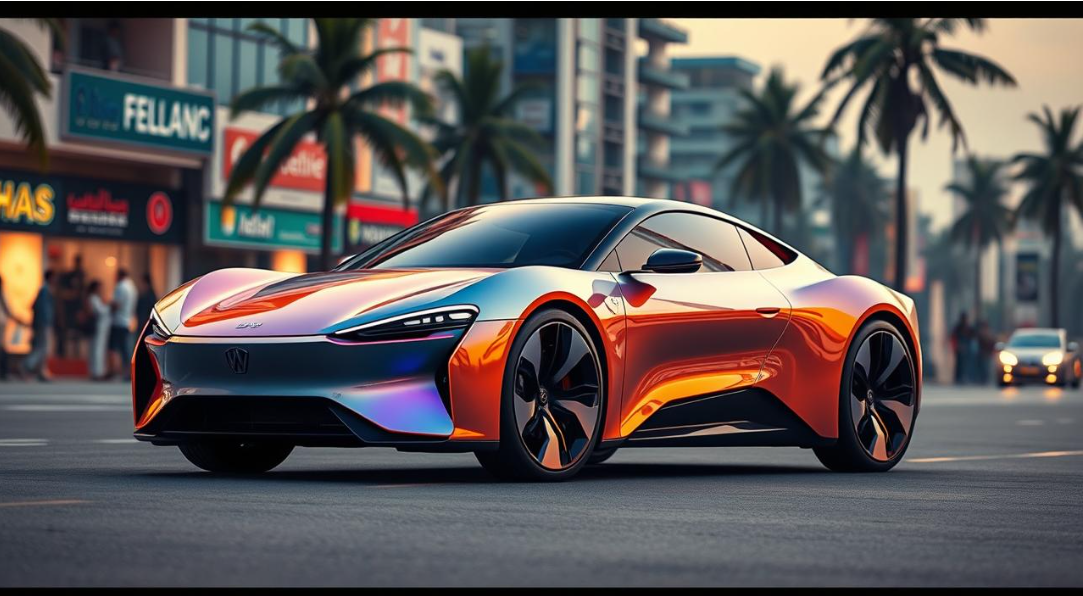
Jan
Car lovers and thrill-seekers often dream of owning a sleek, high-performance sports car. But high prices often make this dream seem unreachable. MG Motor is changing this with the Cyberster, an affordable 2-door electric sportscar.
This car promises style and substance. It’s set to be the most affordable 2-door sportscar in India. This makes owning a high-performance vehicle a reality for many.
The mg cyberster india launch is coming in March. It’s already exciting car lovers and eco-conscious consumers. The Cyberster has a cutting-edge electric powertrain and stunning design.
It’s going to be the most affordable 2-door sportscar in the country. This makes owning a high-performance vehicle a reality for many.
Key Takeaways:
- MG Motor to launch the affordable Cyberster 2-door electric sportscar in India
- Cyberster set to be the most affordable 2-door sportscar in the country
- Battery-As-A-Service (BaaS) option could bring the price down to around Rs 50 lakh
- Impressive performance and cutting-edge technology in a sleek, head-turning design
- Cyberster to be sold through MG’s new ‘Select’ premium dealerships
MG Cyberster India Launch In March, Will Be The Most Affordable 2-door Sportscar
MG Motor India is excited to launch the Cyberster, an electric sportscar, in March 2023. It will be the cheapest 2-door sportscar in India. It comes with advanced tech and a fun drive.
Impressive Performance and Electric Powertrain
The MG Cyberster for India will have a strong dual-motor setup. It’s all-wheel-drive, making it fast and stable. It goes from 0 to 100 kmph in just 3.2 seconds.
It has a 77 kWh battery pack. This gives it a range of 443 km on one charge.
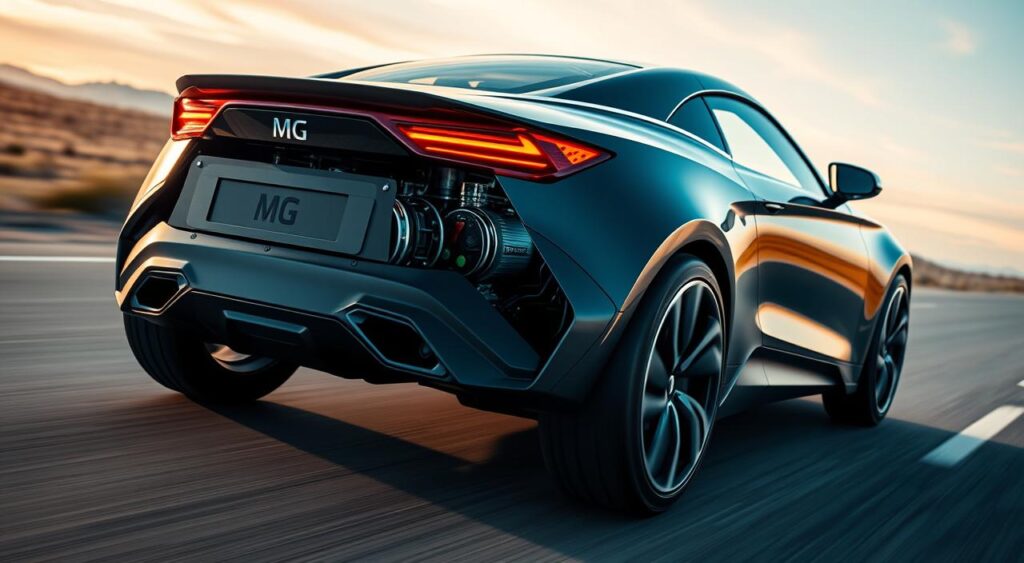
Cutting-Edge Technology and Futuristic Interior
The Cyberster’s interior is modern and matches its electric power. It has a cool 2-tone cabin theme. This makes it look sporty.
It has four screens. Two for the driver, one for entertainment, and one for climate control. These features make driving smooth and fun.
The MG Cyberster is going to change the sportscar game in India. It’s fast, has all-wheel-drive, and a cool interior. Everyone is looking forward to trying it out.
A Stunning Design That Turns Heads
The MG Cyberster is a real showstopper, grabbing attention with its sleek exterior and bold design. Its body has sharp lines that make it stand out from other sportscars.
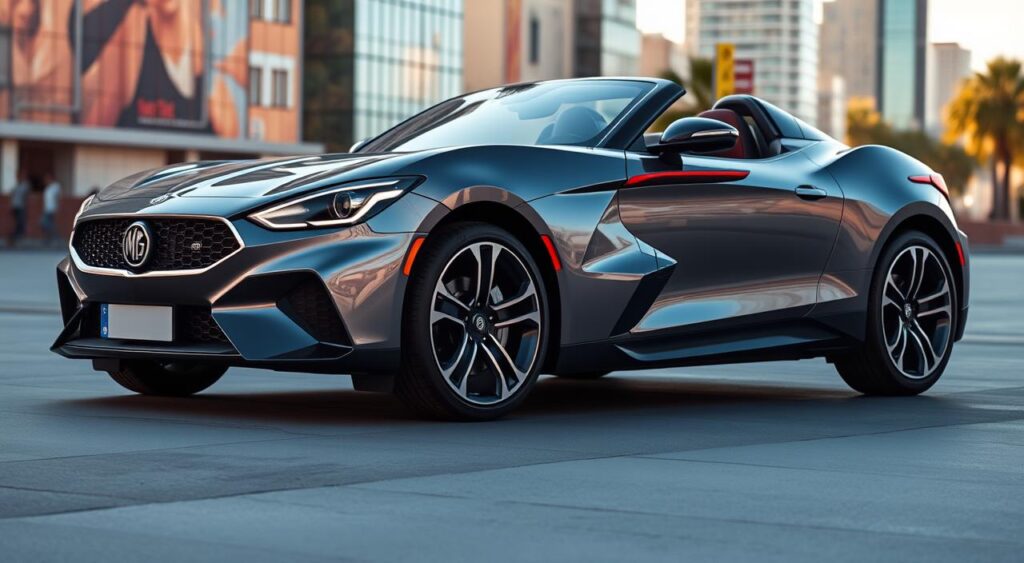
The Cyberster’s unique lighting is a standout feature. It has sweptback LED lights that look futuristic. The front is dominated by a large air dam, giving it a confident and stylish look.
Scissor Doors and Quick-Closing Fabric Rooftop
The MG Cyberster takes design inspiration from high-end supercars, with scissor doors like Lamborghinis. These doors make getting in and out easier, even in tight spots. It also has a fabric rooftop that closes in 10 seconds, switching from open-air to enclosed quickly.
| Feature | Description |
|---|---|
| Scissor Doors | Unique doors that open vertically, similar to high-end Lamborghinis |
| Quick-Closing Fabric Rooftop | Retractable rooftop that can be closed in just 10 seconds |
20-Inch Dual-Tone Alloy Wheels
The MG Cyberster rides on 20-inch alloy wheels with a dual-tone finish. These wheels look sporty and premium. They also improve the car’s handling and performance. The latest THAR ROXX performance review shows how important quality wheels are for a great drive.
At the back, the Cyberster’s design is just as impressive. It has arrow-shaped LED tail lights and an inverted U-shaped light bar. These features, along with a diffuser-like element, make the Cyberster’s look cohesive and eye-catching.
Conclusion
The upcoming mg cyberster india launch is set to change the electric sportscar game. It will be affordable and packed with cool features. Its design is both futuristic and stylish, turning heads wherever it goes.
The Cyberster’s dual-motor setup promises fast and fun driving. Its interior is like stepping into the future. Plus, the Battery-As-A-Service option makes owning an electric car easier than ever.
Car lovers and those looking to buy are excited for the Cyberster’s arrival. It’s going to shake up the Indian car market. The MG Cyberster offers a thrilling, green drive that’s also budget-friendly.
FAQ
When is the MG Cyberster launching in India?
The MG Cyberster is set to launch in India in March. It will offer a unique mix of affordability, performance, and style in the electric sportscar segment.
What makes the MG Cyberster the most affordable 2-door sportscar in India?
The Cyberster will be the most affordable 2-door sportscar in India when it launches. It will be offered with a Battery-As-A-Service (BaaS) option. This makes it significantly cheaper than the current most affordable convertible, the BMW Z4.
What is the performance of the MG Cyberster?
The India-spec Cyberster will have a dual-motor setup in an all-wheel-drive (AWD) configuration. It will produce 510 PS and 725 Nm. This allows it to go from 0 to 100 kmph in just 3.2 seconds.
What is the range of the MG Cyberster?
The Cyberster will have a 77 kWh battery pack. It claims a WLTP-claimed range of 443 km.
What are the interior features of the MG Cyberster?
The interior features a futuristic design. It has a driver-oriented dashboard and a 2-tone cabin theme. There are four screens – two for the driver’s display, one for infotainment, and another for climate control adjustments.
What are the exterior design highlights of the MG Cyberster?
The MG Cyberster boasts a striking exterior design. It has multiple sharp lines on its fascia and sweptback LED headlights. It also has a large air dam, creating a smiling front impression. Its scissor doors are a standout feature, typically seen on high-end Lamborghinis.
What type of rooftop does the MG Cyberster have?
The Cyberster comes with a quick-closing fabric rooftop. It can be closed in just 10 seconds.
What size are the alloy wheels on the MG Cyberster?
The Cyberster rides on 20-inch dual-tone alloy wheels. It has an aggressive rear design with arrow-shaped LED tail lights. It also features an inverted U-shaped light bar and a diffuser-like element.
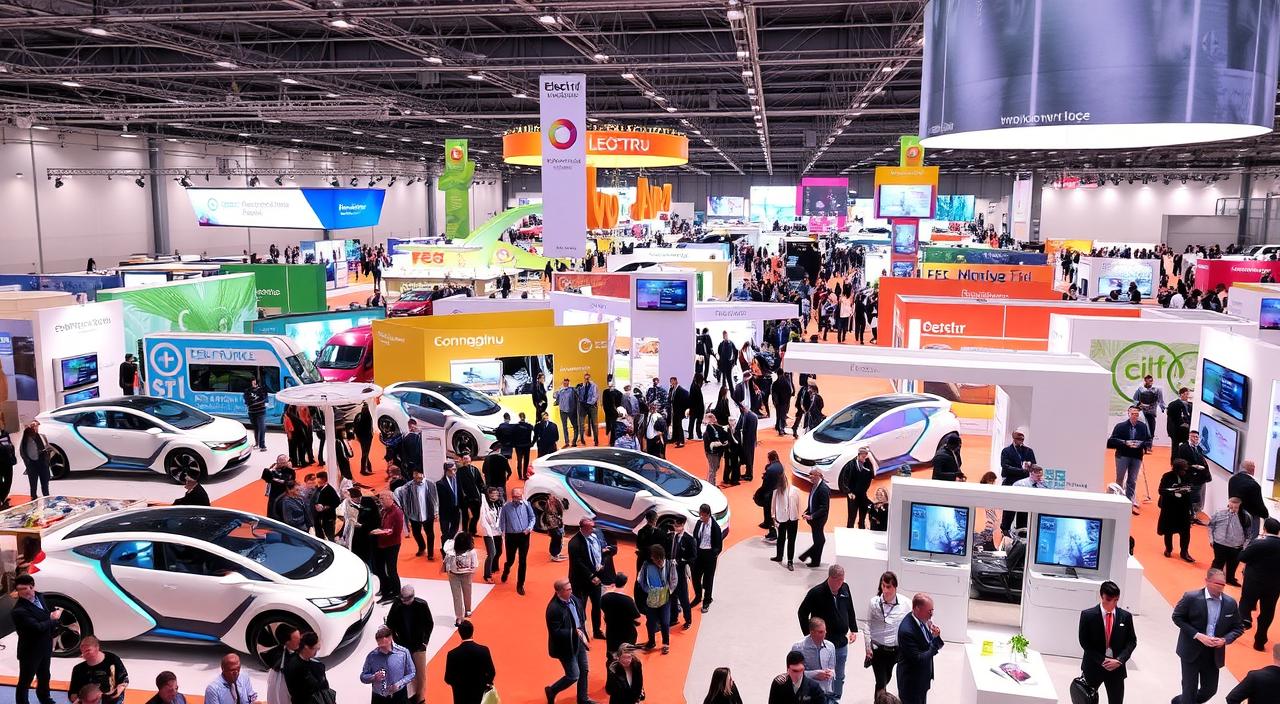
Jan
As the Bharat Mobility Expo 2025 ends, we wonder: how will the latest mobility tech change India’s car industry? The expo, a top spot for new car tech, drew over 8 lakh visitors and 1,500 exhibitors. With new electric cars and cool solutions, it’s been a huge hit. It shows India is a big name in the car world.
Key Takeaways
- The Bharat Mobility Expo 2025 is now the world’s biggest auto show, beating all records.
- Startups, big car makers, and young business folks showed off their latest car tech.
- Visitors saw the latest in electric cars, self-driving tech, and green transport.
- Leaders talked about the future of cars and India’s role at the conference.
- Days 5-6 were a huge success, with 8 lakh visitors and 1,500 exhibitors.
- It proved India is a key player in the car world, focusing on new tech and green transport.
- The event showed how important the conference is for the car industry’s future.
Day 5-6 Overview at Bharat Mobility Expo 2025
The Bharat Mobility Expo 2025 saw a big jump in visitors on days 5-6. Over 800,000 people from all over the world came to see it. This shows how much people are interested in the future of transportation and automotive innovations.
More than 1,500 exhibitors were there, showing off the latest in their field. The mobility solutions event also introduced over 200 new products. This included the e-Vitara, Maruti Suzuki’s first electric vehicle.
This launch is a big step towards India’s goal of having 30% electric vehicles by 2030. The expo also had exhibits from global companies like BYD from China and VinFast from Vietnam. They showed off their cutting-edge automotive technologies.
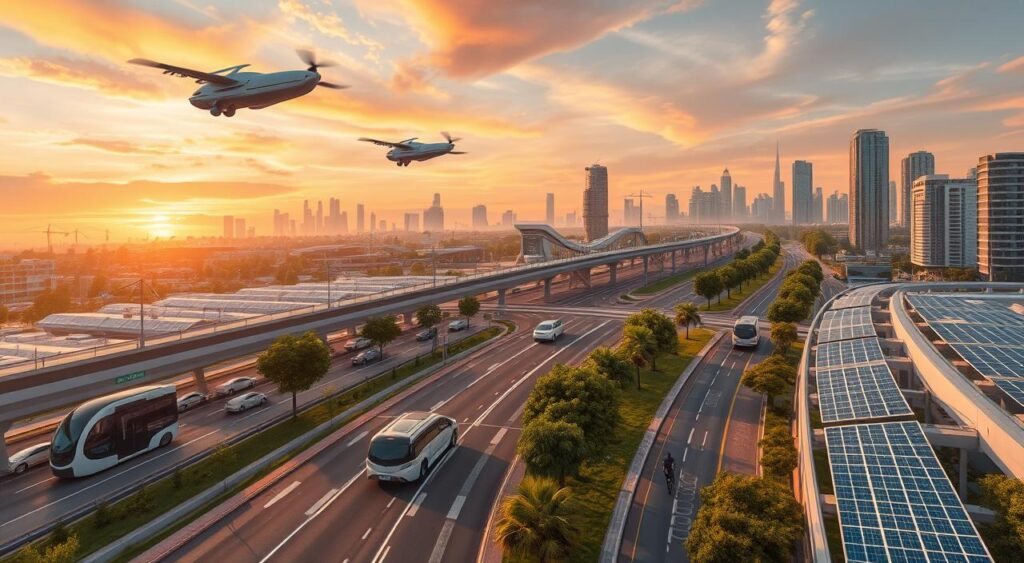
- Over 90 different vehicle types were introduced at the expo.
- 80 auto components were presented by various manufacturers.
- The event highlighted contributions from countries such as Germany, the UK, South Korea, Japan, and Mexico, showing their innovative automotive technologies.
The Bharat Mobility Expo 2025 is key for India’s move to electric vehicles and green transport. It shows the electric vehicle market in India is growing fast. It’s expected to hit over USD 150 billion by 2030.
Revolutionary Electric Vehicle Launches
The Bharat Mobility Expo 2025 showcased many new electric vehicles. These cars are expected to change the car industry a lot. The sustainable transportation showcase included the Maruti Suzuki e-Vitara, Hyundai Creta Electric, and Tata Sierra. They are the latest next-gen vehicles that will make a big impact.
Experts say these new cars will help India reach its goal of 30% electric vehicles by 2030. The expo was a chance for car makers to show off their newest models. They focused on sustainable transportation and new tech.
Some key features of these new cars are:
- Advanced battery technology
- Improved range and efficiency
- Enhanced safety features
- Stylish and modern designs
The next-gen vehicles at the expo will shape India’s car future. They focus on sustainable transportation showcase and industry expert talks.
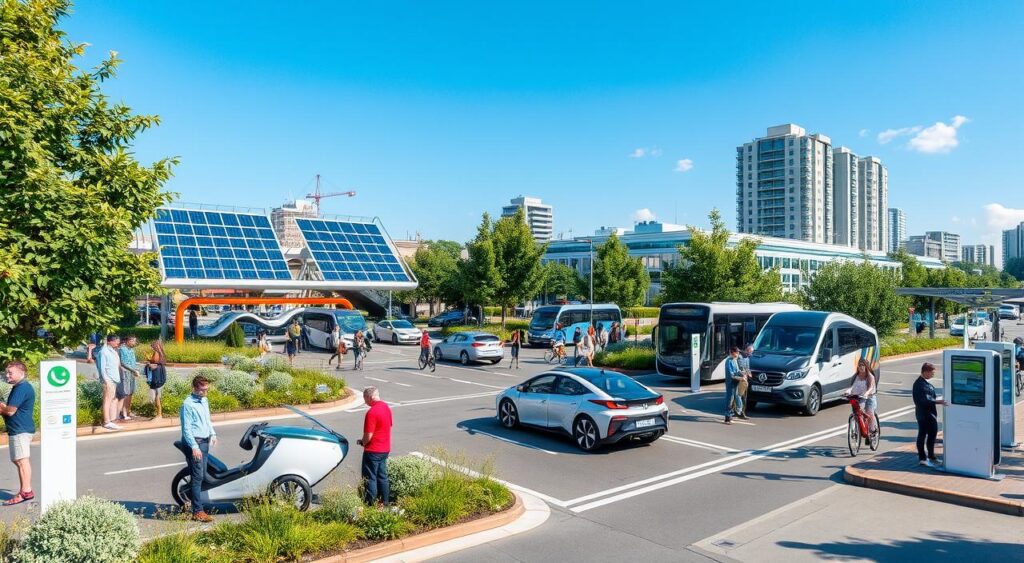
Next-Generation Autonomous Technology Showcase
The Bharat Mobility Expo 2025 showcased the latest in autonomous technology. This tech is set to change the car industry a lot. It’s all about making roads safer, cutting down on traffic jams, and making driving better.
Highlights included self-driving innovations like better sensors and smart learning. These are big steps forward, thanks to new tech. The expo also showed how AI can make traffic smoother and cars safer.
Self-Driving Innovations
Self-driving tech is a big deal in the new cars. It uses cool tech like lidar and radar to help cars move around. At the expo, we saw cars with these systems and how they work.
AI Integration in Mobility
AI is also key in new cars. It helps make traffic flow better, keeps cars safe, and makes driving nicer. The expo showed how AI can predict traffic and make roads safer.
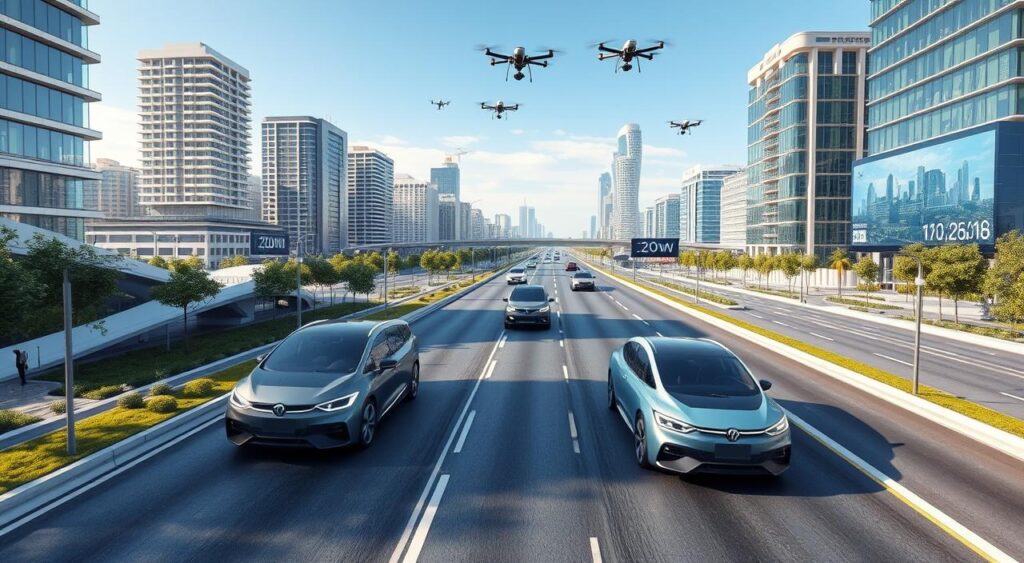
Safety Feature Demonstrations
The expo also showed off safety features. Things like emergency brakes and lane warning systems were on display. These features aim to make roads safer and cut down on accidents.
Sustainable Transportation Solutions
The Bharat Mobility Expo 2025 showcased sustainable transportation solutions. It focused on cutting down carbon emissions and boosting eco-friendly travel. The event highlighted electric, hybrid, and alternative fuel vehicles. These are key to India’s sustainable future.
The sustainable transportation solutions included the X Platform 3.0. It boosts torque by 25 percent and performance. The Advanced Predictive AI ensures vehicles run 100 percent of the time. These launches aim to make electric vehicles a daily necessity.
The mobility solutions event also saw big investments in electric vehicles. JSW Group pledged INR 3,000 billion to sustainable transportation solutions. This move is expected to create many jobs in Maharashtra and improve industrial sustainability. As transportation evolves, sustainable transportation solutions will be essential for India’s future.
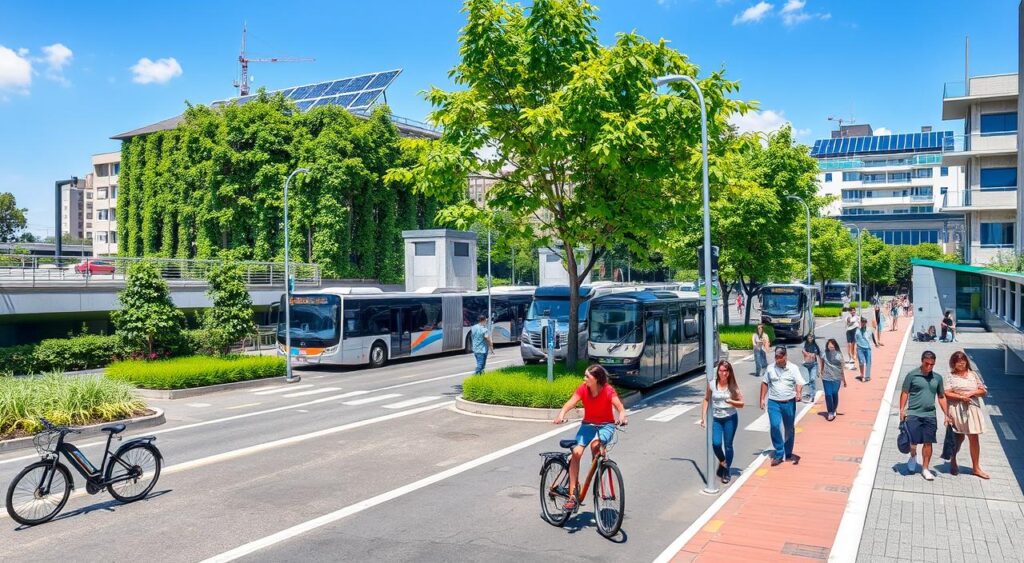
Here are some key stats on sustainable transportation solutions in India:
- 25 percent increase in torque and overall performance with the introduction of the Thrill Mode feature on the X Platform 3.0
- 100 percent vehicle uptime through the Advanced Predictive AI feature
- INR 3,000 billion investment in sustainable transportation solutions by JSW Group
These developments show India’s growing focus on sustainable transportation solutions. They underline the role of mobility solutions events in promoting green travel and shaping the future of transportation.
Industry Leaders’ Keynote Addresses
The Bharat Mobility Expo 2025 featured many industry leaders sharing their insights. They talked about mobility trends and insights for the future. They stressed the need for teamwork, new ideas, and green growth in cars.
During their industry expert talks, they pointed out the need for a strong policy to help the mobility sector grow. They also talked about new global partnerships to support green transport and cut down on carbon emissions.
Some of the main points from their talks were:
- They talked about how important electric cars and other fuel options are.
- They discussed how self-driving tech will change the future of travel.
- They shared news about new investments in roads and transport systems.
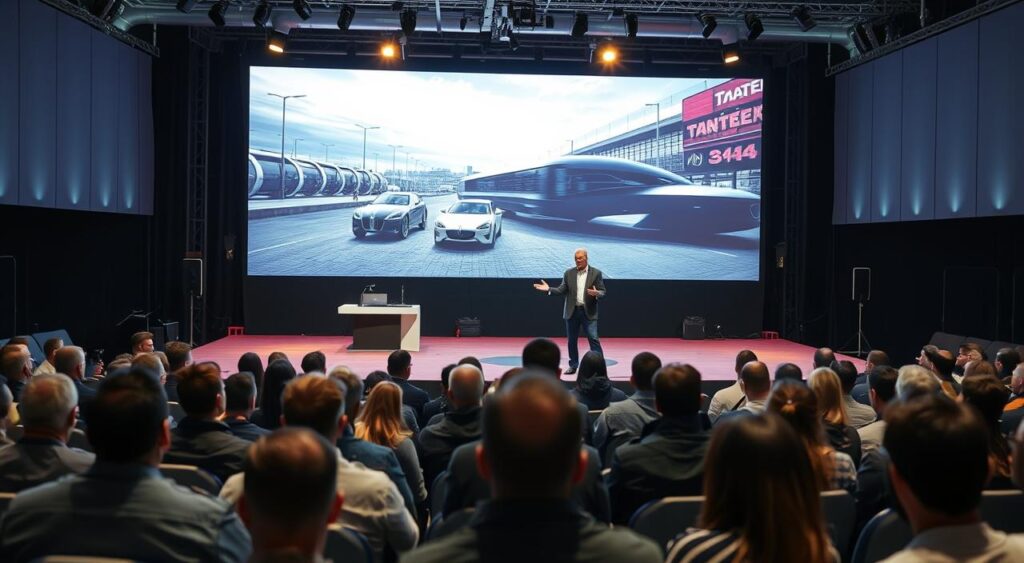
The Bharat Mobility Expo 2025 gave leaders a chance to share their views on the future of travel. They showed off the newest tech and ideas in transport. This showed how we can have greener and more efficient ways to get around.
| Topic | Key Takeaways |
|---|---|
| Electric Vehicles | Importance of electric vehicles in reducing carbon emissions |
| Autonomous Technology | Role of autonomous technology in shaping the future of mobility |
| Sustainable Transportation | Need for a strong policy to support green transport solutions |
Innovation Zone Highlights
The Bharat Mobility Expo 2025 had an innovation zone. It showed off automotive innovations like electric, hybrid, and alternative fuel vehicles. These new technologies aim to make roads safer, reduce traffic, and improve driving.
The mobility solutions event let companies display their latest tech. It focused on green and sustainable solutions. Over 90 new products were showcased, showing a lot of innovation in mobility.
Some big highlights from the innovation zone were:
- Electric vehicles with advanced battery tech
- Hybrid vehicles that use fuel more efficiently
- Alternative fuel vehicles, like hydrogen fuel cell cars
These latest mobility technology advancements will greatly influence the future of cars.

Start-up Pavilion Breakthroughs
The Bharat Mobility Expo 2025 had a start-up pavilion. It showed off new technologies and innovations. This gave attendees mobility trends and insights.
This pavilion was a center for automotive innovations. Start-ups shared their newest solutions and products.
Highlights from the pavilion included latest mobility technology demos, investment news, and awards for start-ups. These breakthroughs will shape the future of cars. They focus on being green and innovative.
Key takeaways from the pavilion are:
- Emerging technology presentations that showcased the latest advancements in mobility
- Investment announcements that highlighted the growing interest in start-ups and their innovative solutions
- Notable start-up awards that recognized the most promising and innovative start-ups in the industry
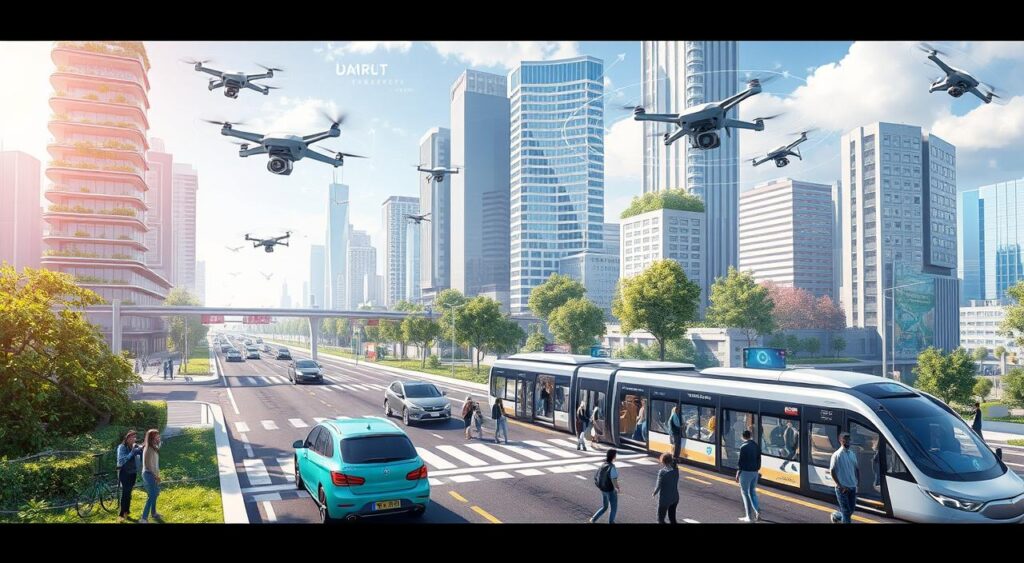
Public Transportation Revolution
The Bharat Mobility Expo 2025 highlighted the need for public transportation. It’s key to cutting down traffic and boosting sustainable transportation solutions. The event showed off electric, hybrid, and alternative fuel buses.
These options are vital for India’s aim to cut carbon emissions and support green growth. The mobility solutions event unveiled new public transport tech. It showed how the future of transportation could be greener, more efficient, and open to all.
Some standout features at the expo included:
- Electric buses with zero emissions
- Hybrid buses with lower emissions
- Alternative fuel buses with cheaper running costs
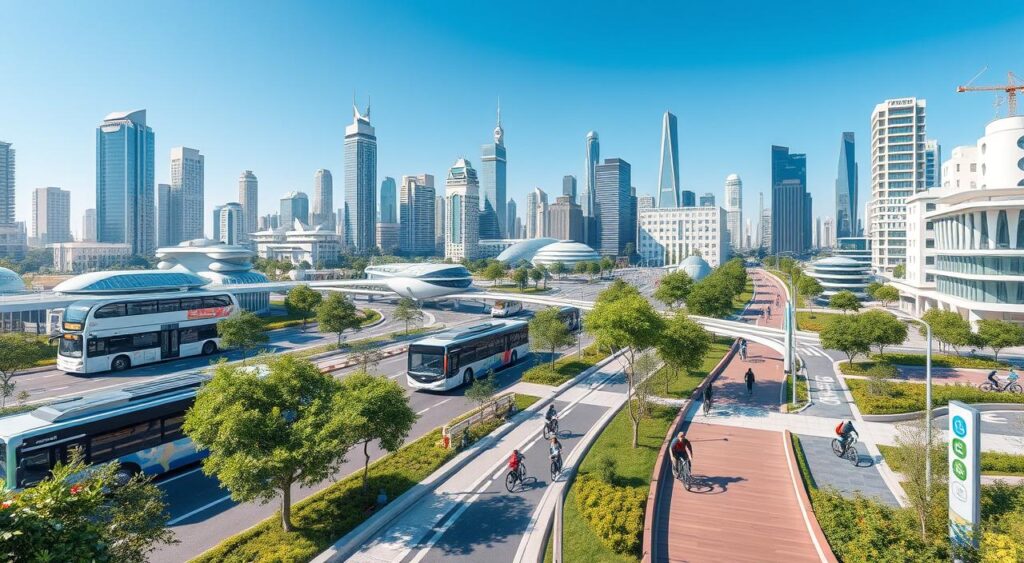
The expo showed that the future of transportation will rely on sustainable transportation solutions. Events like the Bharat Mobility Expo 2025 are key. They let innovators and leaders share their work and work together on a greener, better transport system.
Conclusion: Shaping India’s Mobility Future
The Bharat Mobility Expo 2025 was a huge success. It showed off the newest automotive innovations and mobility trends and insights. These will change how we move around in India.
With fast growth and more cities, India needs better ways to get around. The expo showed how electric cars, self-driving tech, and better public transport will change our cities.
This event will help make decisions for India’s future roads. The focus is on new ideas, being green, and what people want. The car industry is ready to help India become more connected, efficient, and kind to our planet.
FAQ
What was the key highlight of the Bharat Mobility Expo 2025?
The Bharat Mobility Expo 2025 was a record-breaker. It became the world’s largest auto show, beating the US Auto Expo’s record. Startups, big automakers, and young entrepreneurs showed off their latest car tech.
What was the attendance and exhibitor count for the Bharat Mobility Expo 2025?
The event drew over 8 lakh visitors and had 1,500 exhibitors. These numbers made it a huge success.
What were the major highlights of the event during days 5-6?
Days 5-6 saw a big jump in visitors from all over. The floor was filled with new cars, green transport, and the latest car tech.
What were some of the notable electric vehicle launches at the expo?
The expo introduced many new electric cars. The Maruti Suzuki e-Vitara, Hyundai Creta Electric, and Tata Sierra were among them. These cars are key to India’s goal of 30% EVs by 2030.
What were the key highlights of the autonomous technology showcase?
The expo showed off the latest in self-driving tech. It included AI in cars and safety demos. These advancements aim to make roads safer and reduce traffic.
How did the expo emphasize the importance of sustainable transportation solutions?
The expo focused on green cars like electric, hybrid, and alternative fuel vehicles. These are vital for India’s goal of cutting carbon emissions and sustainable growth.
What were the key takeaways from the industry leaders’ keynote addresses?
Industry leaders shared insights on the future of cars. They talked about policies and global partnerships. Their talks stressed the need for teamwork, innovation, and green growth in the car world.
What were the highlights of the innovation zone and start-up pavilion?
The innovation zone showcased the latest in car tech, including electric and hybrid cars. The start-up pavilion featured new startups, investment news, and awards. These are expected to shape the car industry’s future.
How did the expo emphasize the importance of public transportation solutions?
The expo highlighted the need for green buses. It showed electric, hybrid, and alternative fuel buses. These are key to India’s goal of cutting emissions and promoting green growth.

Jan
Have you seen the amazing changes in cars at the Bharat Mobility Global Auto Expo 2025? Days three and four showed off cool electric cars and green transport options. These are going to change the Indian market a lot.
The expo was a showcase of new ideas and tech. Big car companies and new players shared their plans for the future. They focused on solutions that meet India’s special needs and likes.
The car world is moving fast to electric and green cars. The Bharat Mobility Global Auto Expo 2025 was where companies showed they care about the planet and new tech.
Key Takeaways
- Major automakers unveiled new electric vehicle models tailored for the Indian market
- Collaborations and partnerships formed to accelerate the adoption of sustainable transportation solutions
- Innovative concepts and prototypes showcased the future of mobility in India
- Emphasis on affordable and accessible electric vehicles for mass adoption
- Focus on developing robust charging infrastructure and ecosystem support
VinFast Makes Grand Entry into Indian Market
The Bharat Mobility Global Auto Expo 2025 saw a big debut by Vietnamese automaker VinFast. They showed off their VF 7 and VF 6 models made just for India. VinFast plans to grab a big share of the market with their prices.
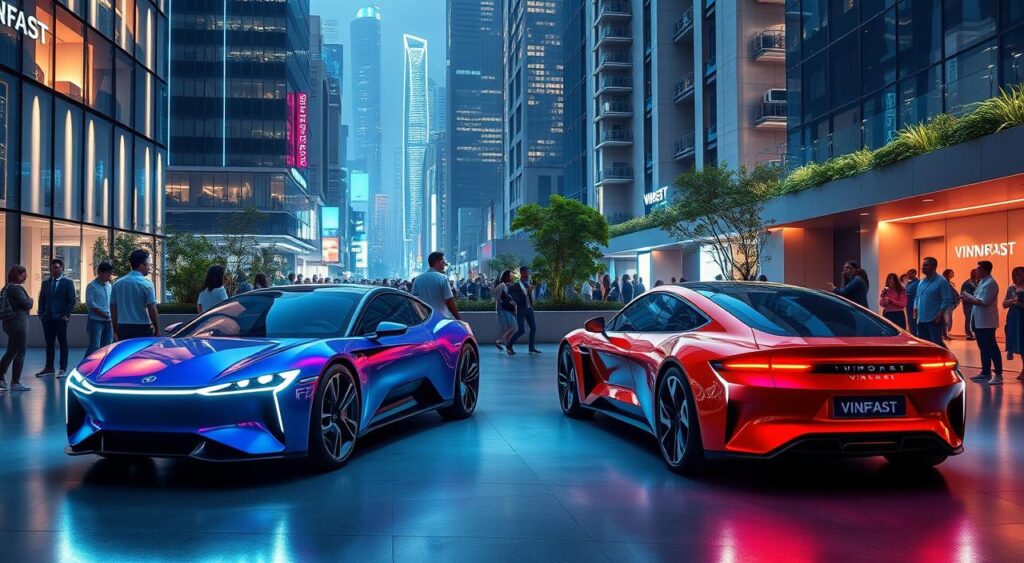
VF 7 and VF 6 Models Tailored for India
VinFast is starting in India with the VF 7 and VF 6. These cars are made to fit what Indian buyers want. They mix style, performance, and good prices, appealing to many.
The VF 7 is a modern SUV with lots of room for families and great fuel use. The VF 6 is a small crossover perfect for city driving. Both have the latest tech and features for a great drive.
Aggressive Pricing Strategy to Capture Market Share
VinFast is pricing the VF 7 and VF 6 low to make a big splash in India. They want to draw in lots of customers and become a big name in India’s car market.
By setting prices that challenge the competition, VinFast hopes to shake things up. They’re also giving good deals and financing options. This way, they aim to reach many Indian buyers, from new ones to those looking to change cars.
BYD India Unveils Sealion 7 eSUV and New Booking Offers
BYD India made a big splash at the Bharat Mobility Global Auto Expo 2025. They unveiled the Sealion 7 eSUV, a fully electric vehicle. This move shows BYD’s commitment to growing in India’s EV market.
The Sealion 7 eSUV has many cool features:
- It has a big interior that can seat up to seven people.
- It uses advanced battery tech for a long driving range.
- It comes with a top-notch infotainment system and a large touchscreen.
- It also has a regenerative braking system to save energy.
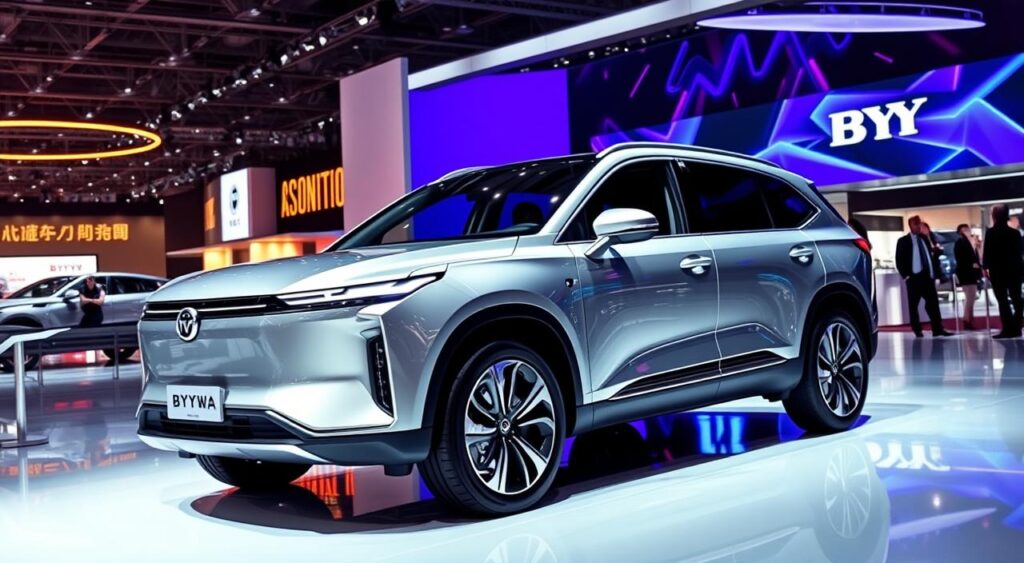
BYD India is making it easy for people to buy the Sealion 7 eSUV. You can reserve it with a ₹25,000 deposit. Deliveries will start in the fourth quarter of 2025.
The Sealion 7 eSUV comes in three trim levels. Each offers different features and prices:
| Trim Level | Battery Capacity | Range (ARAI Certified) | Starting Price |
|---|---|---|---|
| Standard | 60 kWh | 400 km | ₹25.99 Lakh |
| Premium | 75 kWh | 500 km | ₹29.99 Lakh |
| Luxury | 90 kWh | 600 km | ₹34.99 Lakh |
BYD India is excited to launch the Sealion 7 eSUV. They hope to grab a big part of India’s EV market. Their focus on innovation, green tech, and making customers happy makes them a strong player in electric cars in India.
Hyundai and TVS Partner for Advanced Electric Three-Wheelers
Hyundai Motor India and TVS Motor Company have teamed up to create advanced electric three-wheelers. They aim to change how people move around in India. This is by making transportation more efficient and green.
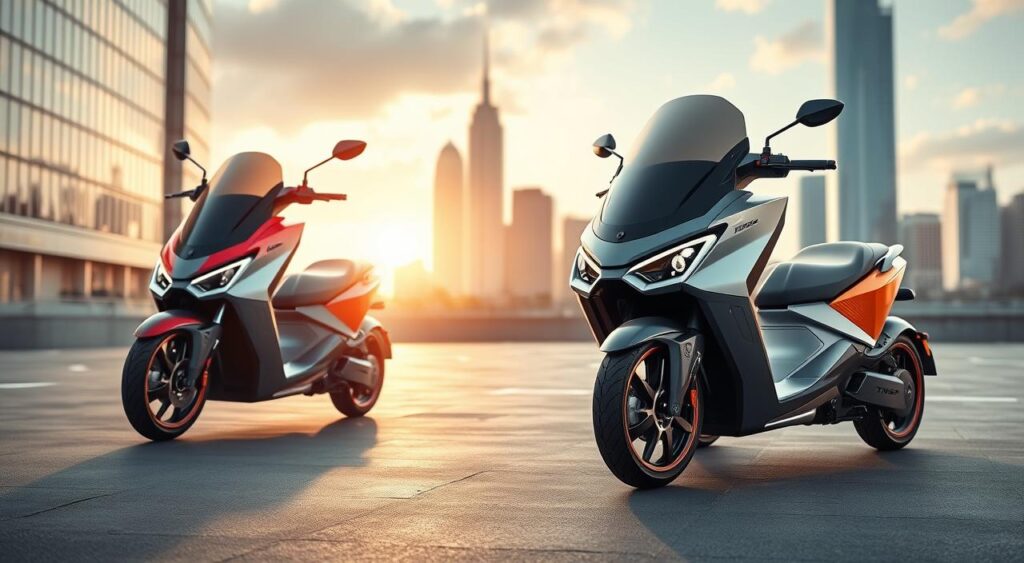
Collaboration Aims to Revolutionize Last-Mile Mobility
Hyundai and TVS are working together. Hyundai knows a lot about electric cars. TVS is great at making three-wheelers. They want to make electric three-wheelers that are fast, go far, and are reliable.
Their goals are:
- Make better electric powertrains for three-wheelers
- Improve battery tech for longer range and quicker charging
- Add smart features and connectivity
- Make electric three-wheelers affordable
Prototypes Showcased at Auto Expo
At the Bharat Mobility Global Auto Expo 2025, Hyundai and TVS showed off their electric three-wheeler prototypes. These vehicles had cool designs, new battery tech, and smart features.
| Model | Range (km) | Charging Time (hours) | Payload Capacity (kg) |
|---|---|---|---|
| Hyundai E3W-1 | 120 | 4 | 500 |
| TVS iQube Cargo | 100 | 3 | 450 |
The prototypes showed Hyundai and TVS’s dedication to making top-notch electric three-wheelers. With more people needing ways to get around, their partnership could really change the Indian market.
BMW Group India Showcases Luxury and Performance
At the Bharat Mobility Global Auto Expo 2025, BMW Group India wowed everyone with its luxury cars and high-performance bikes. The German car maker’s booth was a hit, attracting many who wanted to see the latest from BMW.
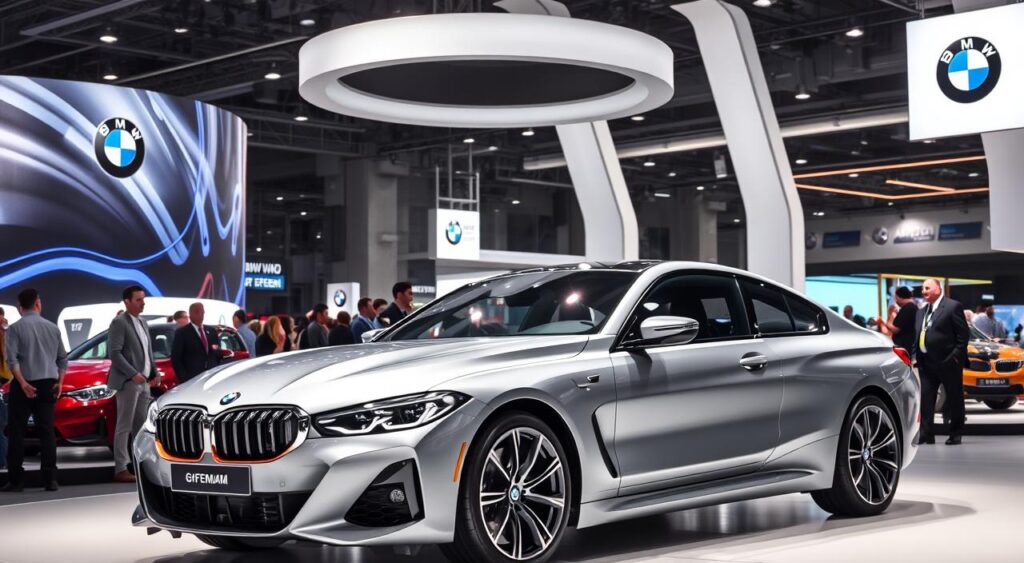
New Mini Cooper S John Cooper Works Pack Unveiled
The BMW Group India booth was buzzing with excitement over the new Mini Cooper S with the John Cooper Works Pack. This sporty car mixes the classic Mini look with better performance. It’s perfect for those who love driving fast and feeling the thrill.
The John Cooper Works Pack adds:
- Upgraded suspension for better handling
- High-performance brakes for stronger stopping
- Unique styling, like a rear spoiler and special alloy wheels
S 1000 RR Motorcycle Steals the Show
The Mini Cooper S got attention, but the S 1000 RR motorcycle was the real star at the BMW Group India booth. This bike is known for its amazing speed and tech. It drew in bike fans from all over the expo.
Key features of the S 1000 RR include:
- A powerful 999cc inline-four engine making over 200 horsepower
- A lightweight frame and sleek design for top performance
- Advanced tech with various riding modes and traction control
At the BMW Group India booth, visitors could see the S 1000 RR up close. They learned about its advanced tech and design inspired by the track.
JBM Electric and Eka Mobility Introduce Electric Buses and Platforms
At the Bharat Mobility Global Auto Expo 2025, JBM Electric and Eka Mobility made a big splash. They showed off their electric buses and platforms. These product launches highlight the need for green transport in India’s fast-changing car world.
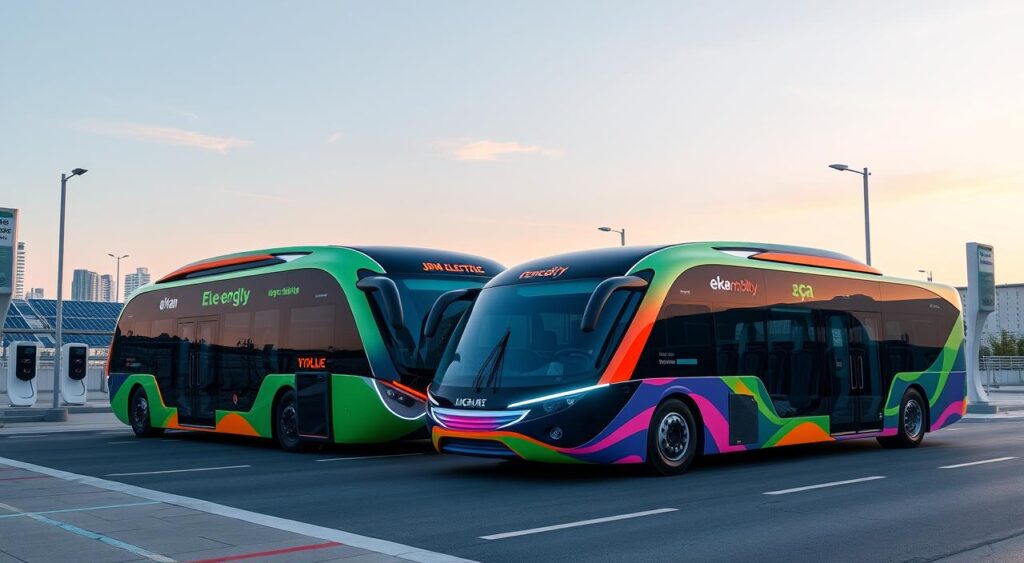
JBM Electric introduced their newest electric buses. They’re made for city and long-distance travel. The buses have:
- High-capacity lithium-ion batteries
- Regenerative braking systems
- Intelligent fleet management solutions
Eka Mobility, a newcomer in electric bus market, made a big impression. They launched their electric bus platform. It’s designed to be flexible for different uses, from short trips to long journeys. Eka Mobility’s buses have:
- Fast charging capabilities
- Spacious interiors with ergonomic seating
- Advanced driver assistance systems (ADAS)
Both JBM Electric and Eka Mobility are set to change public transport in India. They focus on green and efficient travel. This matches the government’s goal to cut carbon emissions and support sustainable growth.
Tata Motors Displays Wide Range of EVs Across Segments
Tata Motors, a leading Indian automaker, showcased an impressive lineup of electric vehicles (EVs) at the Bharat Mobility Global Auto Expo 2025. The company’s display covered a wide range of segments, catering to various customer needs and preferences.
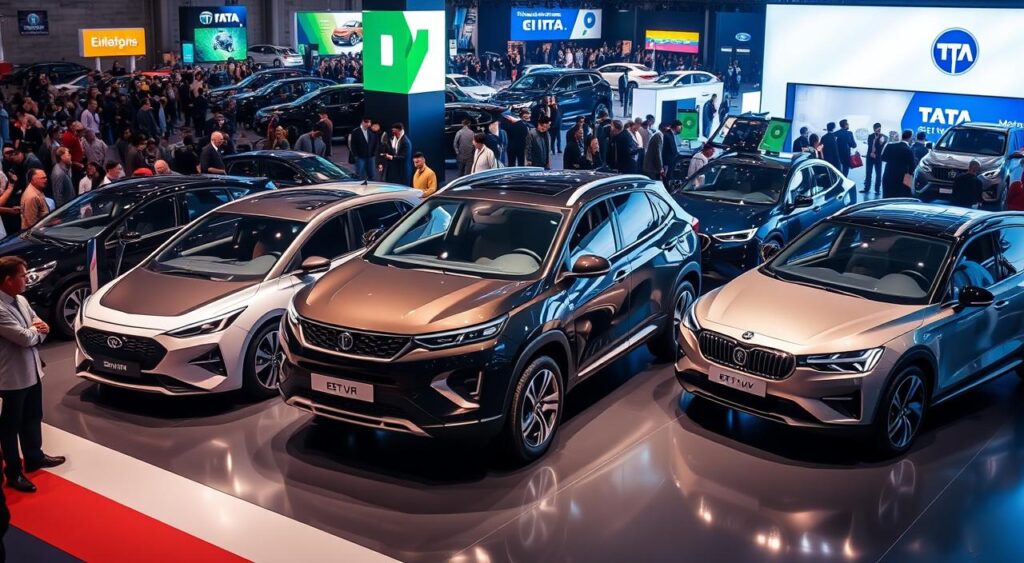
The Nexon EV Max and Tigor EV were highlights, drawing a lot of attention. These models offer practical and affordable electric mobility solutions for the Indian market.
Nexon EV Max and Tigor EV Attract Visitors
The Nexon EV Max is an enhanced version of the popular Nexon EV. It has an extended range and improved performance. Its stylish design and advanced features earned praise from attendees.
The Tigor EV is a compact and efficient option for city commuters. It has attractive pricing and low running costs.
| Model | Range (km) | Battery Capacity (kWh) | Charging Time (0-80%) |
|---|---|---|---|
| Nexon EV Max | 437 | 40.5 | 56 min (fast charging) |
| Tigor EV | 306 | 26 | 65 min (fast charging) |
Altroz EV and Sierra EV Concepts Generate Buzz
Tata Motors also showcased two exciting EV concepts: the Altroz EV and the Sierra EV. The Altroz EV is based on the popular premium hatchback. It promises a thrilling driving experience with its powerful electric powertrain.
The Sierra EV is a modern interpretation of the iconic Tata Sierra. It combines retro styling with cutting-edge EV technology. This hints at the company’s future design language for electric vehicles.
These concepts generated significant buzz among visitors. They were eager to see Tata Motors’ vision for the future of electric mobility in India. With its strong commitment to EVs and a diverse portfolio of offerings, Tata Motors is well-positioned to capitalize on the growing demand for electric vehicles in the country.
Maruti Suzuki Showcases Future Mobility Solutions
At the Bharat Mobility Global Auto Expo 2025, Maruti Suzuki showed off its vision for future mobility. They highlighted cutting-edge technology advancements and green transportation solutions for India. Their pavilion drew lots of visitors eager to see the latest in cars.
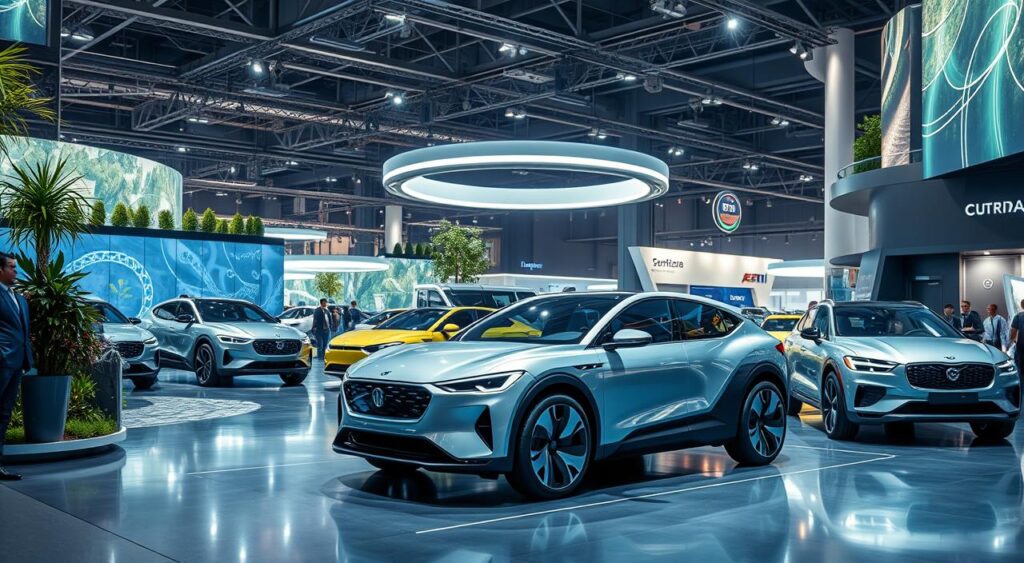
Maruti Suzuki unveiled concept vehicles and advanced tech. These promise to change the future of driving in India. Key features include electric and hybrid cars, smart driver aids, and connected car tech for safety and ease.
Maruti Suzuki’s work on self-driving cars was a big hit. They showed off Level 2+ tech with features like adaptive cruise control and automatic emergency braking. These aim to make driving safer in India.
Maruti Suzuki also talked up its electric car plans. They showed off electric cars for different needs, like city driving and long trips.
- A compact city car for urban commuters
- A mid-size SUV for longer trips
- A premium sedan with luxury and tech
Maruti Suzuki also showed off their latest in car tech. Their SmartPlay Studio infotainment system got lots of attention. It has a big screen, voice commands, and connects to phones.
Maruti Suzuki’s focus on future mobility shows they’re leading in car tech. With a strong brand and knowledge of India, they’re set to shape the future of driving here.
| Technology | Key Features |
|---|---|
| Autonomous Driving | Level 2+ capabilities, adaptive cruise control, lane keeping assist, automatic emergency braking |
| Electric Vehicles | Compact city car, mid-size SUV, premium sedan with advanced features |
| Connected Car | Next-gen SmartPlay Studio infotainment system, large touchscreen, voice commands, smartphone integration |
Hero MotoCorp Unveils Electric Two-Wheeler Prototypes
Hero MotoCorp, India’s largest two-wheeler maker, made a big splash at the Bharat Mobility Global Auto Expo 2025. They showed off a range of electric two-wheeler prototypes. This move shows their dedication to the growing electric vehicle market in India, with cool designs for scooters and motorcycles.
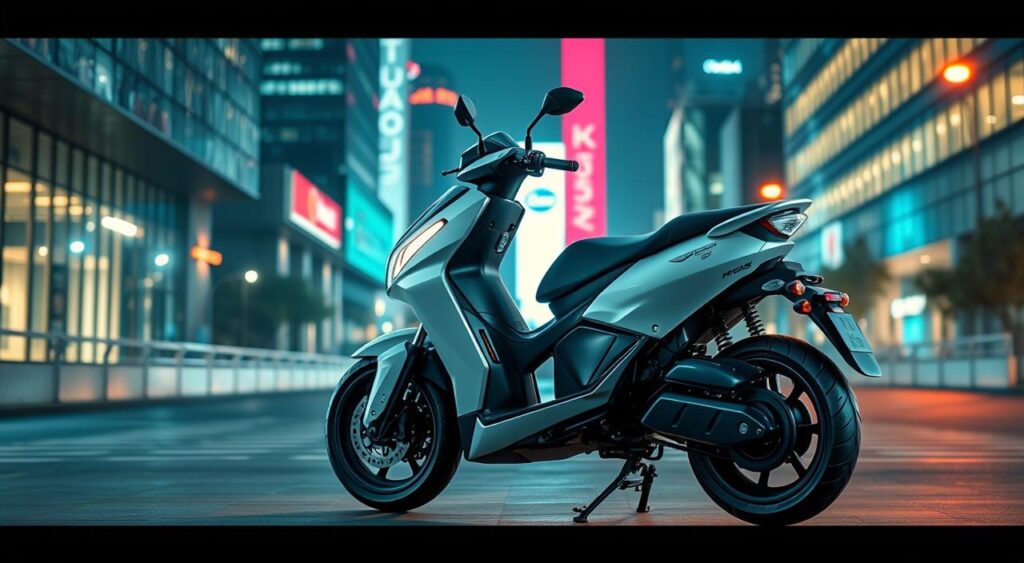
At the Hero MotoCorp pavilion, visitors saw the company’s future electric mobility plans. They saw sleek electric scooters for city rides. These scooters had modern looks, smart tech, and great performance.
New Electric Scooter and Motorcycle Designs Revealed
Hero MotoCorp also showed off electric motorcycle concepts. These bikes had bold looks, the latest tech, and lots of power. They’re for those who love the thrill of riding but want to go electric.
The specs of Hero MotoCorp’s electric two-wheeler prototypes are impressive:
| Model | Type | Range (km) | Top Speed (km/h) | Charging Time |
|---|---|---|---|---|
| Hero Electra | Scooter | 80 | 80 | 4 hours |
| Hero Pulse | Scooter | 100 | 90 | 3 hours |
| Hero Spark | Motorcycle | 120 | 110 | 2.5 hours |
| Hero Charge | Motorcycle | 150 | 130 | 2 hours |
Hero MotoCorp’s move into electric two-wheelers is a big deal for the company and India’s car industry. With its strong brand and wide dealership network, Hero MotoCorp is ready to make a big splash in electric scooters and motorcycles.
As more people want green transport, Hero MotoCorp’s electric two-wheelers show what’s coming. Their focus on new ideas and green tech will change India’s two-wheeler market soon.
Mahindra Highlights EV Portfolio and Autonomous Technology
Mahindra, a top car maker in India, showed off its EVs and new tech at the Bharat Mobility Global Auto Expo 2025. Many people came to see Mahindra’s latest electric cars.
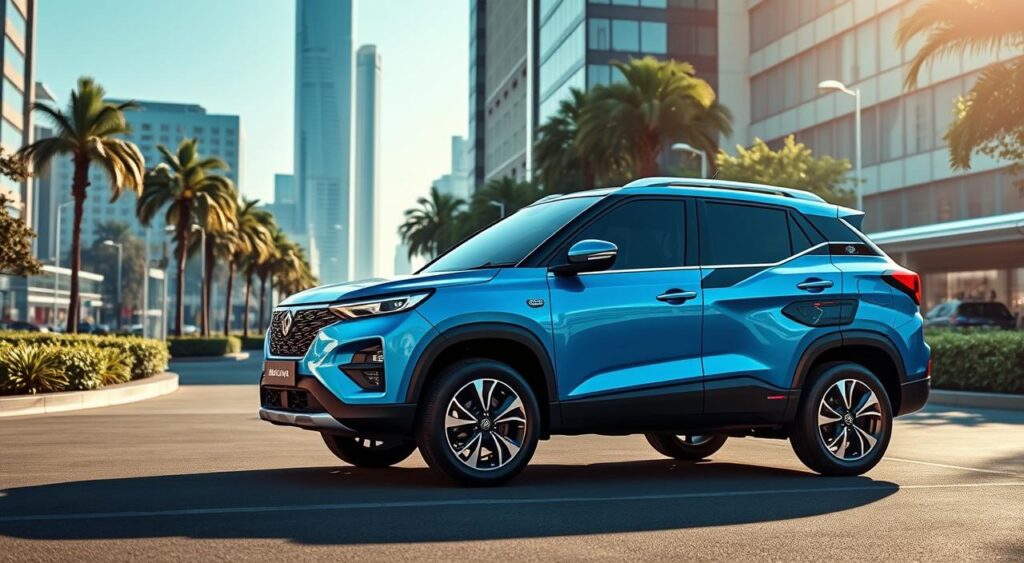
The XUV400 EV and eKUV100 were big hits. The XUV400 EV is an electric SUV with a cool design and great speed:
| Specification | Value |
|---|---|
| Range | Up to 375 km on a single charge |
| Acceleration | 0-100 km/h in under 8 seconds |
| Charging Time | 0-80% in 50 minutes with fast charging |
The eKUV100, an electric version of the KUV100, was also popular. It’s good for city driving and is easy on the wallet.
Autonomous Technology Takes Center Stage
Mahindra also highlighted its work on self-driving cars. People got to see how Mahindra’s tech works:
- Advanced driver assistance features
- Self-parking capabilities
- Level 2 autonomous driving on highways
Mahindra wants to make driving safer, easier, and more efficient with its tech.
At the Auto Expo, Mahindra showed it’s a big name in India’s EV and self-driving car world. Its new cars and tech will help shape the future of driving in India.
Bharat Mobility Global Auto Expo 2025 Day 3-4 Highlights
The third and fourth days of the Bharat Mobility Global Auto Expo 2025 were filled with excitement. Many EV launches and concept unveilings were the main attractions. The event showed the industry’s dedication to green transportation, with companies from around the world presenting their latest models.
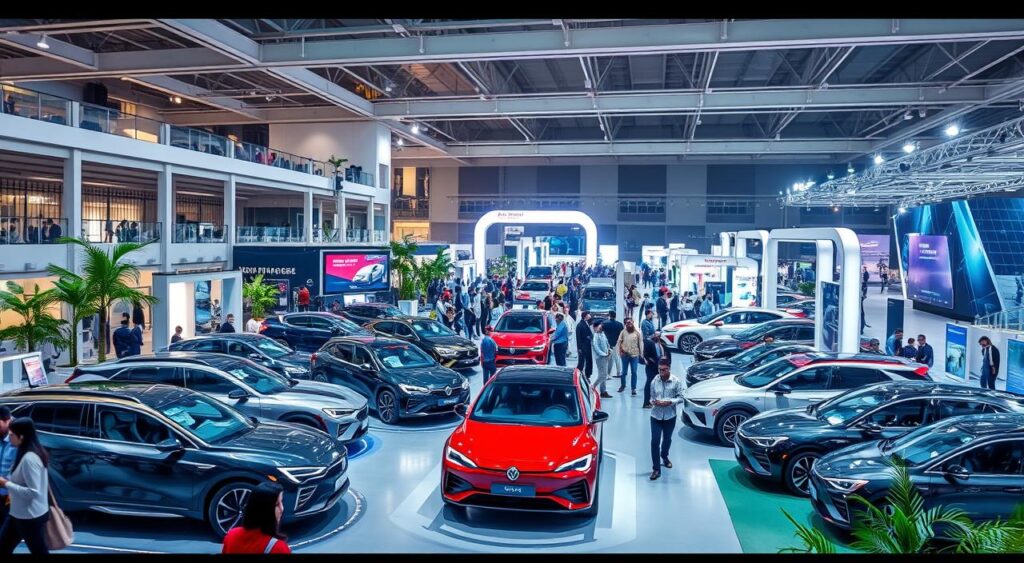
Surge in EV Launches and Concepts
The expo saw a big increase in EV launches and concepts. Both big names and newcomers were trying to grab attention. The variety of EVs, from electric sedans to SUVs, was amazing. Some of the top launches were:
- VinFast’s VF 7 and VF 6 models, made for the Indian market
- BYD India’s Sealion 7 eSUV, known for its long range and tech
- Tata Motors’ big EV lineup, including the Nexon EV Max, Tigor EV, and Altroz EV and Sierra EV concepts
Focus on Sustainable Transportation Solutions
The event also focused on green transportation. Companies showed their work to cut down on carbon emissions and make energy use better. They displayed new battery tech and regenerative braking, showing their aim for a cleaner future.
Partnerships and Collaborations for Future Mobility
Partnerships and collaborations were big at the expo. Companies were working together to change the future of mobility in India. Some key partnerships were:
- Hyundai and TVS teaming up to make advanced electric three-wheelers for short trips
- JBM Electric and Eka Mobility introducing electric buses and platforms, showing their support for green public transport
These partnerships show how working together is key to innovation and faster EV and green transport adoption in India.
Conclusion
The Bharat Mobility Global Auto Expo 2025 Days 3-4 showed India’s strong push for green cars and electric vehicles. It featured new launches, fresh ideas, and team-ups. These highlights show the industry’s goal to make mobility in India better and greener.
As the expo went on, it was clear that the focus is now on green transport. Big names like Tata Motors, Mahindra, and Maruti Suzuki showed off their electric cars. Brands from abroad, like VinFast and BYD, also came with special cars for India.
The expo was more than just a place to see new electric cars. It also showed how important working together is for the industry. It was a big step for India’s car world, leading the way to a cleaner, smarter future.
FAQ
What were the key highlights of the Bharat Mobility Global Auto Expo 2025 on Days 3-4?
Days 3-4 of the Bharat Mobility Global Auto Expo 2025 saw a big push for electric vehicles. There was a focus on making transportation more sustainable. Industry leaders also formed partnerships to shape India’s future in mobility.
How did VinFast make an impact at the Auto Expo?
VinFast, a Vietnamese automaker, launched the VF 7 and VF 6 models at the Expo. These cars are made for the Indian market. VinFast aims to be competitive with its prices.
What did BYD India unveil at the Auto Expo?
BYD India introduced the Sealion 7 eSUV, a fully electric SUV, at the Expo. They also offered new booking deals to grow their presence in India’s EV market.
What collaboration did Hyundai Motor India and TVS Motor Company announce?
Hyundai Motor India and TVS Motor Company teamed up to work on electric three-wheelers. They showcased prototypes at the Expo, aiming to change last-mile travel.
What did BMW Group India showcase at the Auto Expo?
BMW Group India showed off luxury and performance at the Expo. They unveiled the Mini Cooper S John Cooper Works Pack and the S 1000 RR motorcycle. These drew a lot of attention from fans.
What did JBM Electric and Eka Mobility introduce at the Auto Expo?
JBM Electric and Eka Mobility presented electric buses and platforms at the Expo. Their efforts highlight India’s move towards greener transportation.
What EVs did Tata Motors showcase across various segments?
Tata Motors displayed a range of EVs at the Expo. The Nexon EV Max and Tigor EV were big hits. The Altroz EV and Sierra EV concepts also sparked interest, showing Tata’s EV plans.
What did Maruti Suzuki display at the Auto Expo?
Maruti Suzuki showed its vision for the future at the Expo. They highlighted tech advancements and green transport solutions for India.
What did Hero MotoCorp reveal at the Auto Expo?
Hero MotoCorp unveiled new electric scooter and motorcycle designs at the Expo. This shows their commitment to electric two-wheelers in India.
What did Mahindra showcase at the Auto Expo?
Mahindra displayed its EV lineup and autonomous tech at the Expo. The XUV400 EV and eKUV100 were big draws, attracting lots of visitors.
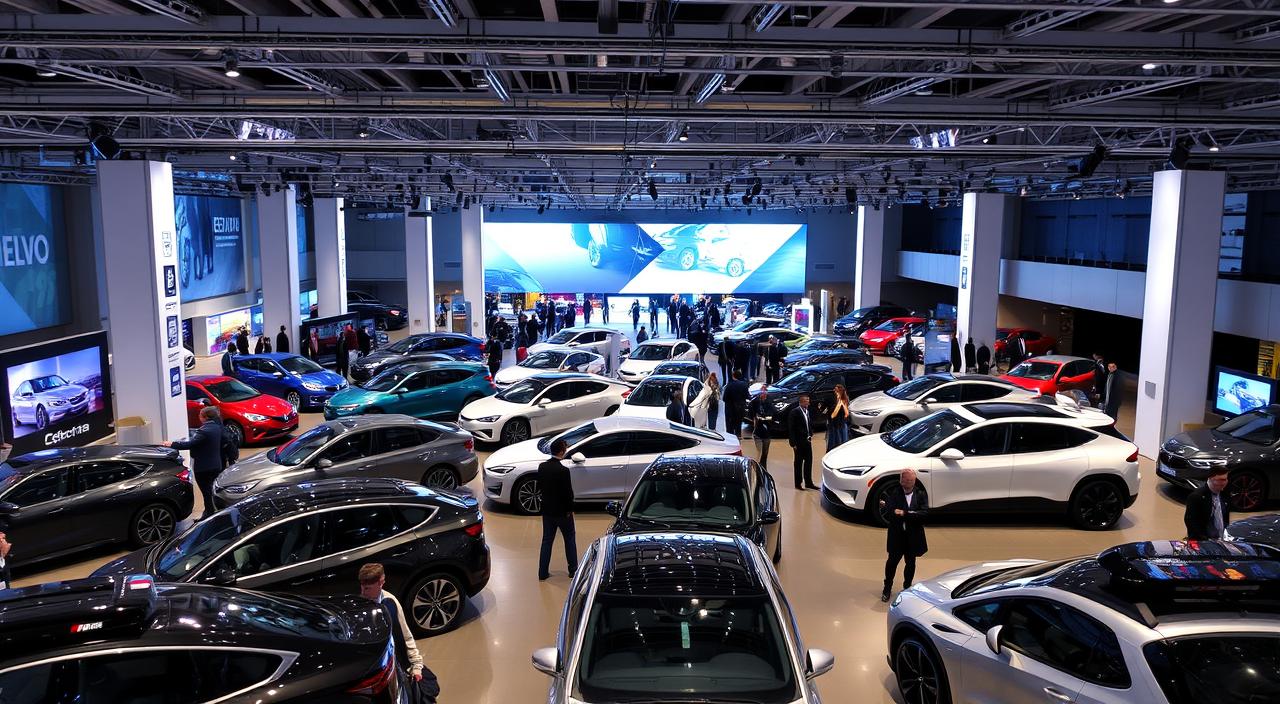
Jan
What does the future of cars in India look like? The Bharat Mobility Global Expo 2025 started on January 17. It showed the latest in electric cars and green transport. Big names from India and around the world showed off their newest cars and ideas.
Indian brands like Tata Motors and Mahindra were there. So were Hyundai, Maruti Suzuki, Toyota, Skoda, and MG. They all showed off their latest electric cars. Luxury brands like Porsche, BMW, Mercedes-Benz, and Mini also had a big presence. They unveiled fancy electric and hybrid cars for the Indian market.
Key Takeaways
- Bharat Mobility Global Expo 2025 showcases the latest innovations in the Indian automotive industry
- Major focus on electric vehicles and sustainable transportation solutions from both domestic and international automakers
- Tata Motors, Mahindra, Hyundai, Maruti Suzuki, Toyota, Skoda, and MG unveil impressive electric vehicle lineups
- Luxury brands like Porsche, BMW, Mercedes-Benz, and Mini present high-end electric and hybrid models for the Indian market
- The expo highlights the rapid evolution of mobility in India and the country’s growing role in shaping the future of the global automotive industry
Inauguration of India’s Biggest Automotive Festival
The Bharat Mobility Global Expo 2025, India’s largest automotive industry event, started with a big ceremony. It shows the latest in car tech and trends from all over. It’s a big deal in the global exhibitions world.
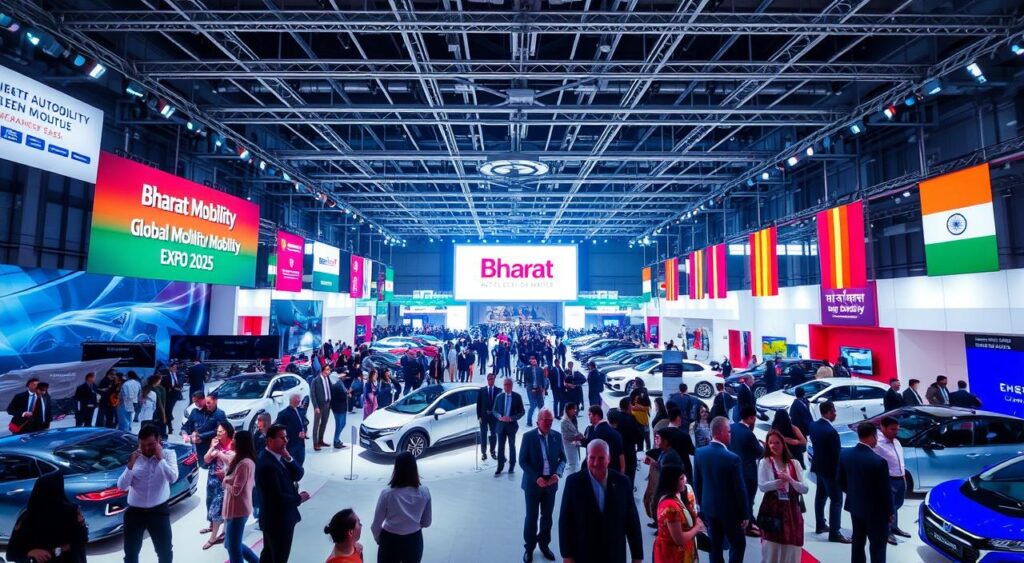
Notable Attendees at the Inauguration Ceremony
Many big names were at the ceremony. They included:
- Prime Minister Narendra Modi
- Union Minister for Road Transport and Highways, Nitin Gadkari
- Union Minister for Commerce and Industry, Piyush Goyal
- Chief Ministers of various Indian states
- CEOs and top executives from leading automotive companies
Prime Minister Narendra Modi’s Address
Prime Minister Narendra Modi talked about the car industry’s role in India’s economy. He talked about electric cars and bringing in foreign money. He also talked about new plans to help the car industry grow.
Some important points from his speech were:
| Initiative | Description |
|---|---|
| Electric Vehicle Policy | Aims to speed up electric car use in India |
| Automotive Skill Development Program | Works on making workers better for the industry |
| Automotive Research and Development Fund | Helps with new ideas and tech in the sector |
The Bharat Mobility Global Expo 2025 will see over 1 million visitors. It’s a big India event for cars. It will have shows from top car makers and tech companies from everywhere.
Tata Motors Showcases Impressive Lineup
At the Bharat Mobility Global Expo 2025, Tata Motors showed off a range of electric vehicles and concept cars. They highlighted their dedication to sustainable transportation and emerging technologies. The lineup featured both ready-to-buy models and futuristic concepts, showing their vision for the future of cars.
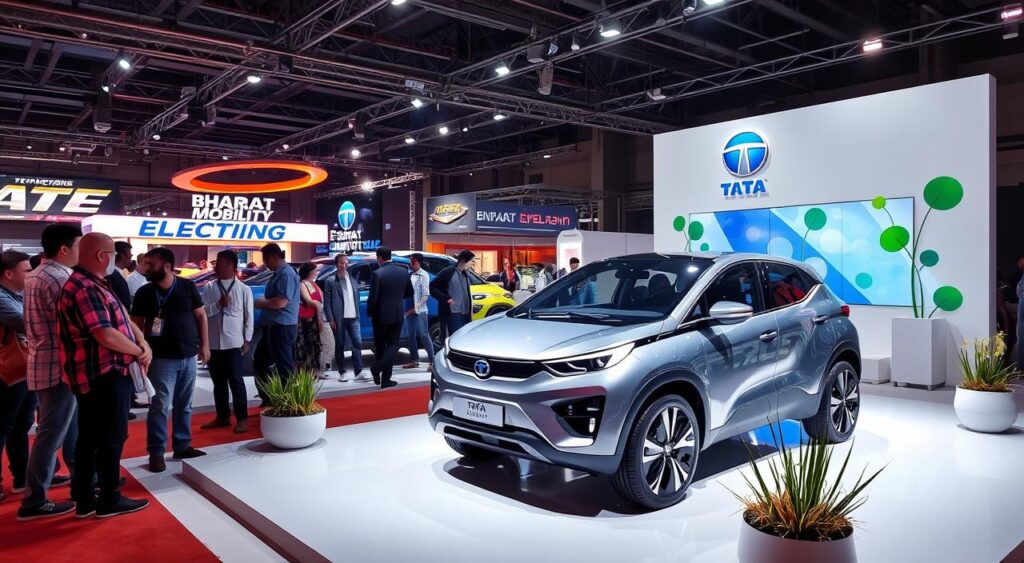
Sierra ICE Near Production Version Debut
Tata Motors introduced the near production version of the Sierra ICE. It’s a modern take on a classic SUV. The Sierra ICE mixes old-school design with new tech, blending nostalgia with innovation.
Production-Spec Harrier EV Unveiled
The production version of the Tata Harrier EV was unveiled at the expo. This all-electric SUV promises great performance, long range, and fast charging. It’s a top pick for those who care about the environment.
New Nexon EV, Harrier, and Safari Bandipur Editions
Tata Motors launched special Bandipur Editions of the Nexon EV, Harrier, and Safari. These editions are inspired by the Bandipur National Park’s wildlife and beauty. They have unique designs that celebrate the park’s biodiversity.
Safari and Harrier EV Stealth Editions
Tata Motors also showed off the Safari and Harrier EV Stealth Editions. These versions have a sporty look with blacked-out exteriors and big alloy wheels. They also have upgraded interiors that add a touch of elegance and energy.
Avinya X Concept: An Electric Crossover on EMA Platform
The Avinya X concept was a major highlight at the expo. It’s an electric crossover built on the new Electric Modular Architecture (EMA) platform. Developed with Jaguar Land Rover, the EMA platform aims to improve performance, range, and charging speed for electric cars.
Tata Motors’ impressive lineup at the Bharat Mobility Global Expo 2025 shows their leadership in the Indian car market. They are committed to making a difference in sustainable mobility.
Maruti Suzuki and Toyota’s Electric Offerings
The Bharat Mobility Global Expo 2025 highlighted the latest in electric vehicles and sustainable transportation. Maruti Suzuki and Toyota, big names in India, presented their electric cars at the event.
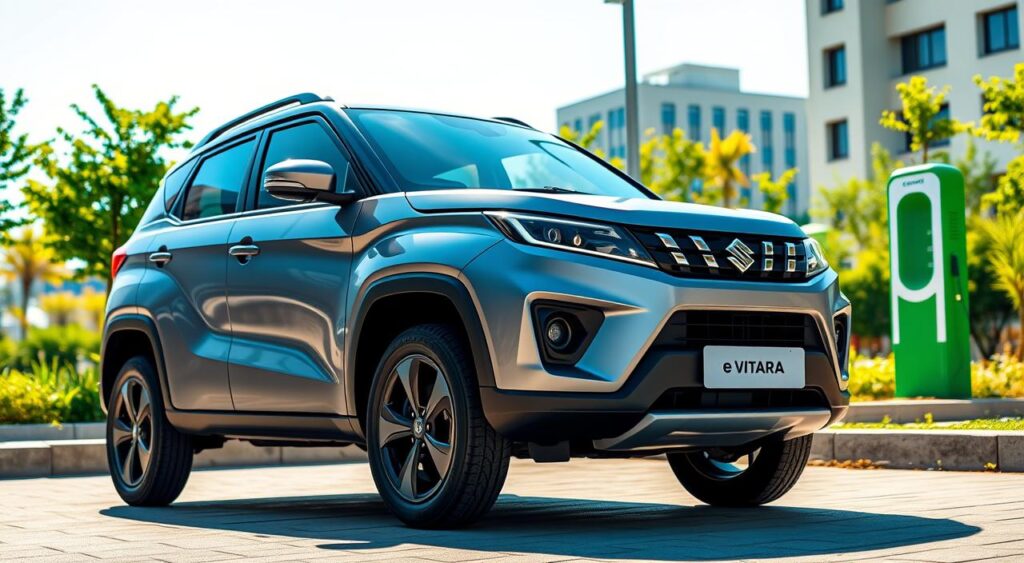
Maruti Suzuki e Vitara Launch Details and Specifications
Maruti Suzuki, India’s top car maker, introduced the e Vitara electric SUV. It’s coming out by March 2025. It will have two battery packs: 48 kWh and 59 kWh.
The e Vitara can go up to 400 km on one charge. It’s perfect for those who want an eco-friendly car that’s also stylish and practical.
Toyota Urban Cruiser BEV Concept India Debut
Toyota and Maruti Suzuki showed off the Urban Cruiser BEV concept. This small electric SUV will be available in India by 2025. It’s an affordable, green way to get around.
The Urban Cruiser BEV combines Toyota’s reliability with the latest electric tech. It’s a big step towards more green cars in India.
Toyota Hilux Black Edition Showcased
Toyota also displayed the Hilux Black Edition at the expo. This pickup truck has a black look that’s both stylish and tough. It shows Toyota’s wide range of cars for different tastes.
Hyundai, Mahindra, and Skoda’s Innovative Displays
The Bharat Mobility Global Expo 2025 was a big event. It showed off electric vehicles and emerging technologies from Hyundai, Mahindra, and Skoda. These brands showed their latest cars and ideas, focusing on sustainable transportation and new mobility solutions.
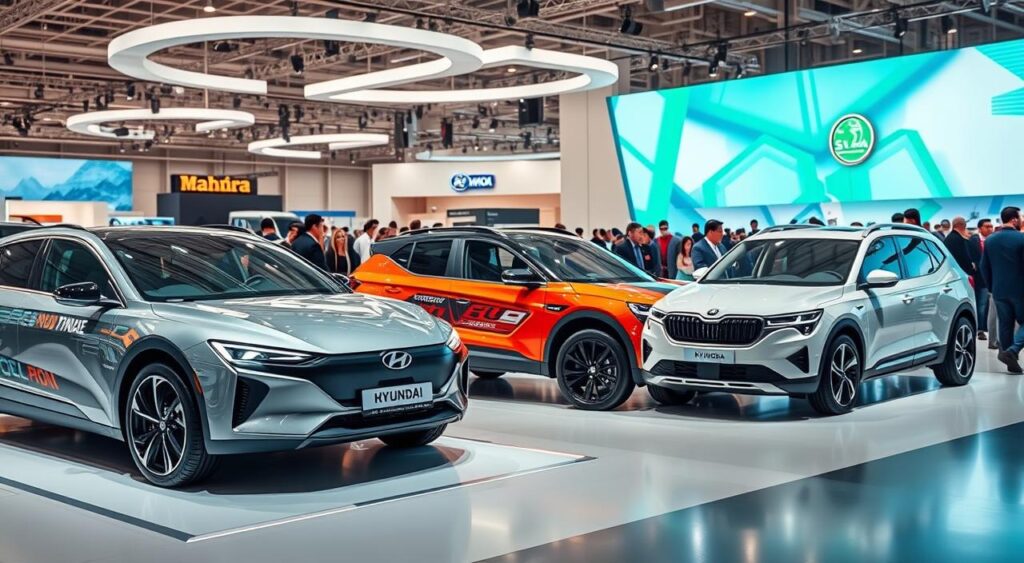
Hyundai caught everyone’s attention with the new Creta Electric. It starts at Rs 17.99 lakh. They also introduced the Ioniq 9, an electric SUV with a range of 620 km. Plus, they showed the E4W concept, giving a peek at their future electric vehicles.
Mahindra, a well-known Indian brand, showed off their electric SUVs, the BE 6 and XEV 9e. These cars show Mahindra’s goal to grow their EV range. They are designed with the latest tech and look great, ready to hit the market soon.
Skoda, from the Czech Republic, impressed with the 2025 Octavia vRS. It’s a fast sedan that’s also fuel-efficient. They also presented the new Kodiaq and Superb, showing their design and tech progress. Skoda’s Elroq and Vision 7S concept gave a sneak peek at their future EVs, showing their focus on emerging technologies and sustainable mobility solutions.
Hyundai, Mahindra, and Skoda are leading the change in the car world. They offer a wide range of electric vehicles and cutting-edge tech. Their displays at the Bharat Mobility Global Expo 2025 show their dedication to making transportation better in India and worldwide.
Luxury Brands Shine: Mini, BMW, Mercedes-Benz, Lexus, and Porsche
The Bharat Mobility Global Expo 2025 was a big hit. It showed off the latest from top luxury vehicle makers. They focused on new electric vehicles and cool concept cars.
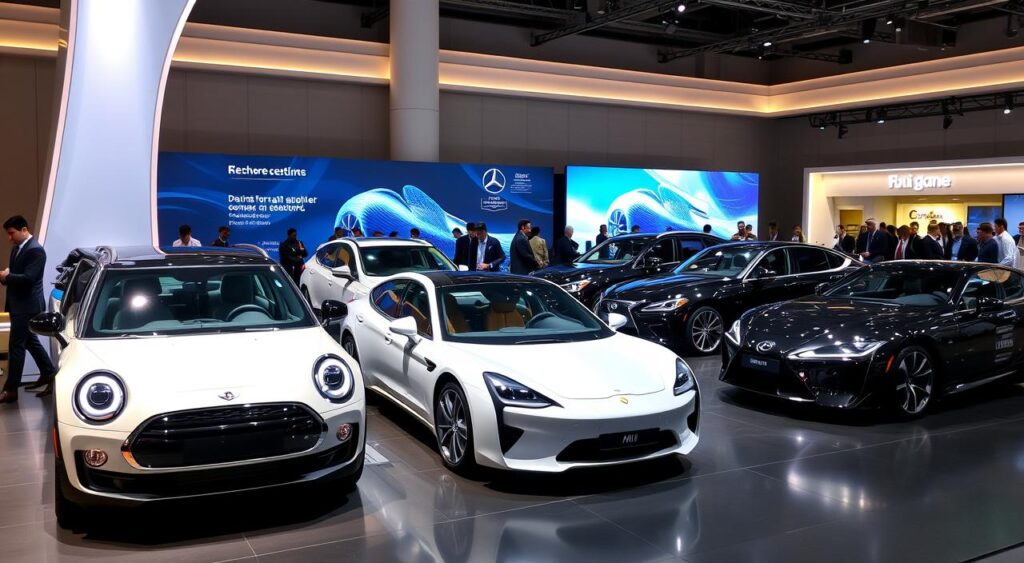
Mini Cooper S John Cooper Works Pack Introduced
Mini introduced the Cooper S John Cooper Works Pack. It’s sporty and stylish. The pack adds special design touches to the car’s look.
BMW Launches iX1 Long Wheelbase and New X3
BMW brought out the iX1 Long Wheelbase for India. They also showed off the new X3. It has cool tech and better fuel use.
Lexus Showcases LF-ZC Sedan and ROV Concepts
Lexus showed off the LF-ZC sedan and ROV concepts. The LF-ZC is sleek and fast. The ROV is tough and fancy.
Mercedes-Benz Unveils Maybach GLS and EQS SUV Night Series
Mercedes-Benz wowed everyone with the Maybach GLS. It’s the top of luxury. They also showed the EQS SUV Night Series. It’s an electric vehicle that’s stylish and green.
Porsche’s Updated Lineup: 911, 911 GT3 RS, Macan Electric, and Taycan
Porsche updated their lineup. They showed the 911, the 911 GT3 RS, and electric Macan and Taycan. These cars show Porsche’s love for speed and green cars.
| Brand | Models Showcased |
|---|---|
| Mini | Cooper S John Cooper Works Pack |
| BMW | iX1 Long Wheelbase, New X3 |
| Lexus | LF-ZC Sedan Concept, ROV Concept |
| Mercedes-Benz | Maybach GLS, EQS SUV Night Series |
| Porsche | 911, 911 GT3 RS, Macan Electric, Taycan |
Kia and MG’s Exciting Reveals
Kia and MG made a big splash at the Bharat Mobility Global Expo 2025. They showed off their latest electric vehicles and cool designs. These companies are leaders in sustainable transportation, bringing new tech and stylish cars to India.
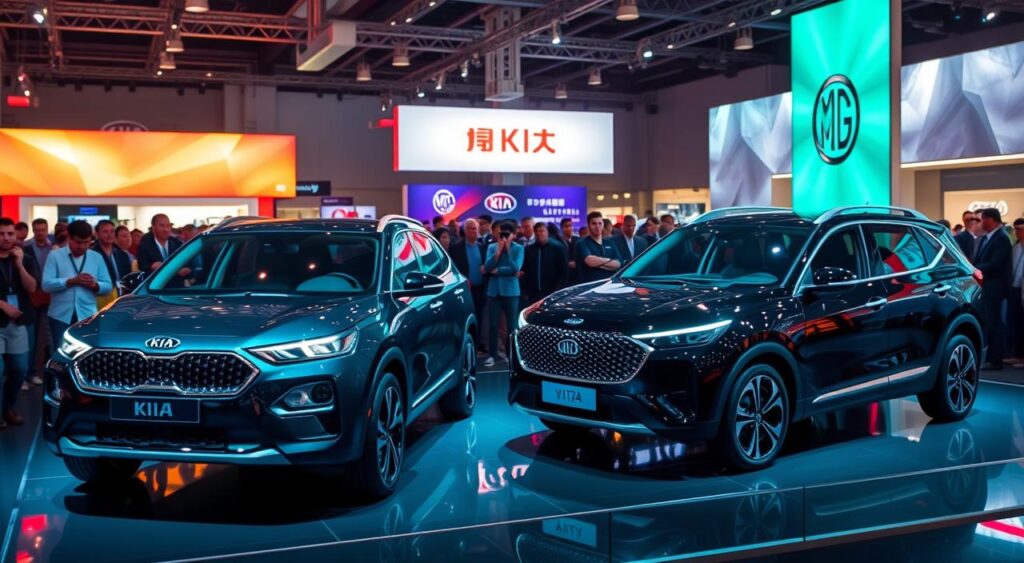
2025 Kia EV6 and Carnival Hi-Limousine Showcased
Kia introduced the 2025 EV6, an updated electric crossover. It has better range, faster charging, and a sleek look. Kia also showed the Carnival Hi-Limousine, a luxury MPV for those who want the best.
MG Cyberster Electric Convertible and M9 MPV Unveiled
MG wowed everyone with the Cyberster, a beautiful electric convertible. It mixes classic design with EV tech. The M9, an electric MPV, is perfect for families who care about the planet.
| Model | Type | Key Features |
|---|---|---|
| MG Cyberster | Electric Convertible | Classic British design, cutting-edge EV technology |
| MG M9 | All-Electric MPV | Spacious seating for up to seven passengers |
MG 7 Trophy and ZS HEV (Astor) Displayed
MG showed off the 7 Trophy, a sporty sedan with luxury and speed. They also had the ZS HEV (Astor), a hybrid SUV. These cars show MG’s wide range of electric vehicles and hybrids for Indian buyers.
MG also presented the Majestor SUV, IM 5, and IM 6 electric siblings. This highlights MG’s focus on sustainable transportation and its growing role in India’s car market.
Here Are Day 1 And 2 Snippets From Bharat Mobility Global Expo 2025
The Bharat Mobility Global Expo 2025, India’s biggest car show, started with excitement. It showed off the newest car tech. The first two days had many new car launches, reveals, and ideas from top car makers.
Big names in India’s car world, like Tata Motors, Maruti Suzuki, and Mahindra, showed off their electric cars. Tata Motors had a cool lineup, including the Sierra ICE and the Harrier EV. Maruti Suzuki launched the e Vitara and showed they care about green cars.
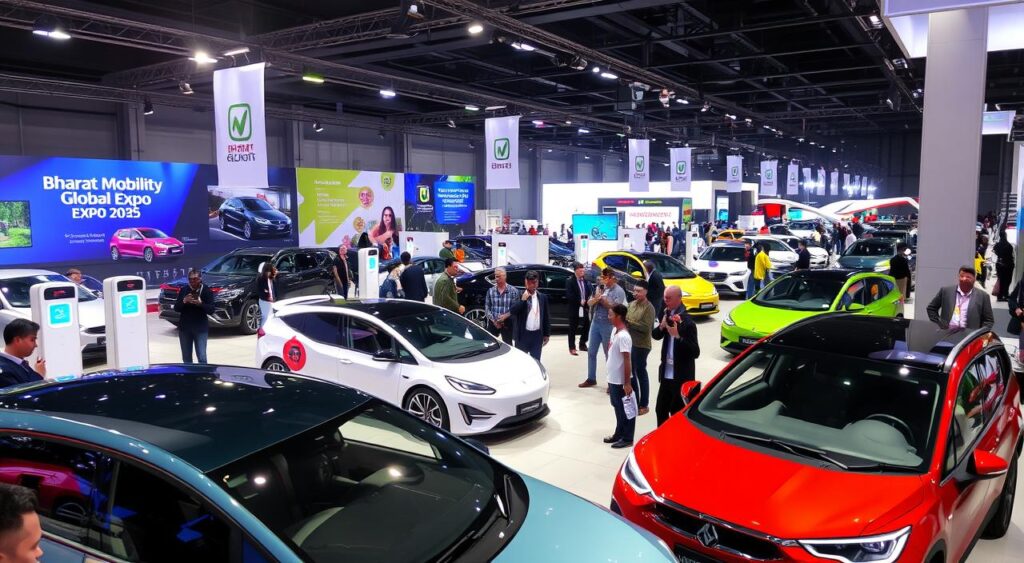
Global car makers also made a big splash. Toyota, Hyundai, and Skoda showed off their latest cars. Toyota introduced the Urban Cruiser BEV concept and the Hilux Black Edition. Hyundai and Skoda showed off their electric and hybrid tech.
Luxury car brands like Mini, BMW, Mercedes-Benz, Lexus, and Porsche also showed up. They brought their newest models and ideas. From the Mini Cooper S John Cooper Works Pack to the Porsche Taycan, they showed luxury and green cars can go together.
| Brand | Notable Launches and Reveals |
|---|---|
| Tata Motors | Sierra ICE, Harrier EV, Avinya X Concept |
| Maruti Suzuki | e Vitara |
| Toyota | Urban Cruiser BEV Concept, Hilux Black Edition |
| BMW | iX1 Long Wheelbase, New X3 |
| Mercedes-Benz | Maybach GLS, EQS SUV Night Series |
The Bharat Mobility Global Expo 2025 was more than just a car show. It was a place for talks on green cars, new tech, and car solutions. People from all over came, showing India’s big role in car innovation.
BYD, VinFast, Isuzu, and Vayve Mobility’s Unique Offerings
The Bharat Mobility Global Expo 2025 highlighted many electric vehicles and sustainable transportation options. BYD, VinFast, Isuzu, and Vayve Mobility showcased their unique products. They aimed to meet India’s growing need for green mobility solutions.
BYD Sealion 7 and Sealion 6 PHEV India Debut
BYD, a top Chinese car maker, introduced the Sealion 7 and Sealion 6 PHEV in India. These cars are plug-in hybrids. They use electric power for short trips and a gasoline engine for longer ones.
VinFast Showcases Range of Electric Vehicles and VF Wild Pickup Concept
Vietnamese brand VinFast brought a variety of electric vehicles to the expo. They included sedans, SUVs, and the VF Wild pickup concept. Their focus on sustainable transportation was clear in their designs, drawing lots of interest.
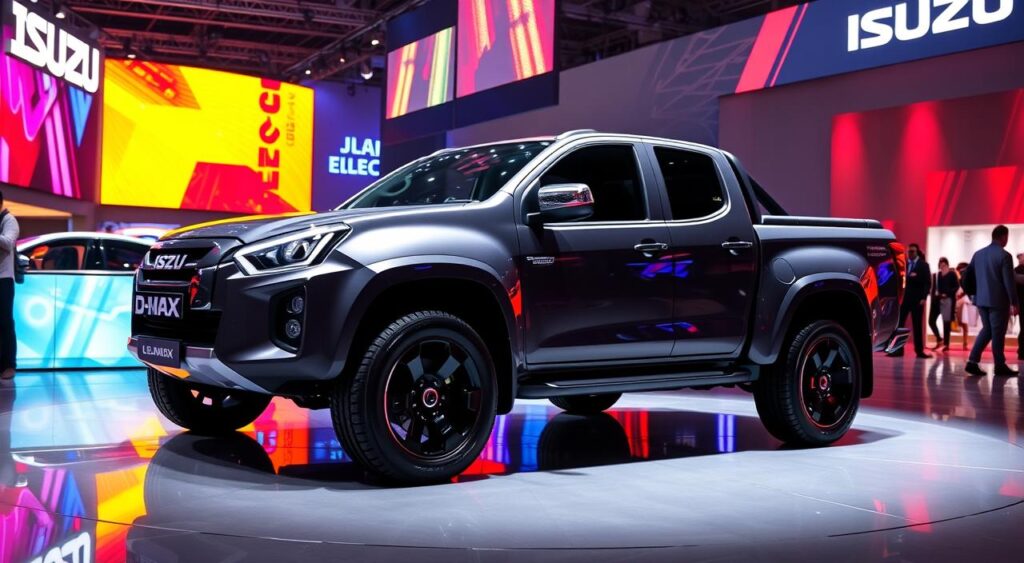
Isuzu D-Max All-Electric Pickup Concept
Isuzu stunned everyone with the D-Max all-electric pickup concept. This tough vehicle showed how electric vehicles can work in commercial and utility roles. It gave a peek into India’s future of sustainable transportation.
Vayve Eva Market Debut and Pricing
Vayve Mobility, a local electric scooter maker, launched the Eva. Priced at Rs 3.25 lakh, the Eva is an affordable, green mobility solution for city commuters. Here’s a quick look at its specs and price:
| Specification | Value |
|---|---|
| Range | 120 km |
| Top Speed | 80 km/h |
| Battery Capacity | 3.2 kWh |
| Charging Time | 4 hours |
| Price | Rs 3.25 lakh |
Emerging Technologies and Sustainable Transportation Solutions
The Bharat Mobility Global Expo 2025 showed the car industry’s push for sustainable transportation and emerging technologies. Car makers from all over the world presented their newest mobility solutions. They highlighted big steps in electric cars, self-driving cars, and connected cars.
The innovation showcase showed off new battery tech, charging systems, and light materials. Companies showed how they’re making electric cars go further and charge faster. This makes electric cars more useful for daily life.
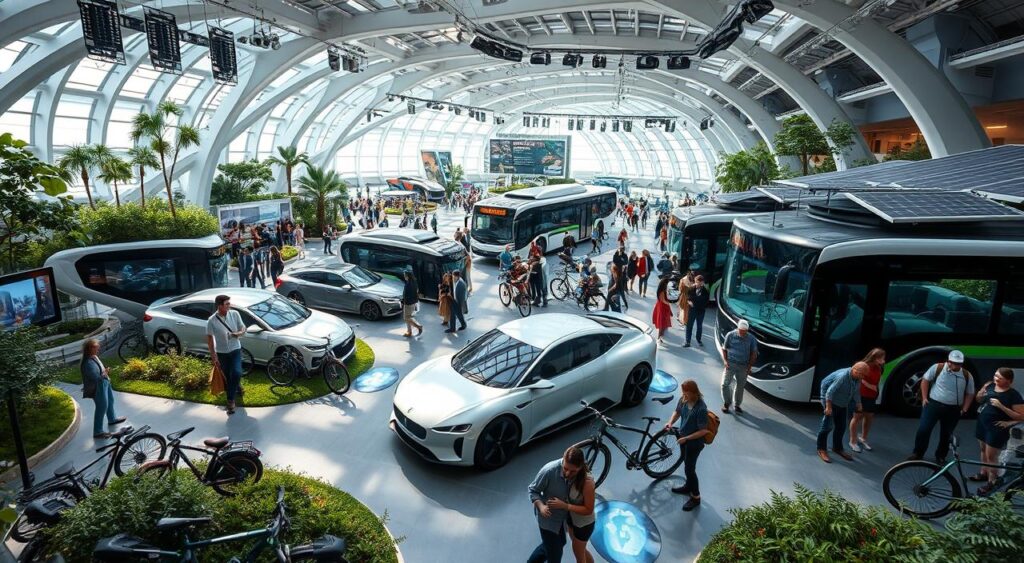
The expo also looked at hydrogen fuel cells and biofuels as green car options. Visitors could see the latest in these areas. They learned how these techs could change the car world.
The following table highlights some of the key sustainable transportation solutions showcased at the Bharat Mobility Global Expo 2025:
| Technology | Benefits | Examples |
|---|---|---|
| Electric Vehicles | Zero emissions, low running costs | Tata Avinya X, Maruti Suzuki e Vitara |
| Hydrogen Fuel Cells | Zero emissions, quick refueling | Toyota Mirai, Hyundai Nexo |
| Biofuels | Renewable, reduced emissions | Ethanol blends, biodiesel |
| Lightweight Materials | Improved fuel efficiency, reduced emissions | Carbon fiber, aluminum alloys |
The Bharat Mobility Global Expo 2025 was a big step for the car industry. It showed how car makers are working towards a greener future. This future is cleaner and more efficient for cars in India and worldwide.
Conclusion
The Bharat Mobility Global Expo 2025 was a huge success. It showed off the latest in the car world. Electric cars and green transport got a lot of attention, with big names like Tata Motors leading the way.
Tata Motors showed off their new electric SUV, the Tata Avinya. It was made with Jaguar Land Rover. The expo also showed off new tech that will change how we travel and use our cars.
India’s role in the car world is growing, with both local and global brands showing off their latest. The expo was a chance for leaders, policymakers, and buyers to talk about the future of cars. They discussed how green cars can help the planet.
As the Bharat Mobility Global Expo 2025 ends, it’s clear the car world is changing. We’re moving towards cleaner, smarter, and more connected cars. The expo has set the stage for more innovation and teamwork. With India leading the way, the future of cars looks very promising.
FAQ
What is the Bharat Mobility Global Expo 2025?
The Bharat Mobility Global Expo 2025 is India’s biggest car festival. It shows off new cars, big launches, and concepts from around the world. The focus is on electric cars, green transport, and new car tech.
When and where was the Bharat Mobility Global Expo 2025 held?
It started on 17 January, 2025, in India. Prime Minister Narendra Modi opened it, joined by other big names like Nitin Gadkari and Piyush Goyal.
What were some of the major highlights from Tata Motors at the expo?
Tata Motors showed off the Sierra ICE, the Harrier EV, and the Nexon EV Bandipur Edition. They also had the Harrier and Safari Bandipur Editions, and the Avinya X concept.
What electric vehicles did Maruti Suzuki and Toyota showcase at the event?
Maruti Suzuki showed the e Vitara, coming in March 2025. Toyota introduced the Urban Cruiser BEV concept and the Hilux Black Edition.
What were some of the notable launches and reveals from luxury brands at the expo?
Mini launched the Cooper S John Cooper Works Pack. BMW introduced the iX1 and new X3. Lexus showed the LF-ZC sedan and ROV concepts.
Mercedes-Benz unveiled the Maybach GLS and EQS SUV Night Series. Porsche updated the 911, 911 GT3 RS, Macan Electric, and Taycan lineup.
What unique offerings did BYD, VinFast, Isuzu, and Vayve Mobility present at the expo?
BYD debuted the Sealion 7 and Sealion 6 PHEV. VinFast brought electric vehicles and the VF Wild pickup concept. Isuzu showed the D-Max all-electric pickup concept.
Vayve Eva made its market debut starting at Rs 3.25 lakh.
What was the main focus of the Bharat Mobility Global Expo 2025?
The expo focused on electric cars, green transport, and new car tech. It showed how the car industry is changing towards these areas.
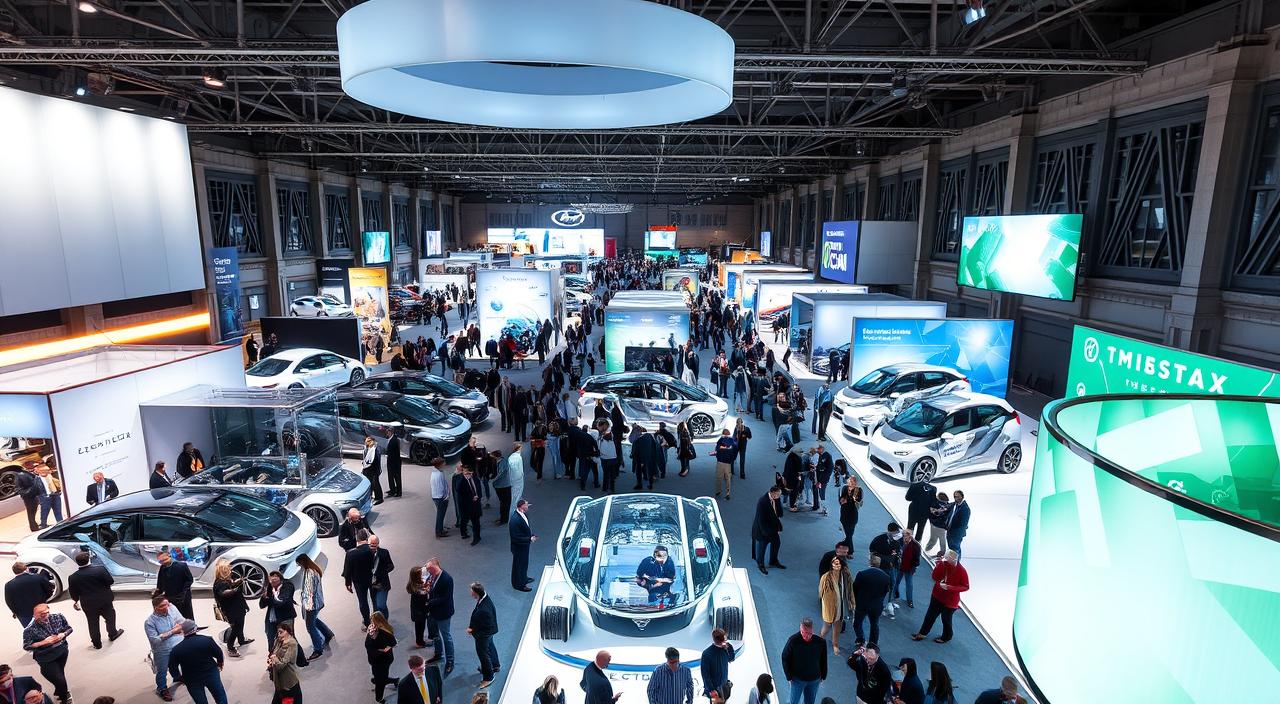
Jan
India’s automotive scene is booming, and the Bharat Mobility Global Expo 2025 is proof. It will welcome over 500,000 visitors from January 17th to 22nd at Pragati Maidan in New Delhi. This number is up from last year, showing more people are interested in green mobility and new car tech.
The expo covers 200,000 square meters and features 1,500+ exhibitors. You’ll see the latest in cars, urban mobility, batteries, construction equipment, steel, tires, and cycles. Auto parts are a big deal in India, making up 14–15% of engineering exports. The event aims to bring together different parts of the mobility world, encouraging new ideas and partnerships.
The expo will be held at Bharat Mandapam, Yashobhoomi in Dwarka, and India Expo Mart. These places are known for hosting big events. The Auto Components Show is getting a lot of attention, with a waiting list. This shows how excited everyone is about the expo.
India is moving fast in the car world, and this expo is where leaders meet. It’s a chance to find new business opportunities and make connections. With the fast growth in mobility, this expo might become a yearly or every two years event.
Key Takeaways
- Bharat Mobility Global Expo 2025 is expected to attract over 500,000 visitors from January 17-22 at Pragati Maidan, New Delhi
- The expo will showcase innovations from 1,500+ exhibitors across various sectors, including the Auto Show, Urban Mobility and Infrastructure Show, Battery Show, and more
- Auto components account for 14–15% of India’s engineering exports, and the expo aims to enhance visibility and create synergies among diverse mobility sectors
- Notable venues include Bharat Mandapam, Yashobhoomi in Dwarka, and India Expo Mart, with the Auto Components Show garnering significant interest
- The expo serves as a platform for industry leaders, experts, and enthusiasts to connect, explore partnerships, and discover new markets and business opportunities
Experience the Future of Mobility at Bharat Mobility Global Expo 2025
The Bharat Mobility Global Expo 2025 is a groundbreaking event. It will showcase the latest automotive technologies and innovations shaping mobility’s future. With over 70,000 square meters for the Bharat Mobility Component Show, it’s India’s largest component show yet. The expo will feature more than 1,000 exhibitors, including five international pavilions, showing the industry’s global reach.
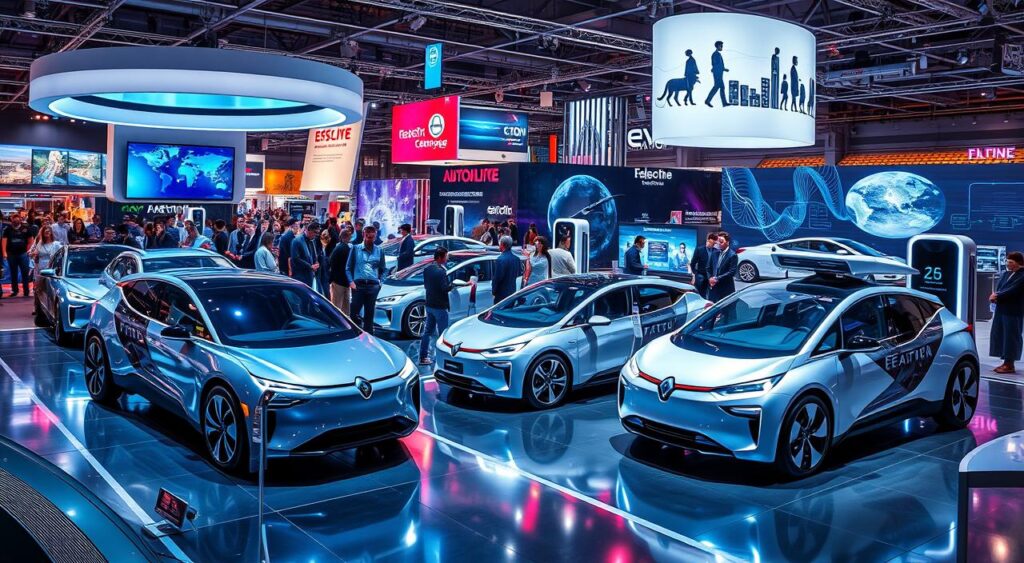
As an attendee, I’m excited to see advancements in electric vehicles and more. The expo is a place for industry leaders, experts, and enthusiasts to share insights and discuss the future. It’s a chance to meet the minds behind the innovations changing how we travel.
Showcase of Latest Automotive Technologies and Innovations
The Bharat Mobility Global Expo 2025 will be a hub of innovation. It will feature advanced automotive technologies. For example, the Ferrato ‘DEFY 22’ electric scooter can go up to 70 km/h and has an 80 km range on a single charge. It has a 1200W motor and a 72V 30Ah LFP battery, showing the latest in electric mobility.
The expo will also show a range of electric three-wheeler models for passengers and cargo. This shows the industry’s commitment to sustainable transport for the Indian market. As an enthusiast, I’m excited to see these innovations and their impact on urban mobility.
Platform for Industry Leaders, Experts, and Enthuasiasts
The Bharat Mobility Global Expo 2025 is more than just a tech showcase. It’s a place for industry leaders, experts, and enthusiasts to connect and shape mobility’s future. Major automakers like Maruti Suzuki and Hyundai Motor will launch new electric models, showing the industry’s shift towards EVs.
As an attendee, I’m looking forward to discussions with industry leaders and learning about the future. The expo is a chance to network, explore partnerships, and help drive the automotive industry forward.
The Bharat Mobility Global Expo 2025 is a gateway to the future of mobility. It brings together the latest automotive technologies, innovations, and top industry minds. As an enthusiast, I’m excited to be part of this journey and see the groundbreaking advancements that will change how we move. To learn more about the automotive industry, visit BuyAutoMobile, a platform dedicated to revolutionizing the automotive experience.
Bharat Mobility Global Expo 2025 – 17th to 22th January, Mark Your Calendars!
Get ready for the Bharat Mobility Global Expo 2025! It’s the biggest event in the car world. It will happen from January 17th to 22nd, 2025, at Bharat Mandapam, Yashobhoomi in Delhi, and India Expo Center and Mart in Greater Noida. Mark your calendars and get ready to see the future of cars.
This expo is more than just an event. It’s a big celebration of new ideas, tech, and the endless possibilities in cars. With over nine shows and more than 20 conferences and pavilions, it’s going to change the game. The theme, “Beyond Boundaries: Co-creating Future Automotive Value Chain,” shows the focus on teamwork and new ideas.
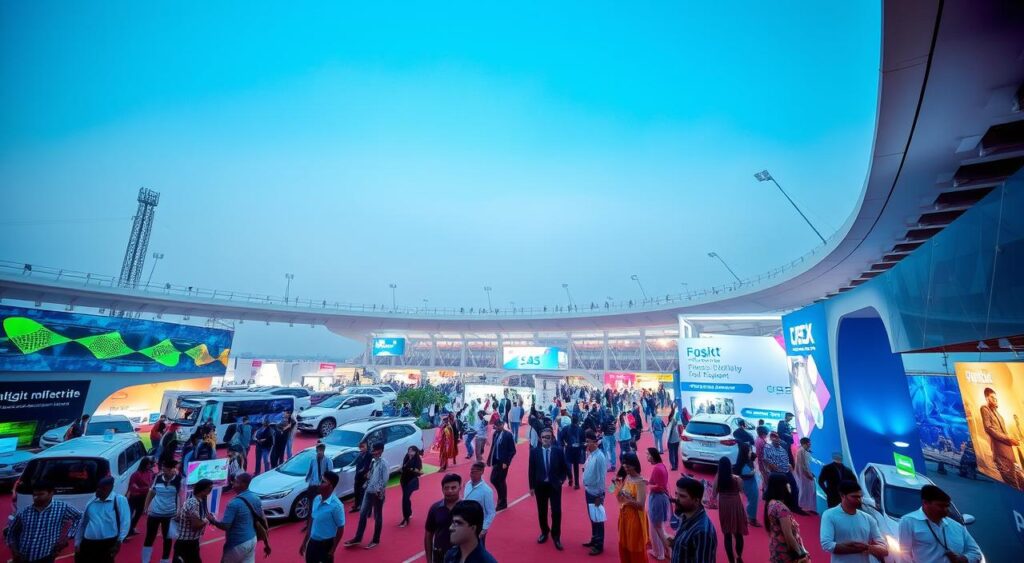
The Indian government is really into making the car world better. They’ve set aside Rs 1 lakh crore for new research and ideas. This shows India’s big plans for the future of travel. In 2024, India saw a huge 11.6% jump in car sales, selling 2.5 crore units. This made India the world’s third-biggest car market.
The expo will show off the latest in electric cars, smart cars, and more. You’ll see amazing new tech and ideas that will change how we travel. It’s going to be a big show.
Don’t miss out on this big change in the car world. Mark your calendars for January 17-22, 2025. The Bharat Mobility Global Expo 2025 at Pragati Maidan is where the future of cars will be shaped. It’s an event you won’t want to miss!
Highlights of the Bharat Mobility Global Expo 2025
The Bharat Mobility Global Expo 2025 will showcase the latest in sustainable mobility. It will feature cutting-edge technologies and innovations. From January 17 to 22, 2025, visitors can explore the future of transportation at this grand event.
The event will be held across seven halls at Bharat Mandapam and associated shows at Yahobhoomi and India Expo Centre. It spans over 200,000 square meters.
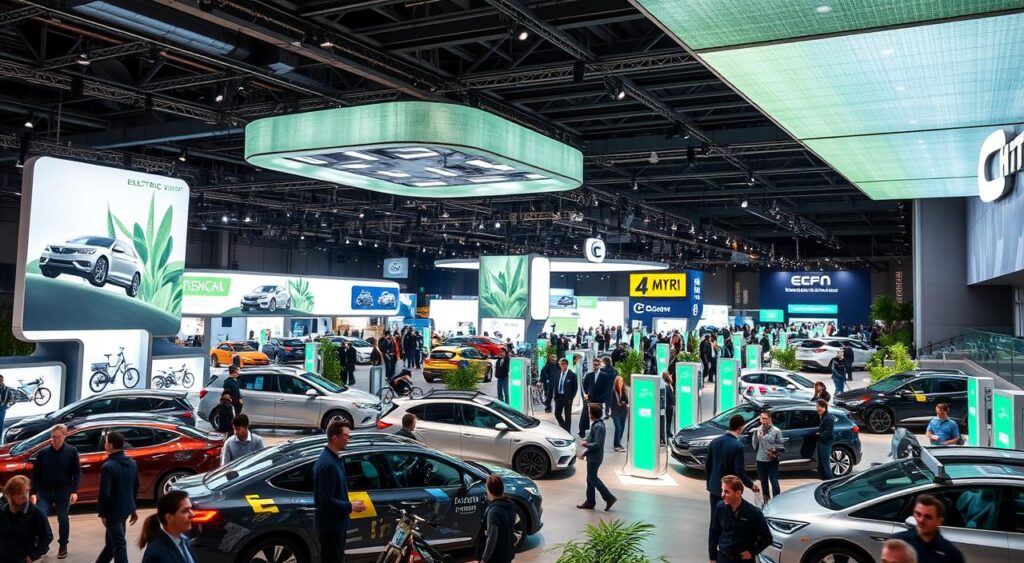
Electric Vehicles and Sustainable Mobility Solutions
One of the expo’s highlights is the display of electric vehicles and sustainable mobility solutions. Visitors can see the launch of the Ferrato ‘DEFY 22’ on January 17, 2025. It has a top speed of 70 km/h and a range of 80 km on a single charge.
The expo will also feature the new ACTIVA e electric scooter. It’s priced at ₹1,17,000 (ex-showroom, Bengaluru). It offers a range of 102 km and accelerates from 0 to 60 km/h in just 7.3 seconds.
Connected and Autonomous Vehicles
The expo will showcase the latest in connected and autonomous vehicles. It will demonstrate how technology is changing how we travel. Visitors can see live demonstrations and interactive displays.
They will gain insights into the future of self-driving cars and intelligent transportation systems.
Commercial Vehicles and Fleet Management
Commercial vehicles and fleet management solutions will be a major focus. Attendees can discover innovative technologies and best practices. These aim to optimize fleet operations, reduce costs, and enhance efficiency.
The expo will showcase a range of electric three-wheeler models. These include L5 Passenger Vehicles, L5 Loader Covered Body, and L3 Passenger Vehicles.
Intelligent Transportation Systems and Infrastructure
The Bharat Mobility Global Expo 2025 will highlight the importance of intelligent transportation systems and infrastructure. Visitors can explore advanced traffic management solutions and smart city initiatives. They will also see sustainable infrastructure projects.
These aim to enhance safety, reduce congestion, and improve the overall transportation experience.
| Vehicle Model | Price (Ex-showroom) | Range | Top Speed |
|---|---|---|---|
| Ferrato ‘DEFY 22’ | INR 99,999 | 80 km | 70 km/h |
| ACTIVA e | ₹1,17,000 (Bengaluru) | 102 km | 80 km/h |
| QC1 | ₹90,000 (Bengaluru) | 80 km | 50 km/h |
With over 1,500 exhibitors participating and more than 90 product launches in the first two days, the Bharat Mobility Global Expo 2025 is expected to attract approximately 500,000 visitors. The event offers free entry to the public, making it accessible to all interested in the future of mobility.
Networking Opportunities and Business Prospects
The Bharat Mobility Global Expo 2025 is more than just a showcase for new car tech. It’s a place for networking opportunities and business prospects. With 400-500 million visitors expected, it’s set to be a huge event for the mobility sector.
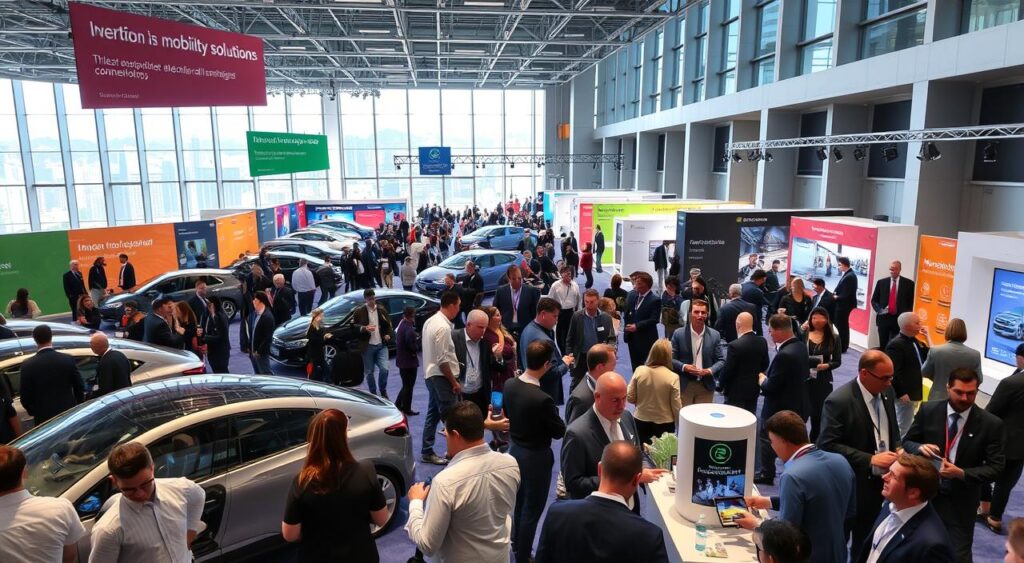
Over the first two days, more than 90 new products were launched. This shows the event’s dynamic nature. The market is also looking good, with smallcap and midcap benchmarks up for four days.
The Nifty Media and Nifty Realty sectors saw big gains on January 19, 2025. Nine out of 12 sectors on the NSE moved up, showing a positive trend.
Connect with Industry Leaders and Decision Makers
At the Bharat Mobility Global Expo 2025, you can meet industry leaders and decision makers. These meetings can lead to valuable insights and new partnerships. By talking to key players, businesses can stay ahead in tech and trends.
Explore Partnerships and Collaborations
The expo is a chance to find partnerships and collaborations. Whether it’s strategic alliances or tech partnerships, there are many opportunities. These partnerships can help businesses grow and reach new markets.
Discover New Markets and Business Opportunities
The Bharat Mobility Global Expo 2025 is a chance to find new markets and business opportunities. You can learn about emerging trends and untapped niches. This knowledge can help businesses expand and find new opportunities.
The following table highlights some key statistics related to the networking and business prospects at the Bharat Mobility Global Expo 2025:
| Statistic | Value |
|---|---|
| Estimated visitors | 400-500 million |
| New products launched in first two days | 90+ |
| Consecutive days of smallcap and midcap benchmark gains | 4 |
| Sectors advancing on NSE (January 19, 2025) | 9 out of 12 |
By attending the Bharat Mobility Global Expo 2025, businesses can grow and succeed. The event is a chance to make valuable connections and explore new ideas. To make the most of it, come with a clear plan and an open mind. Don’t miss this chance to shape the future of mobility and grow your business. Contact us today to learn more about participating in the Bharat Mobility Global Expo 2025.
Conclusion
The Bharat Mobility Global Expo 2025 is a key event for those interested in the future of cars and transportation. It will be held from January 17th to 22nd at Pragati Maidan in New Delhi. This expo showcases the latest in tech, green transport, and new products that are changing the industry.
By going to the Bharat Mobility Global Expo 2025, you’ll learn about the latest car trends. You’ll see everything from electric cars to smart traffic systems. It’s a great way to stay updated and ready for the future.
The expo is also a great place to meet people and make business connections. You can talk to leaders and experts from all over. It’s perfect for anyone looking to grow their business or just learn more about cars.
Don’t miss this chance to be part of the future of cars. Save the dates for January 17th to 22nd, 2025, and join us in New Delhi. You’ll see the latest tech, learn a lot, and make important connections. We can’t wait to see you there!
FAQ
When and where is the Bharat Mobility Global Expo 2025 being held?
The Bharat Mobility Global Expo 2025 will be held from January 17th to 22nd. It will take place at Pragati Maidan in New Delhi, India.
What can I expect to see at the Bharat Mobility Global Expo 2025?
At the expo, you’ll see the latest in automotive tech and innovation. This includes electric vehicles, connected and autonomous cars, and more. You’ll also see commercial vehicles and fleet management solutions.
There will be intelligent transportation systems on display too. You can check out the latest from top manufacturers and tech providers.
Who should attend the Bharat Mobility Global Expo 2025?
The expo is for industry leaders, experts, and fans. It’s a great place to talk about the future of mobility. If you’re into cars or green transport, you should be there.
Are there networking opportunities at the Bharat Mobility Global Expo 2025?
Yes, there are great chances to network and find business opportunities. You can meet industry bigwigs and find new partners. It’s a chance to explore new markets and business ideas in the mobility world.
What are the key highlights of the Bharat Mobility Global Expo 2025?
The expo will focus on electric vehicles and green transport. You’ll see connected and autonomous cars, commercial vehicles, and fleet management. There will also be smart transport systems and infrastructure.
Is the Bharat Mobility Global Expo 2025 focused on sustainable mobility solutions?
Yes, it’s all about green transport solutions. Electric vehicles are a big part of the event. You can see the newest in this fast-growing car segment.
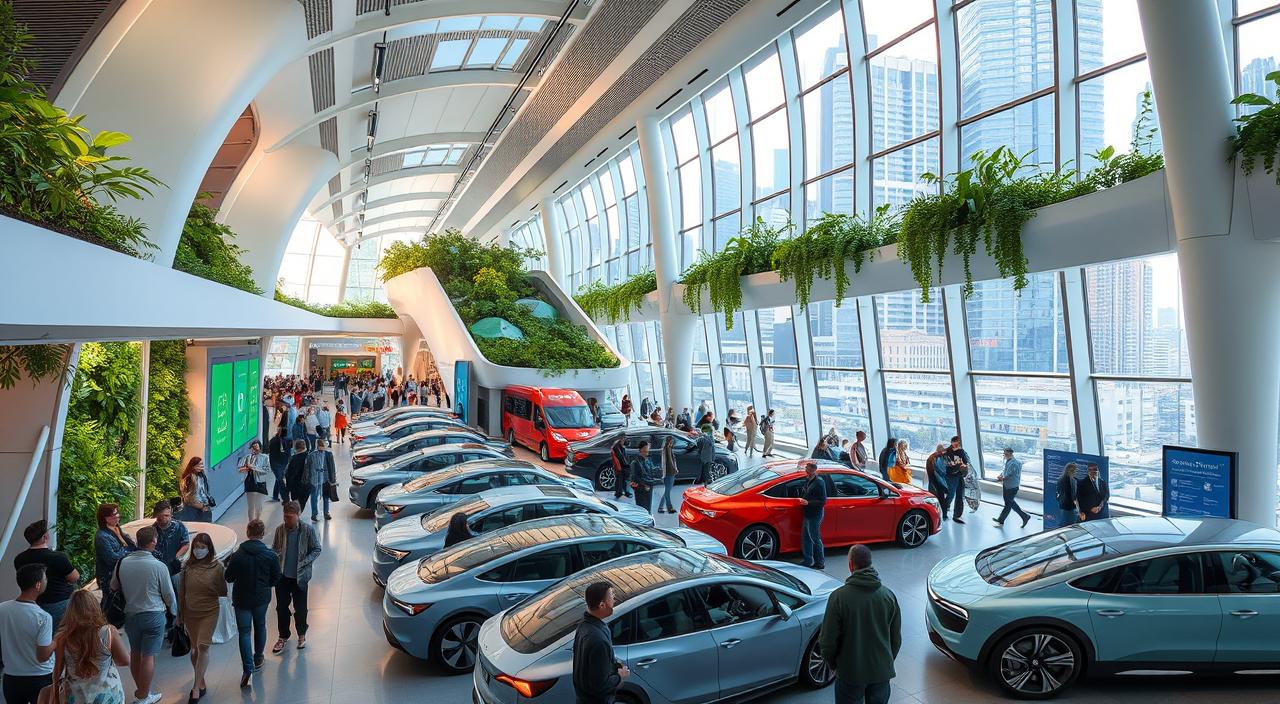
Jan
India is now the world’s third-largest car maker, making over four million cars a year. This puts India right behind China and the United States. The Bharat Mobility Expo 2025 at the Bharat Mandapam in Pragati Maidan, New Delhi, highlights India’s focus on green transport and electric vehicles.
The expo featured exciting new launches. These include the Maruti Suzuki e-Vitara electric SUV and the TVS Jupiter CNG scooter. Yamaha also showed off thrilling adventure bikes. Hero MotoCorp unveiled the Hero Karizma 250, showing India’s innovation in automotive tech.
The Bharat Mobility Expo 2025 is now an annual event, up from biennial. This change shows how fast India’s car industry is growing. With most of India’s people under 35, the expo is key for engaging the youth in green transport.
Key Takeaways:
- India ranks as the world’s third-largest car manufacturer, producing over 4 million cars annually
- The Bharat Mobility Expo 2025 showcases India’s commitment to sustainable transportation and electric vehicles
- Notable launches at the expo include the Maruti Suzuki e-Vitara electric SUV and TVS Jupiter CNG scooter
- The expo has transitioned to an annual event, reflecting the rapid pace of development in India’s automotive sector
- With a young population, India is poised to embrace sustainable transportation solutions for the future
India’s Emergence as a Global Automotive Leader
India’s car and bike industry has grown a lot in recent years. This has made India one of the top car makers in the world. It produces over four million cars and nearly 20 million bikes every year.
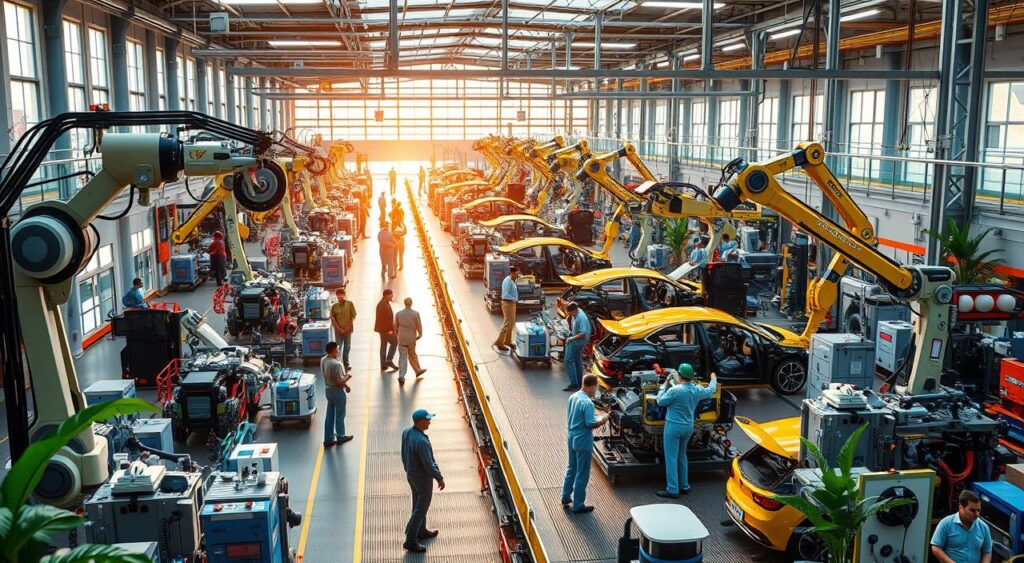
India’s car world changed in the early 1990s when it welcomed big car companies. This move brought in more money and new tech. Now, India is the biggest maker of three-wheelers and tractors, making it a global leader.
Impressive Growth in Car and Two-Wheeler Production
India’s car and bike making has grown a lot. It makes over four million cars every year. The bike market is the biggest in the world, with nearly 20 million bikes made annually.
Rise of the Indian Auto Component Industry
The auto parts industry in India has also grown a lot. Companies are not just growing in India but also selling their products worldwide. This shows they are good at what they do and can compete globally.
| Automotive Sector | Annual Production |
|---|---|
| Cars | Over 4 million units |
| Two-Wheelers | Close to 20 million units |
India is getting even bigger in the car world. It’s making more cars and bikes and its auto parts industry is growing. This means India will keep driving innovation, attracting investors, and shaping the future of cars and bikes globally.
Government Support for the Automotive Industry
The Indian government showed strong support for the automotive industry at the Bharat Mobility Expo 2025. Prime Minister Narendra Modi’s attendance at the opening ceremony highlighted the government’s commitment to the sector’s growth.
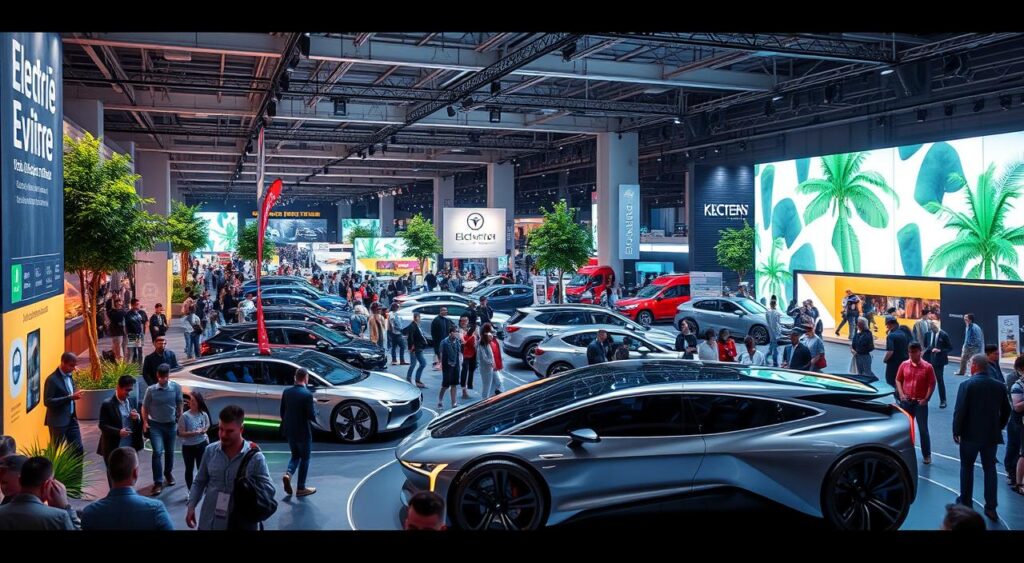
The expo focused a lot on clean emissions and electric vehicles. It showcased many electric cars, showing India’s aim for a greener future. The government’s PLI scheme has helped a lot, creating jobs and boosting sales.
Impressive Growth and Investment
The automotive industry in India has grown a lot, with sales up by about 12 percent. The demand for cars keeps going up. The government’s help has brought in over USD 36 billion in FDI in the last four years.
Electrification and Infrastructure Development
The government is serious about making cars electric. They’ve set aside INR 18,000 crore for electric battery storage. They’re also spending a lot on roads, with INR 11 lakh crore for highways and expressways. Over 70,000 fast chargers are being put up across the country.
| Scheme | Impact |
|---|---|
| PLI Scheme | Generated over Rs 2.25 lakh crore in sales and created more than 1.5 lakh direct jobs |
| FAME-2 Scheme | Subsidized the purchase of over 16 lakh EVs, including 5,000 electric buses |
The government said the Bharat Mobility Expo will now happen every year. This shows their commitment to the industry’s growth. As India moves towards cleaner cars, the government’s support will be key in shaping the future of mobility.
The Power of Social Media in Promoting Bharat Mobility Expo
Social media was key in getting the word out about the Bharat Mobility Expo 2025. With nearly two-thirds of India’s population under 35, young influencers helped spread the news fast. They used various digital platforms to create excitement.
Influencer marketing played a big role. News about the expo spread quickly, reaching millions. Digital marketing strategies, aimed at the tech-savvy youth, drew a huge crowd.

Big automotive brands also helped boost the event’s social media presence. They used their online followers to build anticipation for their new products. Here’s a look at the social media buzz during the expo:
| Platform | Hashtag Mentions | Impressions |
|---|---|---|
| 1.2 million | 50 million | |
| 800,000 | 30 million | |
| 1.5 million | 75 million |
The Bharat Mobility Expo 2025 showed the power of social media promotion and digital marketing. As India keeps embracing technology, social media’s role will only grow. It will shape public opinion and drive participation more than ever.
Evolution of the Auto Expo into Bharat Mobility Expo
The Auto Expo in India has changed into the Bharat Mobility Expo. This change shows how the car industry is evolving. The Bharat Mobility Expo 2025, from January 17 to January 22, brought new car tech to the table. It drew over 5,100 international guests and is expected to welcome 500,000 visitors.
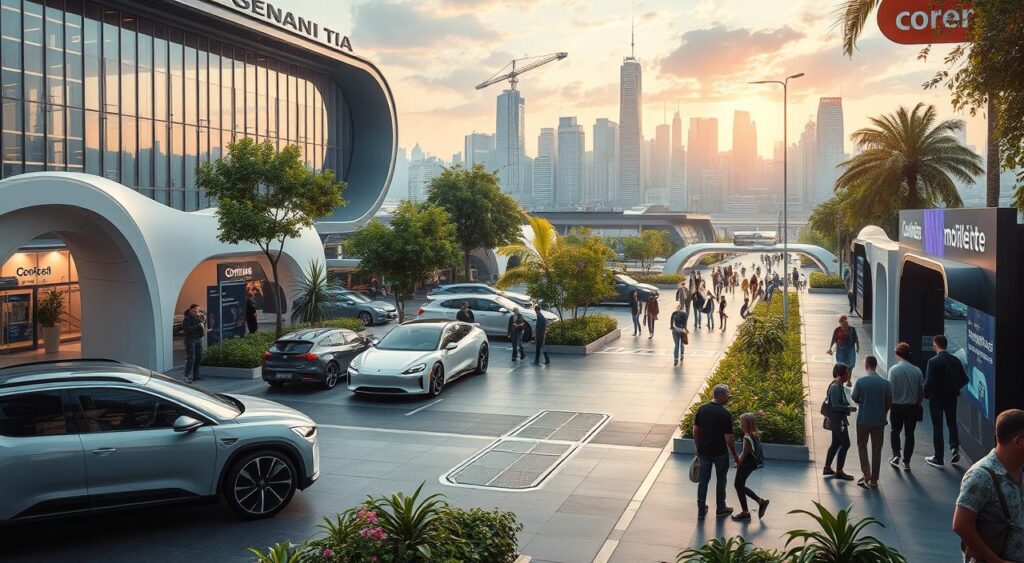
Decentralization of Venues for Better Focus
The Bharat Mobility Expo now has different venues for each part of the car industry. Cars are shown at Bharat Mandapam in Pragati Maidan. Components are at Yashobhoomi in Dwarka, and a third spot is at the India Expo Centre & Mart in Greater Noida. This change helps avoid overcrowding and keeps places clean.
Improved Accessibility and Hygiene
The new setup makes it easier for people to get around and keeps things clean. The car industry is focusing more on being green and clean. This expo’s cleanliness and ease of access make it better for everyone.
| Venue | Focus |
|---|---|
| Bharat Mandapam, Pragati Maidan | Vehicles |
| Yashobhoomi, Dwarka | Component Makers |
| India Expo Centre & Mart, Greater Noida | Additional Venue |
The Bharat Mobility Expo 2025 is a big step forward for car shows in India. It shows India’s growing role in green car tech. With over 100 new car and tech launches, it shows India’s big plans for the future.
Impressive Participation from Major Brands
The Bharat Mobility Expo 2025 was a huge success. Over 1,500 exhibitors from across the industry showed off their latest innovations. The event, held from January 17 to January 22, 2025, covered 200,000 square meters. It attracted over 500,000 visitors, making it a hit.
On the first two days, 90 new products were launched. On the second day alone, 56 new products from 22 brands were unveiled at Bharat Mandapam. An extra 5 launches happened at Yashobhoomi, Dwarka, showing the event’s importance.
Strong Presence of Two-Wheeler Manufacturers
Two-wheeler leaders like Hero MotoCorp, TVS Motor, and Bajaj Auto were there. Honda, Suzuki, and Yamaha also showcased their latest models. Hyundai Motor Company even launched 2 concept models for last-mile mobility, showing its growing importance.
| Manufacturer | Product Launch | Price (ex-showroom) |
|---|---|---|
| BMW | X3 | Rs. 75,80,000 – Rs. 77,80,000 |
| BMW | S 1000 RR | Starting from Rs. 21,10,000 |
| BMW | R 1300 GS Adventure | Starting from Rs. 22,95,000 |
| Omega Seiki Pvt. Ltd. | M1KA 1.0 electric truck | INR 6,99,000 |
Showcasing Electrification Efforts
Electrification was a big focus at the Bharat Mobility Expo 2025. VinFast introduced two EV models, the VF 7 and VF 6, for the Indian market. BYD India showed the fully electric Sealion 7 eSUV. JBM Electric and Eka Mobility presented electric buses, showing a shift towards electric in public transport.
India’s first solar electric car, ‘Eva,’ was also launched. Prices ranged from Rs 3.25 lakh to Rs. 5.99 lakh (ex-showroom). The expo showed the Indian auto industry’s growth and commitment to innovation and sustainability. Events like this will shape the future of mobility in India.
The Rise of Indian Startups in the Mobility Landscape
The entrepreneurial spirit of Indian startups has been a driving force in the mobility landscape. This is true, mainly in the realm of electric two-wheelers. At the Bharat Mobility Expo 2025, these innovative companies have taken center stage. They showcased their cutting-edge products and solutions alongside industry giants.
Ola Electric and Ather are standout performers in the electric two-wheeler segment. Their presence at the expo highlights the growing importance of Indian startups in shaping the future of mobility.
The expo also featured an impressive array of electric two-wheelers from other homegrown brands like TVS and Bajaj Auto. These companies have embraced the shift towards sustainable mobility. They have developed innovative products that cater to the evolving needs of Indian consumers.
| Startup | Product Showcase |
|---|---|
| Ola Electric | Next-generation electric scooters |
| Ather | Smart electric scooters with advanced features |
| TVS | Range of electric and flex-fuel vehicles |
| Bajaj Auto | Innovative electric two-wheelers |
The success of these Indian startups can be attributed to their agility, innovation, and deep understanding of the local market. By leveraging technology and focusing on user experience, they have been able to carve out a niche for themselves in the competitive mobility landscape.
As the demand for sustainable transportation solutions continues to grow, the role of Indian startups in the electric two-wheeler segment is set to become even more prominent. With their entrepreneurial spirit and commitment to innovation, these companies are poised to lead the charge in the ongoing revolution in the mobility landscape.
Bharat Mobility Expo 2025: A Reflection of India’s Growing Confidence
The Bharat Mobility Expo 2025 shows India’s growing confidence despite global challenges. India has shown great resilience and confidence. This is thanks to the positive messaging from leaders, showing a bright future for India.
The expo highlights India’s ability to face global ups and downs. It has over 800 exhibitors and 1.5 lakh visitors each year. It’s a key event for the growth and innovation in the automotive and mobility sectors.
Resilience in the Face of Global Challenges
India’s car industry has grown 12% in the last year, showing great resilience. The growing middle class has increased demand for cars. This has led to over 2.5 crore cars sold each year.
The government’s focus on infrastructure has helped the industry grow. The PLI scheme has boosted sales and created jobs. India has also attracted over 36 billion dollars in foreign investment, showing it’s a great place to invest.
Positive Messaging from Policymakers
The positive messaging from leaders has boosted confidence. The push for clean emissions and electric vehicles has seen a huge increase in sales. Electric vehicle sales have grown 640 times in the last decade.
Initiatives like FAME-2 have supported over 16 lakh electric vehicles. The Indian government’s use of over 1,200 electric buses in Delhi shows its commitment to green transport.
The Bharat Mobility Expo 2025 is a showcase of India’s growing confidence, resilience, and positive outlook. It highlights India’s focus on innovation, sustainability, and self-reliance. The expo is a beacon of India’s bright future in the automotive and mobility sectors.
Conclusion
The Bharat Mobility Expo 2025 has ended, but the future of mobility in India looks bright. Over 1,000 exhibitors from seven countries showcased their latest in sustainable transport and car tech. More than 50,000 visitors, including global leaders, saw the innovations.
With 60+ new products launched, India is serious about cleaner, greener transport. This shows India’s dedication to a greener future. The auto parts sector aims to hit $100 billion in exports in ten years. They also want to use AI for better quality and precision.
The expo was a big success, showing India’s confidence in leading mobility’s future. It was not just a showcase but a sign of India’s growing role globally. The nine shows at the expo gave a full view of the industry’s future.
With government support, Indian startups, and big brands on board, India is ready to lead. The Bharat Mobility Expo 2025 may be over, but the journey to change how we move is just starting.
FAQ
What is the significance of the Bharat Mobility Expo 2025?
The Bharat Mobility Expo 2025 is India’s biggest car show. It shows the future of moving around and makes India a big player in cars and energy. It also shows India’s push for green cars and clean transport.
How has India’s automotive industry grown over the years?
India is now a top carmaker, after China and the US. It makes over four million cars a year. The car and bike world in India has grown a lot, thanks to more cars and bikes being made, and a strong parts industry.
What role does the Indian government play in supporting the automotive industry?
The Indian government really supports cars and bikes. Prime Minister Narendra Modi’s visit to the Bharat Mobility Expo 2025 was a big boost. The government wants clean cars, electric ones, and has made the expo an annual event.
How did social media contribute to the promotion of the Bharat Mobility Expo 2025?
Social media was key in getting the word out about the Bharat Mobility Expo 2025. Young influencers shared updates fast on different platforms. This showed how social media can help spread news quickly.
What changes were made to the Auto Expo format in the Bharat Mobility Expo?
The Auto Expo has changed to the Bharat Mobility Expo. Now, it’s held in different places for better focus and easier access. These changes help avoid problems like too many people and not being clean, making the event better.
Which major brands participated in the Bharat Mobility Expo 2025?
Big names like Hero MotoCorp, TVS Motor, and Honda were at the Bharat Mobility Expo 2025. They showed off their bikes and scooters and talked about going electric.
What role do Indian startups play in the mobility landscape?
Indian startups are big in the car world, mainly in electric bikes. Companies like Ola Electric and Ather are showing off new ideas at the Bharat Mobility Expo 2025. They help make electric cars more popular in India.
How does the Bharat Mobility Expo 2025 reflect India’s confidence in the face of global challenges?
The Bharat Mobility Expo 2025 shows India’s confidence, even with tough times like a weak rupee and jobs being hard to find. India is showing it can handle challenges and is looking forward to a brighter future.
What is the future of mobility in India?
The Bharat Mobility Expo 2025 is setting the stage for a big change in how we move around. With big brands, startups, and government support, India is ready to lead in clean, green transport. It’s all about innovation, new ideas, and a green future.
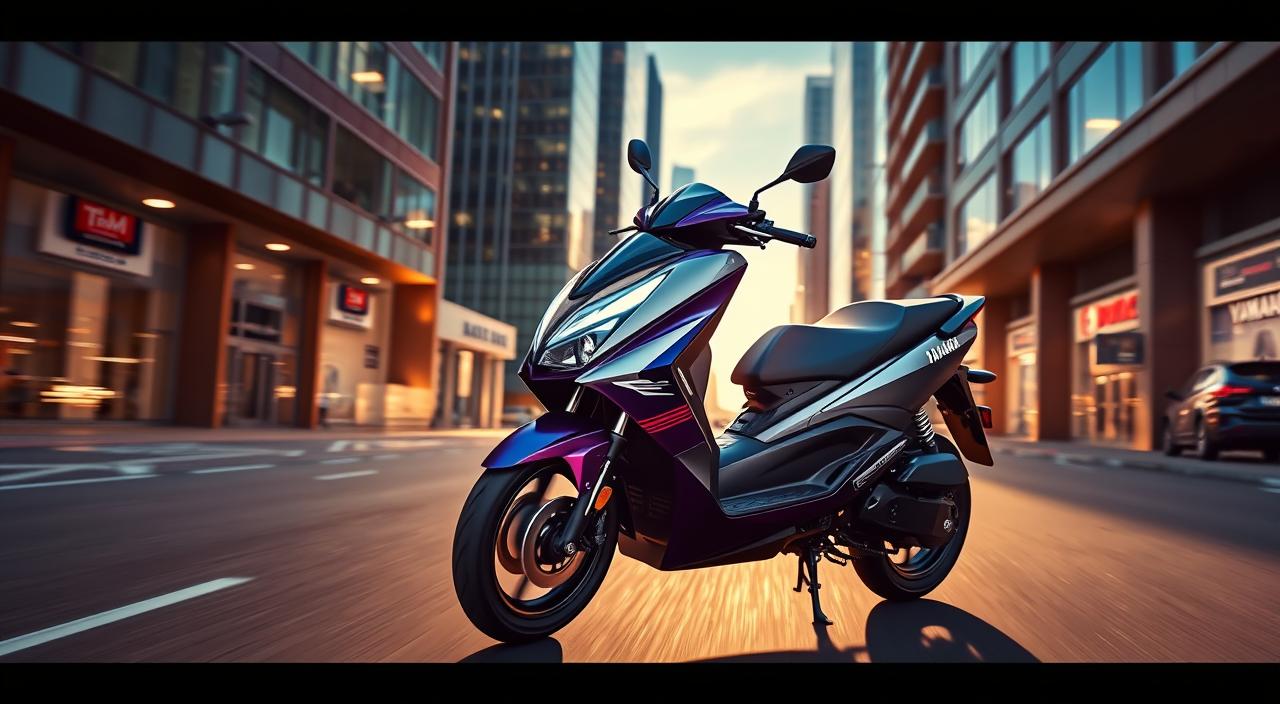
Jan
The Yamaha Aerox 155 is a game-changer in the scooter market. It has a 155cc liquid-cooled engine, similar to the Yamaha R15. This scooter packs 15 bhp of power at 8000 rpm and 13.9 Nm of torque at 6500 rpm. It’s the most powerful scooter in its class, giving riders an exciting ride.
The Aerox 155 has been popular in India for almost three years. It comes in three variants, priced from Rs 1.47 lakh to Rs 1.51 lakh (ex-showroom). It’s perfect for those who want both performance and style. It can easily hit 100 kmph on highways and is comfortable at 50-60 kmph in the city.
Safety is a big deal for Yamaha, and the Aerox 155 shows it. It has a front disc brake and rear drum brake for stopping power. It also has a traction control system and single-channel ABS for safety. The Aerox 155 Version S even has smart key convenience for easy access.
Despite its focus on performance, the Aerox 155 is great for daily rides. It gets about 40 kmpl and has a 5-liter fuel tank. It’s comfortable for both the rider and pillion, thanks to its step-up seat design. Plus, it has under-seat storage for your essentials.
Key Takeaways
- Yamaha Aerox 155 is a powerful 155cc scooter with a liquid-cooled engine derived from the Yamaha R15
- Delivers an impressive 15 bhp of power and 13.9 Nm of torque, making it the most powerful scooter in its segment
- Offers a perfect blend of performance and style, with prices ranging from Rs 1.47 lakh to Rs 1.51 lakh (ex-showroom)
- Equipped with advanced safety features such as a traction control system and single-channel ABS
- Provides a fuel efficiency of approximately 40 kmpl under standard conditions, making it a practical choice for daily commutes
Introduction to the Yamaha Aerox 155
The Yamaha Aerox 155 is a game-changing urban commuter scooter. It combines the practicality of a scooter with the power of a motorcycle. Yamaha’s flagship scooter in India, it has a 155cc liquid-cooled engine. This engine produces 11.8 hp and 11.3 Nm of torque, making it the most powerful in its class.
This scooter is inspired by motorcycles, blending style, comfort, and performance. It’s perfect for those who want a fun and practical ride. With a 4.3 out of 5 user rating from 93 reviews, it’s known for its comfort, design, and good mileage.
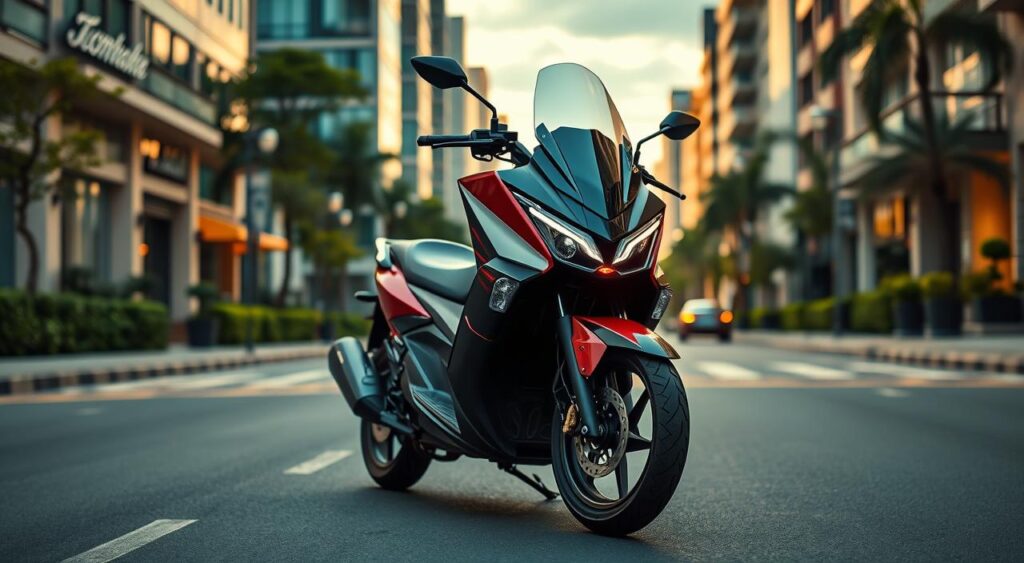
The Aerox 155 also comes with advanced tech like traction control and smartphone connectivity. But, some users mention higher maintenance costs and limited footpad space as downsides.
Compared to its rivals, the Yamaha Aerox 155 shines with its strong engine and fair price:
| Scooter | Price Range (INR) |
|---|---|
| TVS iQube | 1.07 – 1.85 Lakh |
| Bajaj Chetak (2020 – 2024) | 99,998 – 1.32 Lakh |
| Ola S1 Pro | 1.55 Lakh |
| Suzuki Burgman Street | 94,301 – 1.15 Lakh |
| Ather 450X | 1.47 – 1.77 Lakh |
| Simple One | 1.45 – 1.50 Lakh |
| Ather Rizta | 1.12 – 1.49 Lakh |
Design and Styling
The Yamaha Aerox 155 is a real head-turner. It has bold sporty looks and aggressive styling. This lightweight scooter weighs just 126 kg. It has a sleek, modern design that young riders love.
The scooter’s sharp lines and dual LED headlights make it stand out. Its aerodynamic front fairing adds to its unique look. The scooter’s small size makes it easy to move around in the city.
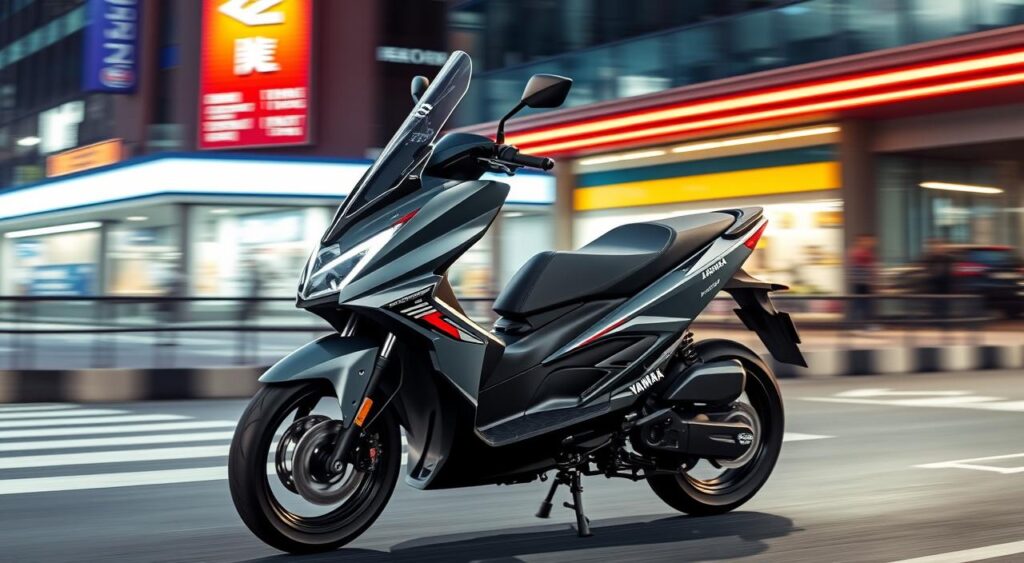
Sporty and Aggressive Looks
The Yamaha Aerox 155 is made to catch eyes. It has a sharp, angular front with dual LED headlights for a modern look. Its aerodynamic body and sleek tail add to its sporty vibe.
Compact and Lightweight Body
The Aerox 155 is known for its small and light body. It weighs just 126 kg, making it easy to handle. Its size is perfect for tight spaces in the city.
| Specification | Value |
|---|---|
| Kerb weight | 126 kg |
| Seat height | 790 mm |
| Ground clearance | 145 mm |
| Wheel size | 14-inch alloy wheels |
| Underseat storage capacity | 24.5 liters |
The Yamaha Aerox 155 is great for city streets. Its small size and light weight make it easy to handle. It’s perfect for tight spots and busy areas.
Engine and Performance
The Yamaha Aerox 155 is a compact and powerful scooter that offers an exciting ride. It has a 155cc liquid-cooled engine from the Yamaha R15. This engine makes 15 horsepower at 8,000 rpm and 14 Nm of torque, making it the top scooter in its class.
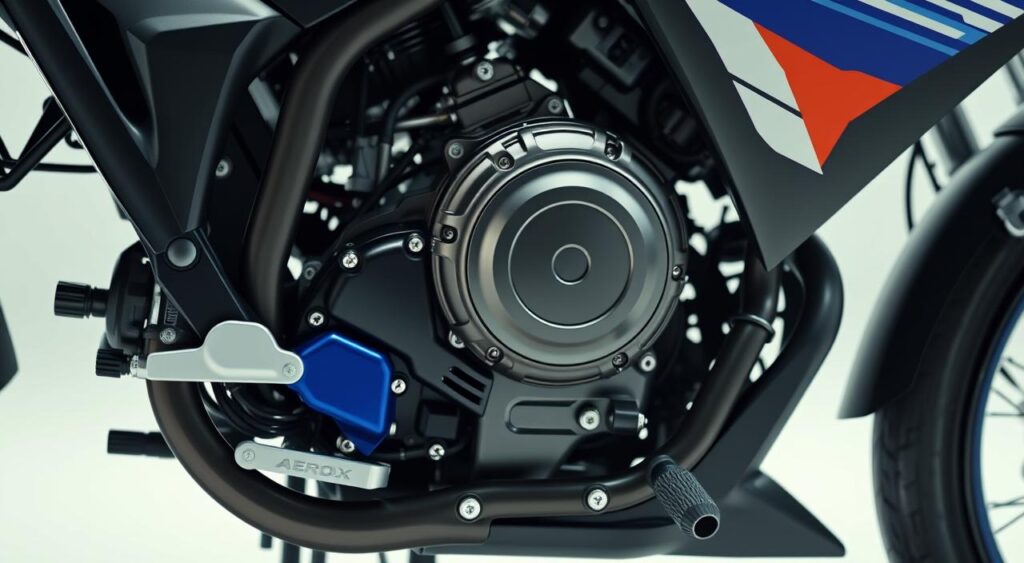
The Aerox 155 is fuel-efficient, getting around 40-46 km/l in daily use. This is thanks to Variable Valve Actuation (VVA) technology. It kicks in at about 5,000 rpm, boosting performance and saving fuel.
Impressive Power and Torque Figures
In our tests, the Yamaha Aerox 155 showed its strong side, reaching 115 km/h. It has 14.75 bhp at 8,000 rpm for a fun ride. Its 14 Nm of torque helps it accelerate quickly.
| Specification | Value |
|---|---|
| Engine Displacement | 155cc |
| Power Output | 15 horsepower |
| Maximum Torque | 14 Nm |
| Maximum Speed | 115 km/h |
Fuel Efficiency and Mileage
The Aerox 155’s performance is great, but it uses more fuel than some scooters. It’s about 10 km/l less efficient than the Ntorq. But, it has a 5.5-liter tank, giving it a range of about 253 km.
Over six months, I’ve taken the Aerox 155 on many trips. In Mumbai-Pune and Kandivali-Vashi, it’s been reliable. In Bangalore’s traffic, it gets 40-42 km/l, which is good for its power.
Yamaha Aerox 155 Features and Technology
The Yamaha Aerox 155 is a scooter packed with style, performance, and tech. It’s small but powerful, with features that make riding safer and more fun. It’s perfect for city streets or longer trips.
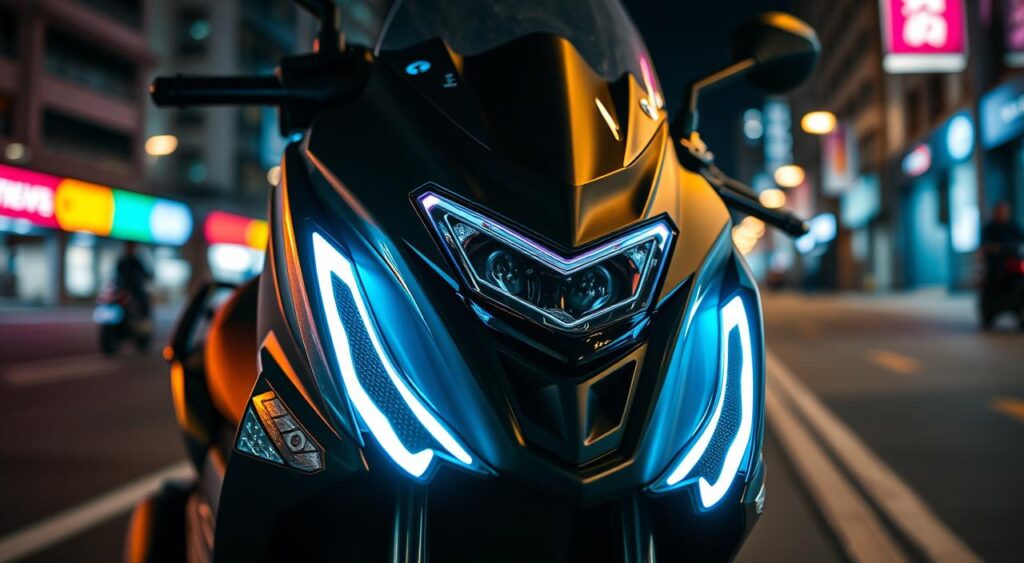
Digital Instrument Cluster with Bluetooth Connectivity
The Aerox 155’s digital cluster shows speed, fuel, and trip info. It also has bluetooth connectivity. This lets riders check their phone without taking their hands off the handlebars.
Traction Control System for Enhanced Safety
Riding safely is key, and the Aerox 155 has a top-notch traction control system. It keeps the scooter stable on slippery roads. The system works with single-channel ABS for better braking and safety.
LED Lighting and External Fuel Filling
The Aerox 155 looks sleek with its LED lighting. Its lights are bright and stylish. Plus, refueling is easy with an external fuel cap.
Other cool features of the Yamaha Aerox 155 include:
| Feature | Specification |
|---|---|
| Engine Displacement | 155cc |
| Maximum Power | 15PS at 8,000 rpm |
| Peak Torque | 13.9 Nm at 6,500 rpm |
| Fuel Capacity | 5.5 liters |
| Under-seat Storage | 24.5 liters |
| Weight | 126 kg |
The Yamaha Aerox 155 is a complete package. It’s stylish, performs well, and is convenient. It’s great for city rides or longer adventures.
Riding Experience and Handling
The Yamaha Aerox 155 offers a thrilling ride. It combines the agility of a scooter with the power of a motorcycle. Its sharp handling and stability make it fun to ride, whether in the city or on the highway.
On a recent 1,800 km ride over three days, the Aerox 155 shone. It averaged 85 to 95 km/h, reaching 100 km/h on some parts. A 46-year-old rider, 5’10” and 84 kg, felt no tiredness after 12 hours, showing its comfort.
The Aerox 155’s firm suspension helps with sharp handling. It allows for precise turns and confident corners. While some might find it firmer, it balances comfort and performance well.
The scooter’s fuel efficiency is impressive. It got up to 40 km/l and as low as 31 km/l. Its 5.5-liter tank means you can go about 100 km before refueling. During the ride, the rider stopped 12 times, each stop under 5 minutes.
The brakes, with a 230mm disc up front and a 130mm drum rear, stop well. Yet, they could offer better feel and feedback for a better ride.
In summary, the Yamaha Aerox 155 is great. It has sharp handling, high-speed stability, and a firm suspension. It’s perfect for those looking for a powerful yet compact scooter.
Comparing the Aerox 155 with Its Rivals
The Yamaha Aerox 155 faces tough competition in the premium scooter market. Let’s see how it compares to some of its main rivals.
Aprilia SXR 160
The aprilia sxr 160 is a big competitor to the Aerox 155. It costs ₹1.27 lakh (ex-showroom) and has a 160.03 cc engine. This engine makes 10.84 bhp of power and 11.6 Nm of torque.
Even though the Aerox 155 has more power, the SXR 160’s design and features are attractive. It’s a great choice for those who value style.
Vespa VXL 150
The vespa vxl 150 is famous for its classic design and comfortable ride. It’s a top pick for those who love style and comfort over speed.
Electric Scooter Alternatives
For those who care about the environment, electric scooters like the Ola S1 Pro and Ather 450X are worth considering. They’re pricier than the Aerox 155 but offer a clean ride. They also have great performance and features.
| Model | Price (ex-showroom) | Engine Displacement | Power Output | Torque |
|---|---|---|---|---|
| Yamaha Aerox 155 | ₹1.38 lakh | 155cc | 15 PS | 13.9 Nm |
| Aprilia SXR 160 | ₹1.27 lakh | 160.03 cc | 10.84 bhp | 11.6 Nm |
| Suzuki Burgman Street | ₹85,100 – ₹88,600 | 124cc | 8.7 PS | 10 Nm |
Choosing between the Yamaha Aerox 155 and its rivals depends on what you want. The Aerox 155 is great for performance and features. But, the aprilia sxr 160, vespa vxl 150, and electric scooters have their own unique benefits. It’s all about what you value most.
Conclusion
The Yamaha Aerox 155 is a standout in India with its sporty look and strong performance. It has a 155cc engine that gives 15 bhp of power and 13.90 Nm of torque. This makes it a fun ride for city trips and more.
It can go at about 70 kmph naturally and can hit 100 kmph at its fastest. This beats most standard CVT scooters in speed.
The Aerox 155 is small but has big features like a Bluetooth instrument cluster and automatic start/stop. It also has single-channel ABS and a multi-function key. The under-seat storage is 24.5 liters, perfect for daily needs, and there’s a 12V charging socket in the glovebox for extra convenience.
But, the fuel tank’s spot might make it hard for some riders to move their feet. Those over 6 feet might find it hard to fit comfortably.
Even though it’s great in performance, it’s not the most comfy on bad roads. The brakes work well, but you need to be careful with the throttle to stay at 60 kmph. It comes in three colors and starts at ₹1,29,000 (ex-Delhi). It’s a good pick for those wanting a fast scooter for city rides and weekend fun.
FAQ
What makes the Yamaha Aerox 155 stand out among other scooters?
The Yamaha Aerox 155 is the most powerful scooter in its class. It has a 155cc engine, just like the Yamaha R15 motorcycle. Its sporty look, light weight, and advanced features make it a top pick for those who want both performance and style.
What is the price range of the Yamaha Aerox 155?
The Yamaha Aerox 155 has three models, priced from Rs. 1,48,400 to Rs. 1,51,700. These prices are ex-showroom, in Delhi.
How powerful is the engine of the Yamaha Aerox 155?
The Yamaha Aerox 155’s engine is a 155cc, liquid-cooled, single-cylinder unit. It produces 15PS of power at 8000rpm and 13.9Nm of torque at 6500rpm.
What is the fuel efficiency of the Yamaha Aerox 155?
Despite its strong engine, the Yamaha Aerox 155 is fuel-efficient. It gets 48.62 kmpl, thanks to its advanced engine tech.
What are some of the key features of the Yamaha Aerox 155?
The Yamaha Aerox 155 has a digital instrument cluster with Bluetooth. It also has a traction control system, LED lights, and an external fuel filler cap. Other features include a side-stand engine cut-off and a front storage pocket with an optional USB charger.
How does the Yamaha Aerox 155 handle in urban environments?
The Yamaha Aerox 155 is easy to handle in cities. Its compact size and light weight make it agile. It also handles high speeds well, giving riders confidence.
What are the main competitors of the Yamaha Aerox 155?
The main rival of the Yamaha Aerox 155 is the Aprilia SXR 160. It offers similar performance and style. Other competitors include the Vespa VXL 150 and electric scooters like the Ola S1 Pro and Ather 450X.

Jan
In the world of compact SUVs, the Volkswagen Taigun and Kia Sonet are at the forefront. The Kia Sonet’s popularity is evident, with 80% of buyers choosing a sunroof. This shows that Indian buyers want top-notch features in their SUVs. Let’s compare these two vehicles, looking at their performance, features, and value in India for 2022.
The compact SUV market is booming, with the Taigun and Sonet leading the way. The Taigun starts at Rs 11.70 Lakh, while the Sonet begins at Rs 7.51 Lakh. But, it’s not just about the price. The Taigun has a powerful engine, and the Sonet offers great fuel efficiency.
Key Takeaways
- Volkswagen Taigun and Kia Sonet are two popular compact SUVs in India, with many features and specs.
- The Taigun is pricier but has a stronger engine, while the Sonet is cheaper and fuel-efficient.
- Both offer automatic transmissions but no diesel engines.
- The comparison also includes rivals like Skoda Kushaq, Hyundai Creta, Tata Nexon, and Kia Seltos in similar price ranges.
- Kia Sonet has hit 1 Lakh sales, with 80% of buyers choosing a sunroof.
Overview of the Compact SUV Segment
The compact SUV segment has seen a big rise in popularity. It attracts car buyers worldwide. These cars mix practicality, affordability, and modern features, appealing to many.
What Makes Compact SUVs Popular?
Compact SUVs are popular for several reasons. Their small size makes them easy to drive in cities. They also offer a lot of space for people and things. Plus, they’re priced well, reaching more people. And, they come with cool features and tech, making them even more appealing.
The Rise of Volkswagen Taigun
The Volkswagen Taigun is a big hit in the compact SUV world. It starts at Rs 11.70 Lakh for the 1.0 Comfortline (Petrol) model. It has a powerful 1.5-litre TSi engine. It also has automatic transmission, making driving a joy.
The Appeal of Kia Sonet
The Kia Sonet is another top choice in compact SUVs. It starts at Rs 8 Lakh for the HTE (Petrol) model. It has various engine options, including diesel. Its stylish look, feature-rich interior, and good price make it popular.
Here’s a comparison of the Volkswagen Taigun and Kia Sonet:
| Specification | Volkswagen Taigun | Kia Sonet |
|---|---|---|
| Starting Price (ex-showroom) | Rs 11.70 Lakh | Rs 8 Lakh |
| On-road Price | Rs 22,81,670* | Rs 17,19,635* |
| Engine Capacity (Petrol Top Model) | 1498 cc | 1493 cc |
| Mileage (Petrol Top Model) | 19.87 kmpl | 24.1 kmpl |
| Transmission Options | Automatic with both engine options | 5 transmission options |
As the compact SUV market grows, cars like the Volkswagen Taigun and Kia Sonet lead the way. They set high standards in design, performance, and features, attracting many buyers.
Design and Aesthetics
The Volkswagen Taigun and Kia Sonet have different designs. The Taigun looks classy and sophisticated, fitting Volkswagen’s style. It has clean lines, an elegant grille, and refined proportions.
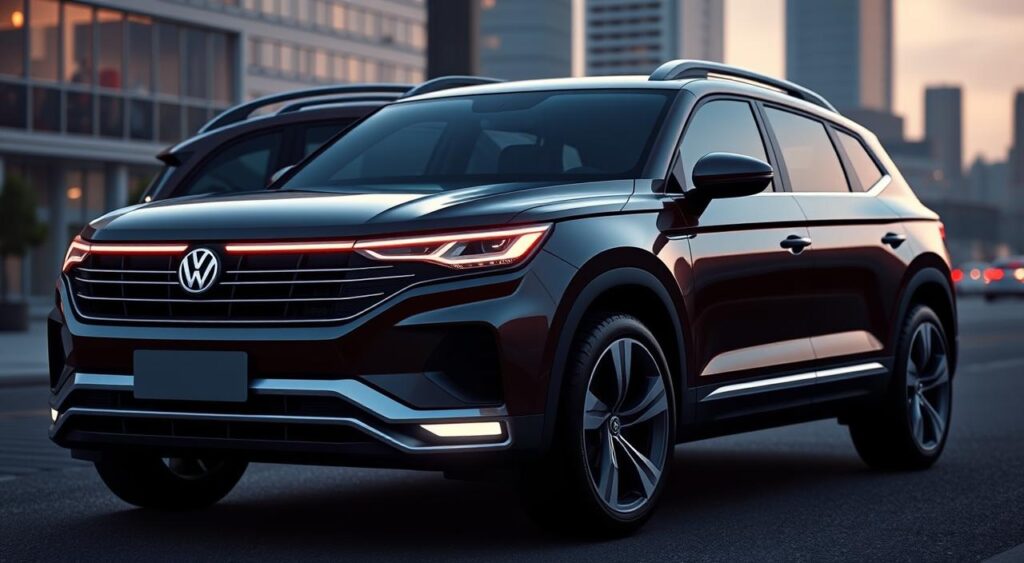
The Sonet, on the other hand, is bold and sporty. It has a muscular stance and dynamic lines. Features like the tiger-nose grille and sharp LED headlights make it eye-catching.
Interior Style and Comfort
Inside, both SUVs focus on style and comfort. They use premium materials and have soft-touch surfaces. The ergonomics are thoughtful, making the cabin experience pleasant.
| Feature | Volkswagen Taigun | Kia Sonet |
|---|---|---|
| Upholstery | Leatherette | Leatherette |
| Climate Control | Automatic | Automatic |
| Infotainment | 10.1-inch touchscreen | 10.25-inch touchscreen |
| Digital Instrument Cluster | 8-inch | 4.2-inch |
| Seating Capacity | 5 | 5 |
| Boot Space | 385 litres | 392 litres |
Both SUVs have spacious cabins with plenty of room. The seats are comfortable, making long rides enjoyable. They also have features like ventilated front seats, a panoramic sunroof, and ambient lighting for a luxurious feel.
Performance Comparison
Both the Volkswagen Taigun and Kia Sonet are high performers. The Taigun has a 1.0-litre TSI engine, while the Sonet offers petrol and diesel engines. Let’s explore their engines and how they drive.
Engine Specifications
The Volkswagen Taigun has a 1.0-litre TSI engine. It makes 114 bhp and 178 Nm of torque. The Kia Sonet has a 1.2-litre petrol and a 1.5-litre diesel engine. The petrol engine makes 82 bhp and 115 Nm of torque. The diesel engine makes 99 bhp and 240 Nm of torque.
| Specification | Volkswagen Taigun | Kia Sonet |
|---|---|---|
| Engine Displacement | 999 cc | 1197 cc (petrol), 1493 cc (diesel) |
| Peak Power Output | 114 bhp @ 5000-5500 rpm | 82 bhp @ 6000 rpm (petrol), 99 bhp @ 4000 rpm (diesel) |
| Peak Torque | 178 Nm @ 1750-4500 rpm | 115 Nm @ 4200 rpm (petrol), 240 Nm @ 1500-2750 rpm (diesel) |
Driving Dynamics
The Volkswagen Taigun is fun to drive. It has responsive steering and a well-tuned suspension. It’s agile and easy to handle, making city driving a pleasure.
The Kia Sonet offers a balanced ride. It’s comfortable and handles well. The steering is light, making city driving easy.
Both cars have manual and automatic transmission options. The Taigun’s transmissions are smooth and precise. The Sonet’s transmissions offer a seamless drive.
Technology and Infotainment Systems
Both the Volkswagen Taigun and Kia Sonet have cool tech features. They make driving more fun and convenient. These features keep you connected, entertained, and informed while you’re on the move.
Volkswagen Taigun’s Tech Offerings
The Volkswagen Taigun has an 8-inch touchscreen. It’s easy to use and connects to your phone smoothly. You can access apps, music, and maps easily.
It also has a digital instrument cluster. This shows you important info quickly and clearly.
Kia Sonet’s Infotainment Features
The Kia Sonet has a 7-inch touchscreen. It’s just as easy to use as the Taigun’s. It supports Apple CarPlay and Android Auto for a smooth phone connection.
It also has a wireless charging pad. This means you can charge your phone without any cables.

Both SUVs have great sound systems. They have 6 speakers each. This makes music and podcasts sound amazing.
| Feature | Volkswagen Taigun | Kia Sonet |
|---|---|---|
| Touchscreen Display Size | 8 inches | 7 inches |
| Smartphone Connectivity | Apple CarPlay, Android Auto | Apple CarPlay, Android Auto |
| Number of Speakers | 6 | 6 |
| Wireless Charging | Not Available | Available |
Both SUVs make it easy to stay connected. They have voice commands and controls on the steering wheel. This lets you use your favorite features without taking your hands off the wheel.
Safety Features and Ratings
Safety is key in the compact SUV market. The Volkswagen Taigun and Kia Sonet both focus on keeping drivers and passengers safe.
Volkswagen Taigun Safety Innovations
The Volkswagen Taigun comes with advanced safety features. These include:
- 6 airbags (Driver, Front Passenger, 2 Curtain, Driver Side, Front Passenger Side)
- Anti-lock Braking System (ABS) with Electronic Brake-force Distribution (EBD)
- Electronic Stability Control (ESC)
- Speed sensing door lock
- Overspeed warning: triggers 1 beep over 80 km/h and continuous beeps over 120 km/h
- Tyre Pressure Monitoring System (TPMS)
- Child seat anchor points
The Taigun’s safety features are expected to do well in crash tests. It has not been tested by Global NCAP yet.
Kia Sonet’s Safety Technologies
The Kia Sonet also has a lot of safety features. These include:
- 6 airbags (Driver, Front Passenger, 2 Curtain, Driver Side, Front Passenger Side)
- Anti-lock Braking System (ABS) with Electronic Brake-force Distribution (EBD)
- Electronic Stability Control (ESC)
- Speed sensing door lock
- Overspeed warning: triggers 1 beep over 80 km/h and continuous beeps over 120 km/h
- Tyre Pressure Monitoring System (TPMS)
- Child seat anchor points
The Kia Sonet has earned a 5-star safety rating from Global NCAP. This makes it one of the safest compact SUVs out there.
Both the Volkswagen Taigun and Kia Sonet focus on keeping people safe. Here’s a comparison of their safety features:
| Safety Feature | Volkswagen Taigun | Kia Sonet |
|---|---|---|
| NCAP Rating | Not tested | 5 Stars (Global NCAP) |
| Number of Airbags | 6 | 6 |
| Warranty Duration | 3 years | 4 years |
| Warranty Mileage | Unlimited | 100,000 km |
Even though they have similar safety features, the Kia Sonet’s 5-star Global NCAP rating gives it an edge. This rating shows it can protect occupants in crashes.
Space and Practicality
Compact SUVs need to be roomy and practical. The Volkswagen Taigun and Kia Sonet are great in this area. They offer lots of space for both people and stuff. Let’s look at how they meet your needs.
Dimensions and Cargo Space
The Taigun and Sonet are big for their size. The Taigun’s trunk is smaller but can hold a lot of luggage. The Sonet has a bigger trunk, with 500 liters of space. This means you can carry all your essentials easily.

| Dimension | Volkswagen Taigun | Kia Sonet |
|---|---|---|
| Length | 4,221 mm | 4,120 mm |
| Width | 1,760 mm | 1,790 mm |
| Height | 1,612 mm | 1,618 mm |
| Wheelbase | 2,651 mm | 2,500 mm |
Passenger Comfort in Both SUVs
Comfort is key, whether you’re on a long trip or driving around the city. The Taigun and Sonet make sure everyone is comfortable. They have enough legroom and headroom.
Both SUVs have adjustable seats for the driver and front passenger. The back seats are also spacious, but fitting three adults might be a bit tight. The Taigun has adjustable headrests for the rear seats. The Sonet has even more adjustable features for the backrest and headrest.
Driving Experience and Handling
Both the Volkswagen Taigun and Kia Sonet offer unique driving experiences. They cater to different preferences. Let’s explore how these compact SUVs handle on the road.
Taigun’s Ride Quality
The Volkswagen Taigun provides a refined and comfortable ride. Its suspension absorbs bumps and uneven roads smoothly. This ensures a smooth journey for passengers.
During my 6 months and 6,000 km with the Taigun, I loved its plush ride. The steering is precise and well-weighted. It offers excellent feedback and control.
Whether in city traffic or on highways, the Taigun feels confident. Its suspension balances comfort and stability. It minimizes body roll and feels planted even during spirited driving.
Sonet’s Handling Characteristics
The Kia Sonet has a firmer suspension than the Taigun. This makes for a more engaging and sporty drive. Its suspension is tuned for agility on twisty roads.
The Sonet’s steering is quick and accurate. It provides precise inputs and feedback. The firm suspension minimizes body roll, keeping the Sonet composed during aggressive cornering.
While the ride is firmer than the Taigun’s, it’s not uncomfortable. It balances sportiness and comfort well.
| Feature | Volkswagen Taigun | Kia Sonet |
|---|---|---|
| Steering Adjustment | Manual Tilt & Telescopic | Tilt only |
| Tire Pressure Monitoring System (TPMS) | Available | Available |
Both SUVs have essential safety features like TPMS. The Taigun also has manual tilt and telescopic steering. This allows drivers to find their perfect driving position.
The choice between the Taigun’s comfort and the Sonet’s handling depends on personal preference. The Taigun is great for those who value comfort. The Sonet is ideal for driving enthusiasts seeking a more engaging experience.
Fuel Efficiency
Both the Volkswagen Taigun and Kia Sonet are known for their fuel efficiency. The Taigun’s 1.5-litre TSI petrol engine gets around 17-19 kmpl. This is great for saving on fuel costs. The Sonet, with its petrol and diesel engines, offers a mileage of 18-24 kmpl. This depends on the variant and how you drive.

Taigun’s Average Mileage
The Volkswagen Taigun has a 1.5-litre TSI petrol engine. It claims an ARAI-claimed mileage of 17 kmpl. This means you can drive about 850 km on a 50-litre tank.
In real life, drivers get around 15-16 kmpl in the city. On highways, it’s 18-19 kmpl. This is impressive for a compact SUV.
Sonet’s Fuel Economy
The Kia Sonet offers petrol and diesel engines. The 1.2-litre petrol engine gets 19.89 kmpl. The 1.5-litre diesel engine is even better, with up to 24 kmpl.
With a 50-litre tank, the Sonet can go up to 995 km on one tank. This makes it perfect for long trips.
| Model | ARAI Mileage (kmpl) | Driving Range (km) | Fuel Tank Capacity (L) |
|---|---|---|---|
| Volkswagen Taigun | 17 | 850 | 50 |
| Kia Sonet | 19.89 | 995 | 50 |
| Tata Nexon | 17.44 | 767 | 44 |
Compared to the Tata Nexon, the Taigun and Sonet are more fuel-efficient. The Nexon gets 17.44 kmpl and 16.38 kmpl in the city. The Taigun and Sonet offer better mileage. They are great for those who want a stylish SUV without spending too much on fuel.
Pricing and Value for Money
Choosing the right compact SUV means looking at price and value. The Volkswagen Taigun and Kia Sonet are top picks. They offer great features and are affordable.
Taigun Pricing Breakdown
The Volkswagen Taigun starts at ₹10,89,000 for the Comfortline. It goes up to ₹18,69,000 for the GT Plus Sport. Here’s a look at the Taigun’s prices:
| Variant | Price (Ex-Showroom) |
|---|---|
| Comfortline | ₹10,89,000 |
| Highline | ₹13,38,000 – ₹14,83,000 |
| Highline Plus | ₹14,26,900 – ₹15,36,900 |
| GT Line | ₹14,66,900 – ₹15,76,900 |
| Topline | ₹16,47,900 – ₹17,87,900 |
| GT (150PS) | ₹16,77,400 |
| GT Plus (150PS) | ₹17,19,000 |
| GT Plus Sport (150PS) | ₹17,49,000 |
| GT | ₹15,99,000 |
| GT Plus | ₹18,39,000 |
| GT Plus Sport | ₹18,69,000 |
The Taigun has many variants for different budgets. Here are some popular prices:
- 1.0L Turbo Petrol Comfortline: ₹11,55,900
- 1.0L Turbo Petrol Topline: ₹15,65,900
- 1.5L Turbo Petrol GT: ₹15,95,900
- Automatic 1.0L Turbo Petrol Highline: ₹14,95,900
- Automatic 1.0L Turbo Petrol Topline: ₹17,15,900
- 1.5L Turbo Petrol GT Plus: ₹18,70,900
Sonet Cost Analysis
The Kia Sonet starts at ₹7,51,000 and goes up to ₹13,04,000. The HTK 1.0 Turbo 6MT variant is priced well, between ₹10,00,000 and ₹16,00,000. This makes it a great choice for those on a budget.
The Sonet is more affordable than the Taigun. Kia also offers benefits up to ₹2,50,000. This makes the Sonet even more appealing.
Both the Taigun and Sonet offer great value. The Taigun has a 5-star safety rating from Global NCAP. The Sonet gets high scores for comfort and value.
Choosing between the Taigun and Sonet depends on your budget and preferences. Both SUVs offer great features and value for money in the compact SUV segment.
Conclusion and Recommendations
After looking closely at the Volkswagen Taigun and Kia Sonet, we see they each have special qualities. The Taigun starts at ₹11.70 lakh and offers a luxury driving feel. It has a 1.0L TSI petrol engine that’s very efficient. It also has a 5-star safety rating and a big 10-inch touchscreen.
The Kia Sonet, starting at ₹8.66 lakh, is a budget-friendly choice. It doesn’t skimp on style or tech. It has engines that save fuel, and a big 10.25-inch touchscreen with a Bose sound system.
Which Compact SUV is Right for You?
When picking a compact SUV, think about your budget, how much you care about fuel, safety, and inside features. The Taigun is great for those who want a fun, feature-packed SUV. The Sonet is perfect for those who want a stylish, techy car without spending a lot.
Final Thoughts on Volkswagen Taigun vs Kia Sonet
In summary, both the Volkswagen Taigun and Kia Sonet are top picks in the compact SUV market. The Taigun is for those who want a premium, fun SUV. The Sonet is for those who want a stylish, techy car at a lower price.
Choosing between the two depends on what you value most and how much you can spend. By looking at this guide and comparing the Taigun and Sonet, you can pick the best SUV for you.
FAQ
Which compact SUV offers better value for money, the Volkswagen Taigun or Kia Sonet?
Both the Volkswagen Taigun and Kia Sonet are great choices in the compact SUV market. The Kia Sonet starts at Rs. 7.51 lakh, making it more affordable. The Taigun, priced at Rs. 11.70 lakh, offers a premium feel and a fun drive.
How do the Volkswagen Taigun and Kia Sonet compare in terms of engine performance and driving dynamics?
The Volkswagen Taigun has a powerful 1.5-litre TSI engine, known for its strong performance. The Kia Sonet offers petrol and diesel engines for a smooth ride. Both SUVs handle well, with precise steering and minimal body roll.
Which compact SUV offers better fuel efficiency, the Taigun or the Sonet?
The Taigun’s 1.5-litre TSI engine gets around 17-19 kmpl. The Sonet’s engines offer 18-24 kmpl, depending on the variant and driving. Both SUVs have good fuel economy, but the Sonet might have a slight edge.
How do the Taigun and Sonet compare in terms of interior space and comfort?
Both SUVs offer plenty of space for passengers and luggage. The Sonet has a slightly bigger boot. They both provide a comfortable ride, but fitting three adults in the back might be a bit tight.
Which compact SUV has better safety features, the Taigun or the Sonet?
The Taigun and Sonet both focus on safety, with features like airbags and electronic stability control. The Sonet has a 3-star safety rating from Global NCAP. Both SUVs are designed to keep their occupants safe.
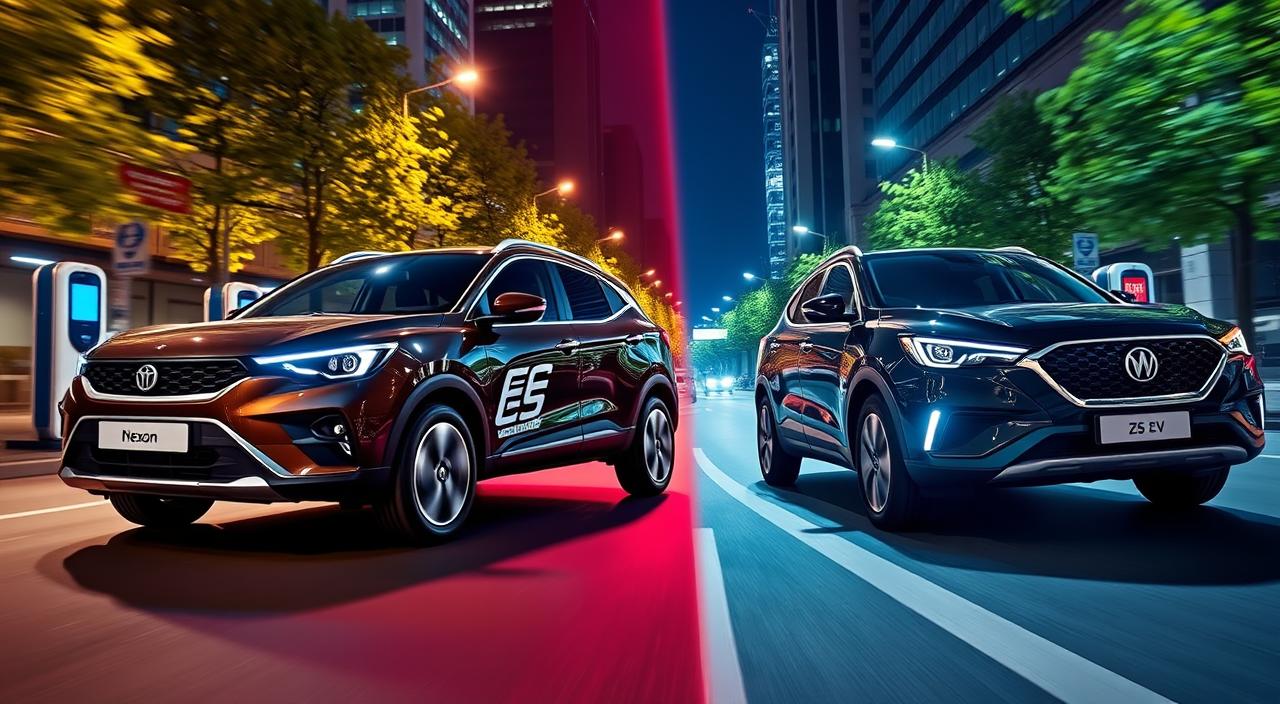
Jan
In India, over 90% of cars use fossil fuels. But electric vehicles (EVs) are quickly becoming popular. The Tata Nexon EV Max and the MG ZS EV are leading the charge. They offer great performance, long ranges, and advanced features. But which one is the best?
I’ve compared these two electric SUVs to find the best value for Indian buyers. I’ve tested them on the road and looked at their specs. The Tata Nexon EV got a big update in 2023, and the MG ZS EV is making waves. This comparison is going to be exciting.
The Tata Nexon EV can go from 10% to 80% in 56 minutes with a 50 kW charger. It has a range of 390 to 489 km. The MG ZS EV has a range of 461 km. Both EVs are very safe, with top safety ratings from Bharat NCAP and Euro NCAP.
Key Takeaways
- Tata Nexon EV Max and MG ZS EV are leading contenders in the Indian electric SUV market
- Tata Nexon EV offers a range of 390 to 489 km per charge, while MG ZS EV delivers 461 km
- Both EVs boast impressive safety ratings, with 5-star ratings from Bharat NCAP and Euro NCAP respectively
- Real-world performance, charging options, and advanced features are key factors in determining the superior EV
- This comparison aims to help Indian buyers choose between these two electric SUVs
Introduction to EVs and Their Importance
Electric vehicles (EVs) are changing the car world. They are cleaner and more efficient than gas cars. EVs help fight climate change and air pollution by using less fossil fuel.
Why Electric Vehicles Matter
EVs are good for the environment. They don’t pollute the air or contribute to climate change. This is key in cities where air quality is a big issue.
EVs also save money in the long run. They might cost more upfront, but they need less maintenance and electricity is cheaper than gas. As technology gets better, EVs will get cheaper, making them a smart choice for many.
The Growth of EV Popularity
More people are choosing EVs, thanks to government help and better charging spots. In India, the government offers tax breaks and subsidies. This makes EVs more affordable for many.
As more people buy EVs, there are more places to charge them. India is adding thousands of charging stations. This makes long trips in EVs easier and worry-free.
| EV Model | Battery Capacity (kWh) | Range (km) |
|---|---|---|
| Tata Nexon EV Max | 40.5 | 437 |
| MG ZS EV | 50.3 | 461 |
| Hyundai Kona Electric | 39.2 | 452 |
| Mahindra XUV400 EV | 39.5 | 456 |
| BYD Atto 3 | 60.5 | 521 |
The table shows some top EVs in India, with their battery sizes and ranges. The BYD Atto 3 has the longest range, great for long trips.
Overview of Tata Nexon EV Max
The Tata Nexon EV Max is a big leap in the Indian electric SUV market. It combines power, features, and design in a unique way. With its strong electric motor and big battery, it offers a thrilling drive and zero emissions.
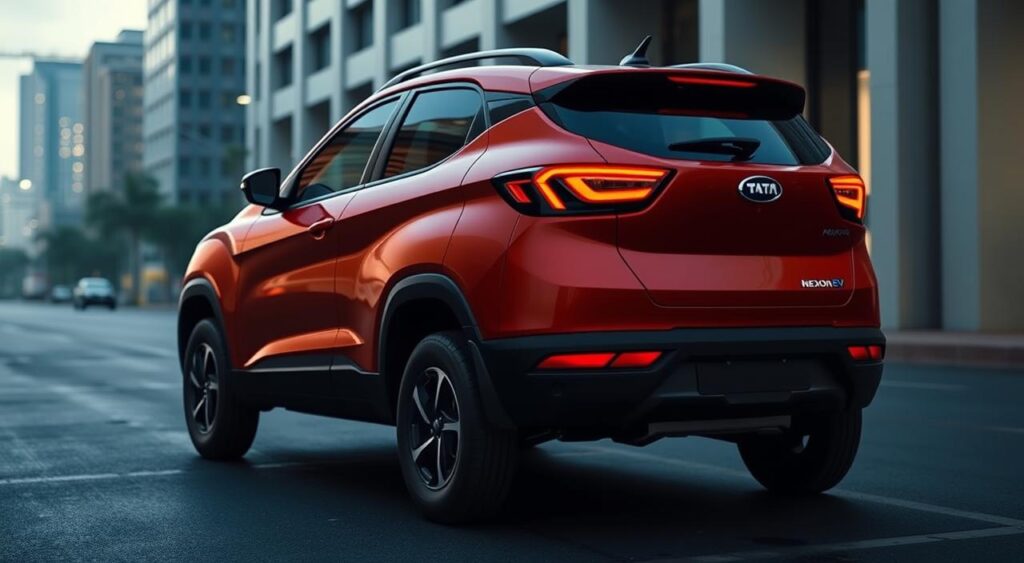
Key Specifications and Features
The Tata Nexon EV Max has a 40.5 kWh battery pack. It can go up to 437 km on a single charge, as certified by ARAI. The electric motor provides quick acceleration and smooth driving. It also comes with:
- 7-inch touchscreen infotainment system
- Automatic climate control
- Connected car technology
- Multiple driving modes
The Nexon EV Max is offered in two battery sizes: 30 kWh and 40.5 kWh. Prices start at Rs 12.49 Lakh and go up to Rs 17.19 Lakh (ex-showroom, New Delhi). It’s great for daily drives and weekend trips, with a real-world range of up to 300 km.
Design and Build Quality
The exterior design of the Tata Nexon EV Max is eye-catching. It has sleek lines and modern looks. The front grille, alloy wheels, and LED headlamps make it look premium. The Tata Avinya, built on JLR’s EMA platform, shows Tata Motors’ dedication to EVs.
Inside the Nexon EV Max, you’ll find a well-made interior. It’s filled with quality materials and has plenty of room for passengers. The seats are designed for comfort, making long drives easy.
| Parameter | Tata Nexon EV Max |
|---|---|
| Price Range | Rs 12.49 – 17.19 Lakh* |
| Range | 390 – 489 km |
| Battery Capacity | 40.5 – 46.08 kWh |
| Charging Time | 56 minutes (10% to 80%, 50kW charger) |
| User Rating | 4.4/5 (based on 168 reviews) |
Overview of MG ZS EV
The MG ZS EV is a sleek and modern electric SUV. It combines performance, comfort, and advanced features. Its striking exterior styling and spacious interior make for a great driving experience. It’s designed for the future of sustainable mobility.
Key Specifications and Features
The MG ZS EV has a 50.3 kWh battery and a claimed range of 461 km (ARAI). It has a powerful electric motor that produces 173 bhp and 280 Nm of torque. This makes for a responsive and dynamic drive.
The ZS EV also has a 5-star safety rating from Euro NCAP. This shows it’s safe and reliable.
| Specification | Value |
|---|---|
| Battery Capacity | 50.3 kWh |
| Claimed Range (ARAI) | 461 km |
| Real-World Range | 330 km (82.5% of claimed) |
| Power Output | 173 bhp |
| Torque | 280 Nm |
| Charging Time | 16 hours |
Design and Interior Comfort
The MG ZS EV’s interior space is well-designed. It offers ample room for passengers and many comfort features. The cabin features a 10.1-inch touchscreen infotainment system for easy connectivity.
The panoramic sunroof adds luxury, letting natural light in. This makes the interior bright and welcoming.
With a seating capacity of 5, the ZS EV is comfortable for everyone. Its dimensions balance interior space and maneuverability. It’s perfect for city drives and weekend trips.
Real-World Performance: Tata Nexon EV Max
The Tata Nexon EV Max is an electric SUV that promises an exciting drive. It has a strong electric motor and a well-tuned suspension. This makes it perform well in real-world driving.
Acceleration and Speed Tests
In acceleration tests, the Tata Nexon EV Max shows off its electric power. It goes from 0 to 100 kmph in just 8.75 seconds. This makes it one of the fastest in its class.
The electric motor’s instant torque gives a thrilling boost. This makes passing and merging onto highways easy.
To compare the Tata Nexon EV Max with its rival, the MG ZS EV, let’s look at their performance:
| Model | 0-100 kmph Time | Top Speed |
|---|---|---|
| Tata Nexon EV Max | 8.75 seconds | 140 kmph |
| MG ZS EV | 8.5 seconds | 140 kmph |
The table shows the Tata Nexon EV Max is close to the MG ZS EV in acceleration. This highlights its strong performance.
Handling and Ride Comfort
The Tata Nexon EV Max handles well, thanks to its well-designed chassis and suspension. It has precise steering and little body roll. This makes it confident on twisty roads or busy city streets.
The low center of gravity from the battery pack adds to its stability and cornering. This makes the Nexon EV Max a joy to drive.
The Nexon EV Max also balances comfort and sportiness well. Its suspension absorbs road bumps, giving a smooth ride. Even on rough roads, the cabin stays calm, ensuring a pleasant drive.
Here’s a comparison of the ride quality between the Tata Nexon EV Max and MG ZS EV:
| Model | Ride Comfort Rating |
|---|---|
| Tata Nexon EV Max | 4/5 |
| MG ZS EV | 3.5/5 |
The Tata Nexon EV Max has a slight edge in ride comfort. It offers a more composed and comfortable ride for passengers.
In summary, the Tata Nexon EV Max impresses with its real-world performance. It has quick acceleration, responsive handling, and a comfortable ride. Its well-rounded performance makes it a great choice for an electric SUV.
Real-World Performance: MG ZS EV
The MG ZS EV stands out in real-world performance. It offers a thrilling drive with fast acceleration, smooth handling, and a comfy ride.
The ZS EV’s quick start is a highlight. In acceleration tests, it hits 0-100 kmph in about 8.5 seconds. This speed comes from its strong electric motor, which produces 177 PS and 280 Nm of torque.
The MG ZS EV also excels in handling. It has precise steering and stable turns, making driving confident. The suspension balances sportiness and comfort, keeping the ZS EV steady on tough roads.
Ride Comfort and Noise Levels
The MG ZS EV is also great for comfort. Its cabin is well-insulated, reducing noise from the road and wind. The seats are plush, supporting you on long trips. The electric powertrain makes the ride smooth and quiet, adding to the comfort.
| Specification | Value |
|---|---|
| Year of Manufacture | 2022 |
| Kilometers Driven | 32,000 km |
| Real-World Range | 330 km |
| Battery Capacity | 50 kWh |
The MG ZS EV has a range of 330 km and a 50 kWh battery. It’s efficient, letting you go far on a single charge. This makes it perfect for daily drives and weekend trips.
Battery Capacity and Range: Tata Nexon EV Max
The Tata Nexon EV Max has a 40.5 kWh battery pack. It offers a great driving range for most electric vehicle owners. With one charge, it can go about 300-350 km. This depends on driving conditions, how you use it, and your driving style.
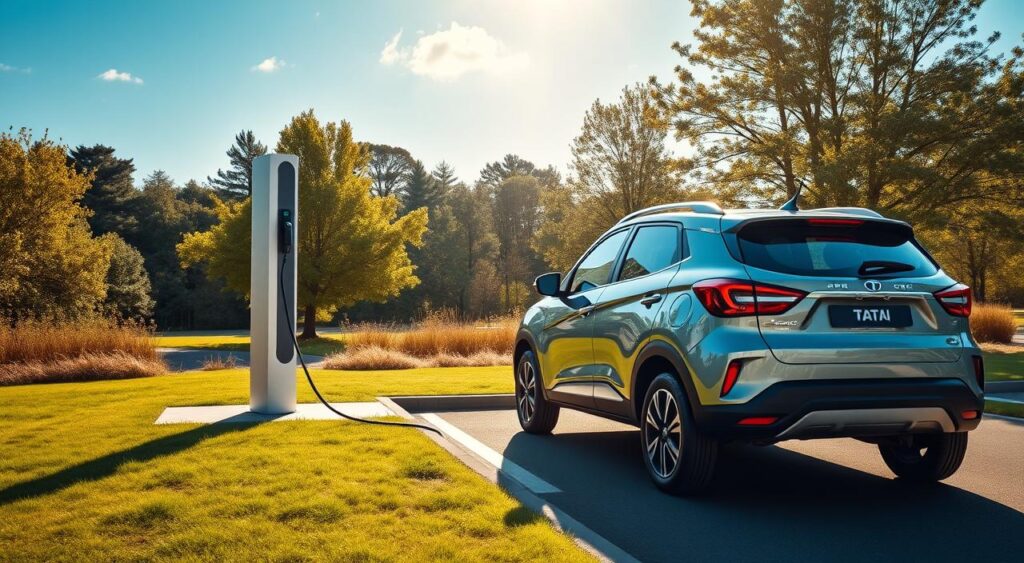
Real-World Driving Range
In real-world tests, the Tata Nexon EV Max has shown its reliability. A test in Mumbai showed it could go 356 km on about 91% of its battery. This makes buyers confident it can handle daily drives and occasional long trips without worry.
Charging Times and Options
The Tata Nexon EV Max has flexible charging options. It supports both regular and fast charging. With a 60 kW DC fast charger, it can go from 0-80% in about 40 minutes. This is faster than the previous LR variant.
| Charging Option | Charging Time |
|---|---|
| 60 kW DC Fast Charging | 0-80% in 40 minutes |
| 3.2 kW AC Charger | 17.5 hours |
| 7.2 kW AC Charger | 6.5 hours |
For home or office charging, the Nexon EV Max supports AC charging. A 3.2 kW AC charger takes about 17.5 hours to fully charge. A 7.2 kW AC charger does it in about 6.5 hours. This means you can start each day with a full battery.
Tata’s growing charging infrastructure in India makes owning a Nexon EV Max more convenient. With more charging stations, like those by BPCL, owners can plan trips knowing they can charge up along the way.
Battery Capacity and Range: MG ZS EV
The MG ZS EV has a big 50.3 kWh battery pack. This is bigger than many electric SUVs. It claims a range of 461 km on a single charge. But, real-world driving can change this, based on how you drive, the terrain, and the weather.
Real-World Driving Range
MG ZS EV owners say they get about 330 km in real life. They’ve driven a total of 32,000 km. This is about 18% less than the claimed range, due to various factors.
The MG ZS EV’s range is good compared to others. For example, the Tata Nexon EV Max has a range of about 360 km with a smaller battery.
Charging Infrastructure and Options
MG is working hard to add more charging spots in India for ZS EV owners. They offer a 7.4 kW AC fast charger. It can fill the battery from 0-100% in about 9 hours. For quicker charging, the ZS EV also supports 50 kW DC fast charging, which can charge to 80% in just 1 hour.
| Charging Option | Charging Time |
|---|---|
| 7.4 kW AC | 9 hours (0-100%) |
| 50 kW DC | 1 hour (0-80%) |
Most MG ZS EV owners charge at home, with 95% of charging done there. Only 5% use fast charging spots. This shows that most owners find the range good for daily use and only need fast charging for longer trips.
Comparing Driving Range in Urban vs. Highway Conditions
Electric vehicles are all about their driving range. The Tata Nexon EV Max and MG ZS EV are top picks in India. They each have their own strengths in city and highway driving.
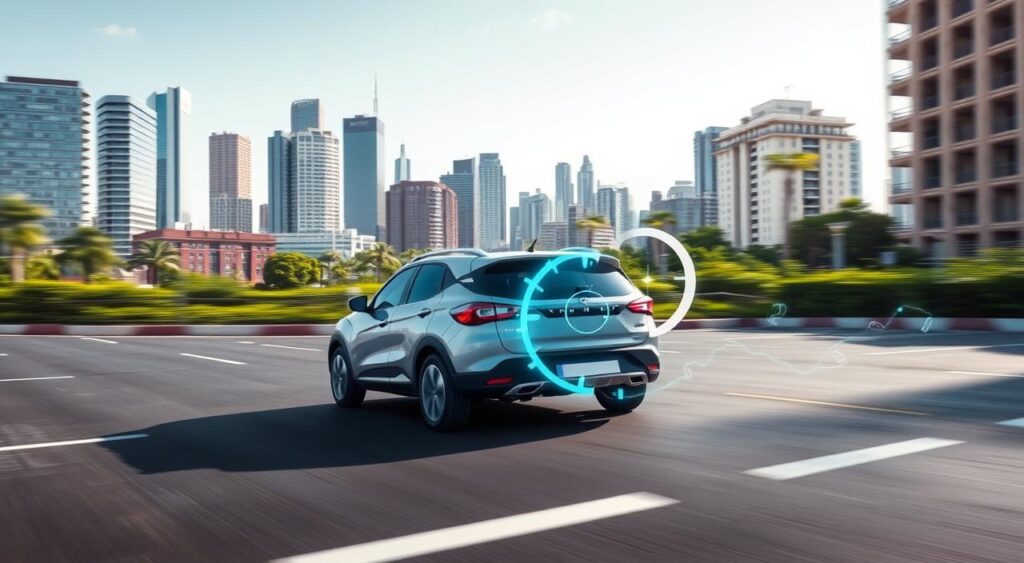
Tata Nexon EV Max in Urban Settings
The Tata Nexon EV Max is great for city driving. It has a powertrain and regenerative braking that save energy. This means it can go about 250-300 km on one charge, perfect for daily city trips.
It also has a regenerative braking system. This system captures energy when you slow down or brake. It’s perfect for city driving where you stop and start a lot.
The Nexon EV Max has a real-world range of 453 km. It has a 40.5 kWh battery and a motor that gives 143 PS of power and 250 Nm of torque. This makes driving smooth and fun.
MG ZS EV in Highway Conditions
The MG ZS EV is a powerhouse on highways. It has a big 50.3 kWh battery. This lets it go about 300-350 km on one charge, great for long trips.
Its motor is strong, with 176 PS of power and 280 Nm of torque. This makes highway driving confident and enjoyable. It can go up to 461 km on a single charge, perfect for long trips.
| EV Model | Urban Driving Range | Highway Driving Range |
|---|---|---|
| Tata Nexon EV Max | 250-300 km | – |
| MG ZS EV | – | 300-350 km |
Both the Tata Nexon EV Max and MG ZS EV have great ranges. The Nexon is best for city driving, while the ZS EV is great for highways. Your choice depends on your driving needs and preferences.
Practicality and Everyday Usability
Electric SUVs are great for daily use. The Tata Nexon EV Max and MG ZS EV have lots of room for cargo. They’re perfect for families or anyone needing a versatile car.
The Tata Nexon EV Max has a big 350-liter boot. It’s great for carrying luggage, groceries, and more. The MG ZS EV has even more space, with 448 liters, so you can store everything you need.
Getting in and out of these SUVs is easy. They have comfortable seats for everyone. The inside is designed for modern families, making driving a pleasure.
Comfort Features
Both SUVs focus on comfort for a smooth ride. They come with:
- Adjustable seats with lumbar support
- Automatic climate control
- Spacious and comfy rear seats
- Plenty of legroom and headroom
Comparing Cargo Space and Practicality
| Electric SUV | Boot Space (Liters) | Seating Capacity | Ground Clearance (mm) |
|---|---|---|---|
| Tata Nexon EV Max | 350 | 5 | 205 |
| MG ZS EV | 448 | 5 | 177 |
The table shows both SUVs have lots of space for cargo and passengers. The Tata Nexon EV Max has a bit more ground clearance. This helps when driving on rough roads.
In summary, the Tata Nexon EV Max and MG ZS EV are top picks for practical electric SUVs. They’re reliable and versatile, making them great for daily use.
Safety Ratings and Features
Both the Tata Nexon EV Max and MG ZS EV are leaders in Electric SUV safety. The Tata Nexon EV Max has a strong safety package. The MG ZS EV has received high marks in safety tests worldwide.
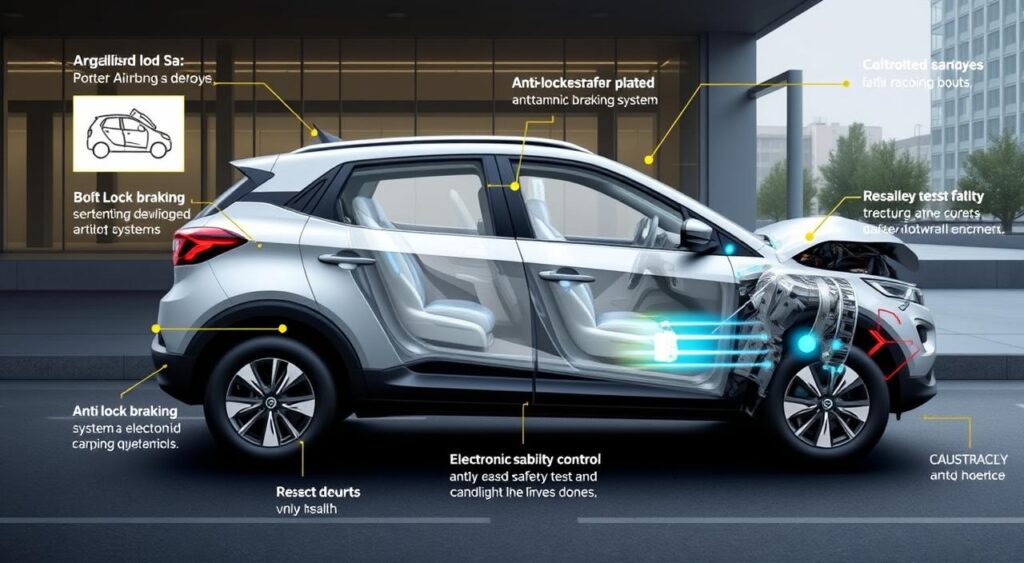
Tata Nexon EV Max Safety Features
The Tata Nexon EV Max focuses on keeping everyone safe. It comes with:
- Disc brakes on all wheels
- Electronic Stability Program (ESP)
- Traction Control
- Tire Pressure Monitoring System (TPMS)
- Electronic parking brake with auto hold
- Six airbags for all-around protection
These advanced driver assistance systems make driving safer and more confident. The Nexon EV Max’s solid build and safety design earn it a 5-star Global NCAP rating. This makes it a top choice for affordable diesel cars in India.
MG ZS EV Safety Ratings
The MG ZS EV also shines in safety tests, earning a 5-star Euro NCAP rating. It offers:
- Six airbags for complete occupant protection
- Hill start assist for smooth starts on hills
- Tire pressure monitoring system for safety and performance
- Adaptive cruise control for easy highway driving
- Lane keep assist to stay in the right lane
Its advanced safety features and strong build make the ZS EV a safe choice. It gives drivers and passengers confidence and peace of mind on every trip.
Owner Experiences: Real-World Feedback
Choosing an electric SUV? Real feedback from owners is key. It shows how these cars perform and work in everyday life. Let’s dive into what Tata Nexon EV Max and MG ZS EV owners say.
Tata Nexon EV Max Owners’ Testimonials
People love the Tata Nexon EV Max. They say it’s great to drive, both in the city and on the highway. Its range of about 360 km meets most daily needs.
One owner has driven 23,000 km. They mostly charge at home, using fast charging just 4 times. This shows how easy it is to charge at home. Another owner, with 25,000 km, says they get 290 km at 100 km/h on the highway. This proves the car’s efficiency.
MG ZS EV Owners’ Testimonials
MG ZS EV owners are happy too. They like the roomy interior and cool features like the panoramic sunroof. The car’s range of about 330 km is enough for most.
An owner with 32,000 km on their ZS EV uses it 50/50 for city and highway driving. They charge at home 95% of the time. They also praise the car’s safety, thanks to its 5-star Euro NCAP rating.
| Model | Average Real-World Range | ARAI / Manufacturer Claimed Range |
|---|---|---|
| MG ZS EV | 330 km | 400 km |
| Tata Nexon EV Max | 360 km | 453 km |
Both the MG ZS EV and Tata Nexon EV Max have great ranges. The Nexon EV Max has a slight edge. But, both are good for daily use. Your choice might depend on what you value most.
Final Verdict: Which EV Reigns Supreme?
After looking at the Tata Nexon EV Max and the MG ZS EV, we see both have good points and areas to improve. The Tata Nexon EV Max is a strong contender with its 143 PS power and 0-100 km/h in 9.14 seconds. It also has a 453 km range and uses 14.6 kWh/100 km, making it a cost-effective choice.
The MG ZS EV, on the other hand, has a 461 km range and a 44.5 kWh battery. It packs 150 PS and accelerates to 100 km/h in 8.5 seconds. Its large interior and 449 liters of boot space make it great for families or those needing more space.
Summary of Key Differences
Comparing the Tata Nexon EV Max and the MG ZS EV, we find some key differences. The Nexon EV Max starts at ₹14.74 lakh, while the ZS EV costs ₹23.38 lakh. The Nexon EV Max is more energy-efficient, using 14.6 kWh/100 km compared to the ZS EV’s 17 kWh/100 km. Yet, the ZS EV has a bigger battery and more room inside, which might sway some buyers.
Recommendations Based on Needs
The choice between the Tata Nexon EV Max and the MG ZS EV depends on what you value most and your budget. If you want a budget-friendly electric SUV with great performance, the Tata Nexon EV Max is a good pick. It’s priced lower and has high customer satisfaction.
But, if you need a longer range, faster speed, and more space, the MG ZS EV might be better, even if it costs more. Both electric SUVs are great options for those looking to go green and join the EV trend.
FAQ
How do the Tata Nexon EV Max and MG ZS EV compare in terms of real-world performance?
Both the Tata Nexon EV Max and MG ZS EV show great speed. The Nexon EV Max goes from 0-100 kmph in 8.75 seconds. The ZS EV does it in about 8.5 seconds. They both handle well and are comfortable to drive, making them great for city and highway use.
What is the real-world driving range of the Tata Nexon EV Max and MG ZS EV?
The Tata Nexon EV Max has a range of 300-350 km on a single charge. It has a 40.5 kWh battery pack. The MG ZS EV, with a 50.3 kWh battery, has a range of 350-400 km. This depends on how you drive and your usage.
How do the charging options and times compare for the Tata Nexon EV Max and MG ZS EV?
The Tata Nexon EV Max can charge fast or regular. A 0-80% fast charge takes 60 minutes with a DC fast charger. The MG ZS EV can charge to 100% in 6-8 hours with a 7.4 kW AC fast charger. Both brands are adding more charging spots in India for EV owners.
Which electric SUV offers more cargo space and practical storage solutions?
Both SUVs have lots of space and smart storage. The Nexon EV Max has a 350-liter boot. The ZS EV has 448 liters of cargo space. They both have comfy interiors and easy access.
How do the Tata Nexon EV Max and MG ZS EV fare in terms of safety features and ratings?
The Tata Nexon EV Max has safety features like dual airbags and ABS. The MG ZS EV got a 5-star safety rating from Euro NCAP. It has six airbags and other safety features.
What are the experiences of Tata Nexon EV Max and MG ZS EV owners in the real world?
Tata Nexon EV Max owners love its performance and comfort. MG ZS EV owners like its space and features. Both groups are happy with their electric cars.
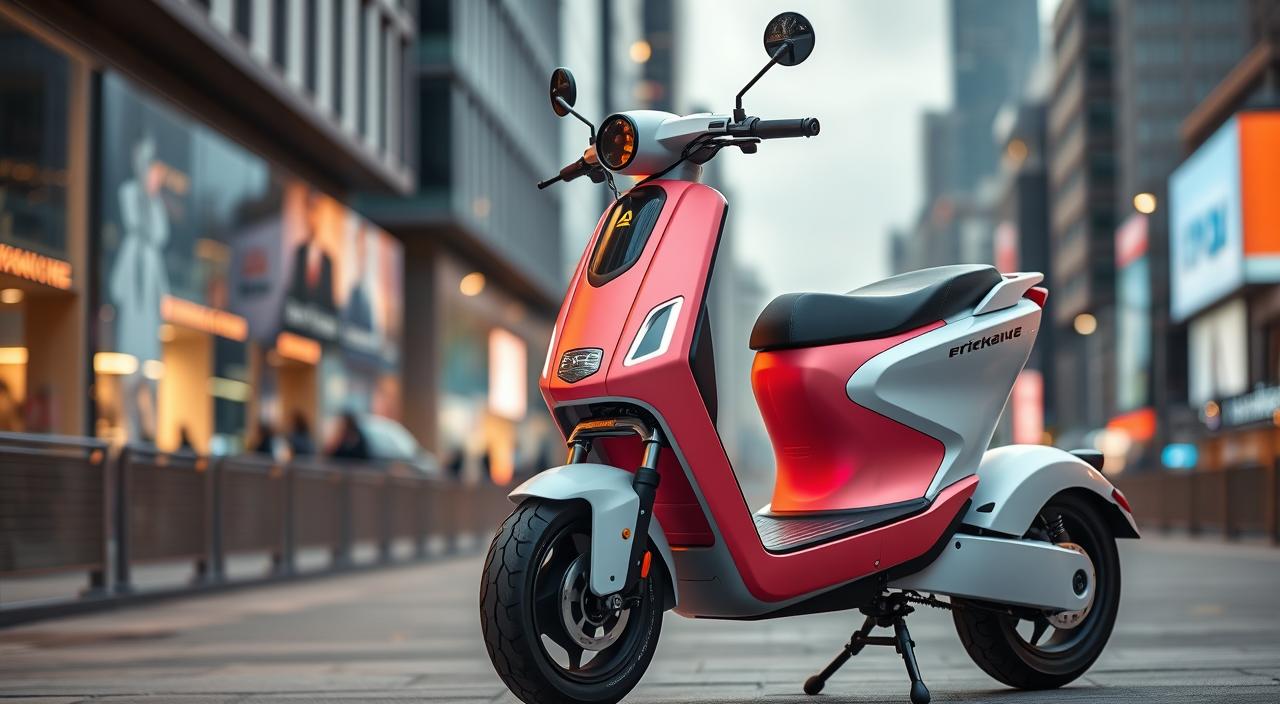
Jan
The OLA Gig+ electric scooter is a game-changer in the market. It’s priced at ₹49,999, making it perfect for those in the gig economy and looking for affordable transport. It’s designed for side hustles and flexible jobs.
The electric scooter market saw a 17.64% drop in sales last December. Yet, OLA Electric sold 13,771 units, a 54.80% drop from the year before. Still, they’re hopeful about the Gig+ model. It has a range of 157 km and a 1.5 kW motor, great for extra income from remote work and delivery.
The OLA Gig+ is one of seven models from OLA Electric. Prices range from ₹39,999 to ₹1.35 lakh. The Gig+ is a great deal, offering both performance and affordability.
Key Takeaways:
- OLA Gig+ is priced at ₹49,999, targeting gig economy workers and cost-conscious consumers
- 157 km range per charge and 1.5 kW motor power make it suitable for side hustles and flexible jobs
- Part of OLA Electric’s lineup of seven models, with prices ranging from ₹39,999 to ₹1.35 lakh
- Weighted average price of OLA Electric scooters is approximately ₹64,999
- Aims to compete with shared mobility providers like Yulu Bikes, often preferred by delivery partners
Introduction to OLA Gig+ Electric Scooter
OLA Electric has introduced the OLA Gig+ electric scooter. It’s made for gig economy workers and urban commuters. This scooter is an affordable, eco-friendly option for those in India’s busy cities.
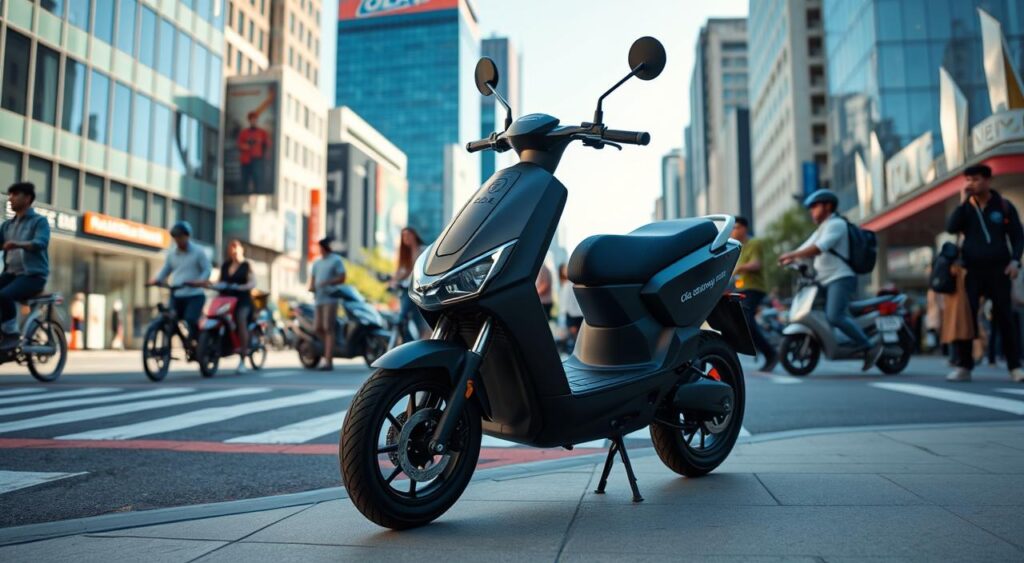
Overview of OLA Electric’s New Offering
The OLA Gig+ electric scooter can go 81 km on one battery and 157 km on two. It’s powered by a 1.5 kW motor, reaching 45 km/h. This makes it perfect for long city trips.
It has removable 1.5 kWh batteries for easy charging. Starting at ₹49,999 in Delhi, it’s a great deal compared to others.
| Feature | OLA Gig+ |
|---|---|
| Range | 81-157 km per charge |
| Battery Capacity | 3 kWh |
| Top Speed | 45 km/h |
| Motor Power | 1.5 kW |
| Ex-showroom Price in Delhi | ₹49,999 |
Target Audience and Market Positioning
The OLA Gig+ is made for gig economy workers and urban commuters. It’s priced well and performs great. This scooter makes electric vehicles more appealing for India’s growing gig economy.
It offers a reliable, affordable way to travel. This helps people start their own businesses and helps the environment too.
Design and Build Quality
The OLA Gig+ Electric Scooter has a sleek and modern design. It fits perfectly with OLA’s style. Its look is both contemporary and stylish, making it great for those who want both looks and function.
The OLA Gig+ features portable battery packs. This design is a hit in other OLA models. It makes the scooter easy to carry and extends its range. The OLA PowerPod, priced at Rs 9,999, powers the scooter. It also works as an inverter, letting users charge small appliances up to 500W.

The scooter is made with top-notch materials. This ensures it lasts long and is durable. Its frame can handle daily use well. The scooter’s build shows attention to detail, making it a quality product.
Ergonomics and Comfort Features
The OLA Gig+ focuses on comfort. It has ergonomic design for a better ride. The seat is cushioned, offering support and reducing fatigue on long rides. The handlebars are at a comfortable height for easy grip.
Here’s a comparison with the OLA Electric S1 Pro:
| Specification | OLA Gig+ | OLA Electric S1 Pro |
|---|---|---|
| Range | Up to 112 km/charge | Up to 195 km/charge |
| Top Speed | 25 km/h | 120 km/h |
| Price (ex-showroom Delhi) | Rs 39,999 | Rs 134,999 |
| User Review Score | 3.3 out of 5 | 3.9 out of 5 |
The OLA Electric S1 Pro has better performance and more features. But the OLA Gig+ is a budget-friendly choice. It’s perfect for gig workers and those looking for a green, efficient ride.
Performance and Range
The OLA Gig+ Electric Scooter is designed for top performance and long range. It’s perfect for gig workers and city commuters. Its powerful motor and advanced battery make city travel easier.
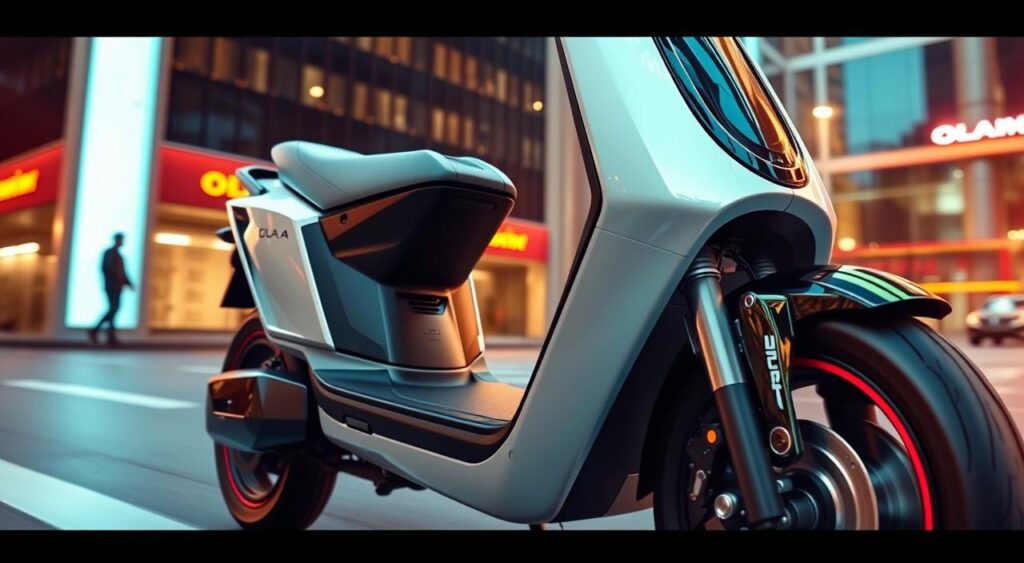
Motor Specifications and Power Output
The OLA Gig+ has a 1.5 kW motor for fast speeds up to 45 kmph. This powerful motor gives a smooth ride, even uphill or with heavy loads. The base model OLA Gig has a 250 W motor for 25 kmph.
Top Speed and Acceleration
The OLA Gig+ reaches 45 kmph, one of the fastest in its class. Its quick acceleration helps riders move through traffic easily. This means you can get to your destination fast.
Battery Capacity and Charging Time
The OLA Gig+ has a single or dual 1.5 kWh battery, up to 3 kWh total. Its fast charging means it’s ready in hours. The battery is removable for easy charging at home or work.
Real-World Range Testing
In real use, the OLA Gig+ goes up to 157 km on a single charge with dual batteries. It’s great for daily commutes and long trips. The base model OLA Gig has a range of 112 km, good for city rides. Its design and braking system also help its range.
| Model | Battery Capacity | Range | Top Speed | Motor Power |
|---|---|---|---|---|
| OLA Gig | 1.5 kWh | 112 km | 25 kmph | 250 W |
| OLA Gig+ (Single Battery) | 1.5 kWh | 81 km | 45 kmph | 1.5 kW |
| OLA Gig+ (Dual Battery) | 3 kWh | 157 km | 45 kmph | 1.5 kW |
The OLA Gig+ Electric Scooter has a powerful motor, fast charging, and long range. It’s a top choice for gig workers and those who care about the environment.
Features and Technology
The OLA Gig+ Electric Scooter is changing the game for gig workers. It comes with top-notch features and the latest tech. Thanks to MoveOS, riding is smooth and connected.
Smart Connectivity and Mobile App Integration
Stay connected with the OLA Gig+ smart features. It links up with the OLA app on your phone. You can check battery levels and track your rides easily.
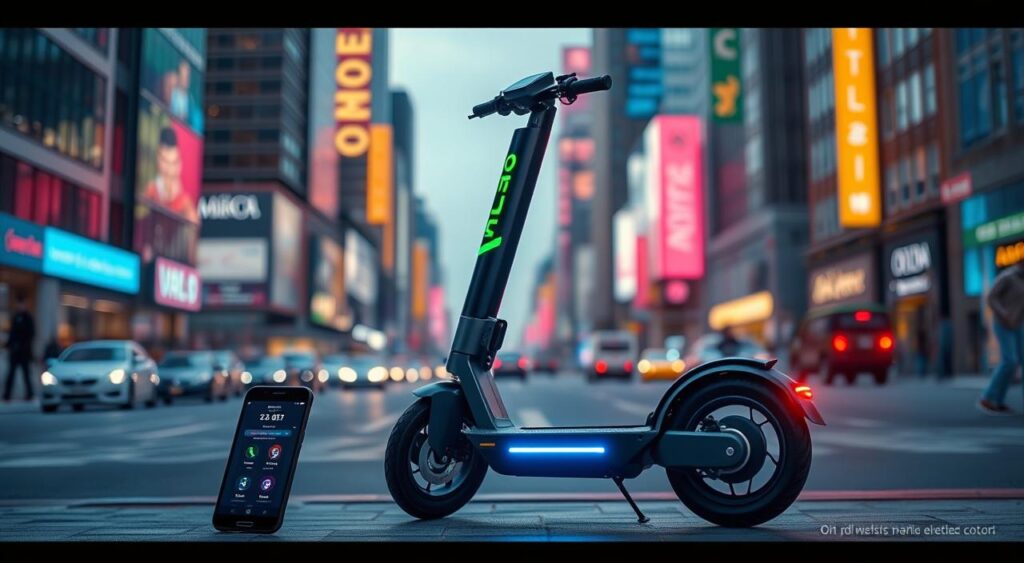
Advanced Safety Features
Safety is key, and the OLA Gig+ delivers. It has advanced safety tech for a safe ride. You get smart braking and real-time checks for your safety.
Regenerative Braking and Energy Recovery
The OLA Gig+ boosts efficiency with regenerative braking. It turns braking into electricity, saving energy and extending your ride. This smart tech also cuts down on carbon emissions.
| Feature | Benefit |
|---|---|
| MoveOS Technology | Enhanced riding experience |
| Mobile App Integration | Seamless connectivity and control |
| Advanced Safety Features | Secure and reliable rides |
| Regenerative Braking | Energy recovery and extended range |
The OLA Gig+ Electric Scooter is changing urban mobility for gig workers. It brings the future of city travel with its smart tech.
OLA Gig+ Electric Scooter: Value for Money
The OLA Gig+ Electric Scooter is a budget-friendly EV that combines affordability with great performance. It starts at ₹39,999 to ₹49,999, aiming to be a big player in India’s electric scooter market.
This scooter can go up to 45 km/h and travel 81 km on one battery. With two 1.5 kWh batteries, it can go up to 157 km. These competitive features make it perfect for daily rides and work in the gig economy.
Pricing and Variants
The OLA Gig+ Electric Scooter comes in two versions. Here are the prices in Pune:
| Variant | Price |
|---|---|
| OLA Gig | ₹33,906 onwards |
| OLA Gig+ | ₹45,579 |
The Gig+ also has an EMI option starting at ₹1,564 per month. You need to pay ₹2,279 down and get a 10% interest rate for 3 years. This affordable pricing helps you buy an electric scooter without spending too much.
Comparison with Competitors
The OLA Gig+ is unique because it’s both affordable and powerful. Here’s how it compares to other scooters in Pune:
- Ampere Reo Li Plus: ₹64,323 onwards
- OLA S1 Z: ₹55,752 onwards
- Lectrix SX25: ₹63,041 onwards
- Yo Edge: ₹52,000 onwards
The OLA Gig+ is cheaper than most but offers similar or better features. It’s a great choice for those watching their budget.
Cost-Effectiveness for Gig Economy Workers
The OLA Gig+ is perfect for gig economy workers like delivery folks and ride-hailers. Its affordable pricing and low costs mean they can earn more. The scooter’s long range with two batteries means they can travel far without needing to charge often. This boosts their productivity and earnings.
Conclusion
The OLA Gig+ electric scooter is a standout in OLA Electric’s lineup. It meets the needs of gig workers and those on a budget. Its sleek design, advanced tech, and great performance make it a game-changer in India’s affordable EV market.
At ₹49,999, the OLA Gig+ is a great deal. It can go up to 45 km/h and travel 157 km on a single charge. The OLA Gig, starting at ₹39,999, is even more budget-friendly. It’s perfect for those who want to save money without sacrificing too much.
As OLA Electric grows its service network and invests in R&D, the Gig+ is set to make a big impact. They plan to launch 20 new products in the next two years. This shows OLA’s dedication to making sustainable transport more accessible in India.
In short, the OLA Gig+ electric scooter is a smart choice for those looking for an eco-friendly, cost-effective ride. As electric mobility gains popularity, the Gig+ will be key in shaping India’s future of personal transport.
FAQ
What is the OLA Gig+ electric scooter?
The OLA Gig+ is a new electric scooter for gig workers and those on a budget in India. It’s made to compete with shared mobility services. It’s an affordable, green way to get around.
What are the variants and pricing of the OLA Gig+?
The OLA Gig+ comes in two types – Gig and Gig+. Prices start at Rs 39,999 and go up to Rs 49,999. The Gig is for businesses and rentals, while the Gig+ is for longer trips and heavier loads.
What is the range and top speed of the OLA Gig+?
The OLA Gig can go 112 km on one charge, reaching 25 km/h. The Gig+ goes up to 45 km/h and 81 km on a single charge. It’s thought to have a range of 100-120 km.
What are the key features of the OLA Gig+?
The OLA Gig+ has a sleek design and portable batteries. It uses OLA’s MoveOS for a better ride. It also has smart tech, app integration, safety features, and regenerative braking.
How does the OLA Gig+ compare to other electric scooters in the market?
The OLA Gig+ is priced well and packed with features. It’s a great choice for commuters and gig workers. It aims to be a top pick in India’s affordable electric scooter market.
When will the OLA Gig+ be available for purchase?
You can now book the OLA Gig+. Deliveries start in April 2025.
Is the OLA Gig+ suitable for freelancers and remote workers?
Yes, the OLA Gig+ is perfect for freelancers and remote workers. It’s affordable, eco-friendly, and has great range. It’s a smart choice for those with flexible jobs and side hustles.
